Australian
and international
exploratory
performance and
media arts
Read reviews of works in Dance Massive from the RealTime archive.
the unbearable lightness of unconsciousness
keith gallasch: force majeure, not in a million years
reflections on self and body
pauline manley: narelle benjamin, in glass, chunky move, faker, spring dance 2010
work world upside down
pauline manley: branch nebula, sweat
responsive objects
philipa rothfield, shaun mcleod, the weight of the thing left its mark
measuring up & mining the moment
philipa rothfield: luke george, now, now, now
amplification, philip adams
philippa rothfield
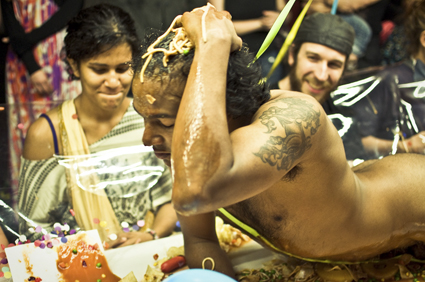
Ahil Ratnamohan, Sweat, Branch Nebula
photo Heidrun Löhr
Ahil Ratnamohan, Sweat, Branch Nebula
DANCE MASSIVE IS AVOIDING THE F-WORD. ACROSS ITS PRINT AND PUBLICITY, THE BIENNIAL PRESENTATION OF A CONCENTRATION OF CONTEMPORARY DANCE IN MELBOURNE IS CALLING ITSELF A “COLLECTION.” A “PROGRAM,” AN “INITIATIVE.”
To discuss “the Massive” I met with Steven Richardson, Director of Arts House in Melbourne. Richardson was instrumental in founding Dance Massive, urging the Australia Council following his time on the Dance Board to consider a concentration of dance programming both to attract international attention to new work and to provide a place for the sector to meet and share experiences at a national level. Arts House, a complex of venues run by City of Melbourne, plays a central coordinating role for the Dance Massive program, although Richardson admits that, “surrendering half of our six month program to make this work is not ideal.”
Without an artistic director for Dance Massive, Richardson tells me, there is no festival infrastructure and all programming is supported by existing State and Federal resources allocated to the three Melbourne venues where the work is presented. “There hasn’t been the funding to create a central framework. When the idea first came up, we considered trying to create a national program by coordinating venues around the country. It quickly became apparent that this was going to be impossible. It would take 15 years for us to find the same two weeks across every dance venue nationally. So we decided to start in our own backyard.”
The coincidence of Malthouse Director Michael Kantor and producer Stephen Armstrong investing in contemporary dance and physical theatre programming and the energy of David Tyndall as the new(ish) Director of Dancehouse created sufficient momentum in Melbourne for the project to take off in 2009. “It’s hard to apologise for the focus on Melbourne,” Richardson says, “There is arguably the healthiest ecology for dance here, with a concentration of institutions, companies like Chunky Move and lots of independent artists and audiences.”
In its first edition Dance Massive programmed 14 works from across Australia across the three venues. The program was well attended and received positive feedback and critical acclaim. Dance Massive was also pronounced a success for the way in which it raised the profile of dance in the media and created a meeting point for artists and companies to see each others’ work and network during a concentrated period. The same venues have joined to create Dance Massive 2011, and several of those artists included in the original program are making a return appearance. “We each have our own curatorial framework, our own audiences and remits regarding programming,” says Richardson. “but there has been some very interesting cross-fertilisation between the venues since the first Massive,” he adds. “There has been surprisingly little tripping over each other too; we are all interested in contemporary work, but our curatorial approaches are slightly different and we have worked hard to ensure that the work falls where it needs to fall.”
Richardson is referring to the fact that the program is broad, both in terms of its definition of dance (including a physical theatre company such as Branch Nebula), its inclusion of generations of makers, (from Trevor Patrick to Luke George) and its accessibility (from the popular dance theatre work of Force Majeure and Shaun Parker to the relatively obscure independent work of Deanne Butterworth and Matthew Day).
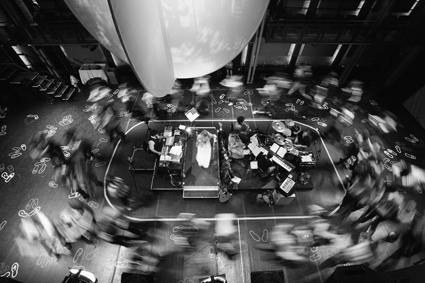
Dance Marathon, bluemouth inc
photo Gordon Hawkins
Dance Marathon, bluemouth inc
Whilst the first Massive included only Australians, there are artists from the UK and Canada in the 2011 program. “The international work is directly linked to Australian artists,” Richardson explains. “The bluemouth piece from Canada, Dance Marathon, is populated by local artists because it is built upon local participation. It was an important agenda item for Arts House to include a participatory element this year and the Dance Marathon project has been receiving incredible reviews wherever it plays around the world.” On the other hand, Billy Cowie, from the UK, has made his piece around an extraordinary Australian performer.
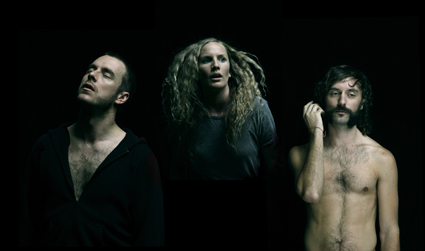
Now, Now, Now, Luke George
photo Jeff Busby
Now, Now, Now, Luke George
Richardson acknowledges that certain States and Territories are not represented in the final program but is adamant that Dance Massive is curated through the call for applications combined with the practical resources of the venues involved. “We would need a lot more money to support more companies to travel from interstate.” Richardson is aware of the absence of Indigenous work in the program. “It is not missing through any lack of trying,” he states,” The call is a rather brutal process, which can only consider the work that is out there and ready to go at the right time. Although we did get over sixty applications from the call this year, we also went out to our networks as presenters in order to find the best possible work.”
Richardson goes on to talk about the National Dance Forum associated with Dance Massive as a place where conversations around Indigenous and regional work can take place. “We have been able to include more spaces-in-between this year,” he says and cites the two international residencies and the dance on film program as initiatives that seek to address the aspiration of all three venues to create a place where dance artists and enthusiasts can meet. The National Dance Forum, led by Ausdance and the Australia Council and taking place over a long weekend during Dance Massive, will involve international choreographers such as Pichet Klunchen from Thailand with national dance artists in a series of forums, conversations and provocations designed to inspire art form development, in a similar fashion to that achieved during the National Theatre Forum in 2010.
Arts House will host the 2011 Tanja Liedtke Foundation Fellow, Katarzyna Sitarz, during Dance Massive. Sitarz will direct a residency at Arts House that will involve local independent artists and will take part in a new collaborative project directed by Lucy Guerin. Also during Dance Massive, the Australia Council’s IETM program, directed by David Pledger in Brussels, will send Norwegian choreographer Heine Avdal of deepblue company to undertake a residency and build relationships with Australian dance artists.
The venues and companies worked together to create a hit list of international presenters to invite to Dance Massive. Around a dozen high profile programmers from Europe, Asia and the US will attend. Dancehouse will also target a handful of French presenters in a special initiative. “It is important for the work to be shown in full, in the best possible theatrical conditions,’ Richardson says. “We also try to attract national and regional presenters,” he continues, “Although that is never easy. Last time we had half a dozen regional presenters attend and this year we hope for more.”
Richardson is optimistic about the impact of the 2011 program and is particularly looking forward to the two new productions by Chunky Move as well as the site-specific presentation, Drift, by Anthony Hamilton and the sound installation by composers Madeleine Flynn and Tim Humphrey. “I am hoping some of these projects will turn a few heads about what the nature of dance engagement can be,” he says.
Despite his enthusiasm, Steven Richardson is sanguine about the future of Dance Massive with no illusions about the third edition planned for 2013 being a shoo-in. “Once we get through March, we will start thinking about what we want Dance Massive to be,” he says. “Perhaps there is another model out there; something more nimble or more relevant to current practice.” Dance Massive is not a festival, or a showcase, that much is clear, but what it is and what it could be, seems to be tantalisingly up for grabs.
Throughout Dance Massive, RealTime reviews and interviews will appear online at www.realtimearts.net.
The considerable Dance Massive program includes works by Chunky Move, The Shaun Parker Project, Narelle Benjamin, Michelle Heaven, Helen Herbertson, Balletlab, Deanne Butterworth, Matthew Day, Antony Hamilton, Force Majeure, Trevor Patrick, Luke George, Branch Nebula, overseas guests Billy Cowie, John Jasperse Company and bluemouth inc, and the welcome return to Australia from France of Rosalind Crisp and Andrew Morrish.
–
Dance Massive: partners Arts House, Malthouse Theatre, Dancehouse; Melbourne, March 15-27; download the program at www.dancemassive.com.au
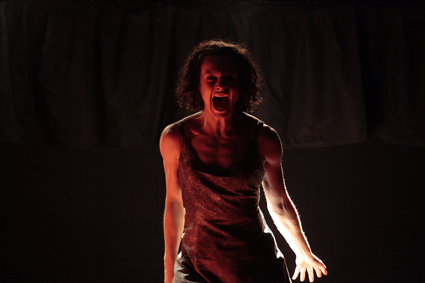
Carlee Mellow, Expectation
photo Rachel Roberts
Carlee Mellow, Expectation
WOMAN TEETERS IN THE DISTANCE, A GIANT PUMPKIN FOR A HEAD. SHE CUTS A SURREAL FIGURE. SHE IS IN HEELS, SKITTERING ACROSS A SMALL PROSCENIUM ARCH STAGE. VEERING FROM SIDE TO SIDE, SEEKING EQUILIBRIUM, THE WOMAN-VEGETABLE FAILS TO SETTLE, FAILS TO ACHIEVE STASIS. SHE ABANDONS THE TASK, SQUIRRELING ALONG TOWARDS THE DISTANT AUDIENCE. THE PROSCENIUM ARCH OFFERS A TALE, OF WOMAN AS OBJECT, AS HYBRID, BUFFETED BY ELEMENTS BEYOND HER CONTROL.
She is so far away that we watch almost dispassionately. The frame in a distance flattens. When she leaves, she becomes more real, a body rather than an image. No longer part vegetable, she comes towards us, moving to a melange of rhythms. She draws upon a history of dance training, pulling out moves and stringing them along a line. Inexorably, she approaches. As she nears, her body becomes round, flesh, soft. She dances nearer and nearer until her face becomes a player. Emotions, affects and intensities flicker then pass. Not exactly real but not quite surreal either, like switching stations on the radio.
Facing the audience, she emits a string of sounds. We are close now. The music is part of all this somehow. It matches the shifts, the proximities, the intensities, the progress. It seems we are at a peak. Clothes come off. Her naked body speaks, of dancing; muscular, buff. Even nudity tells a story. When the performers in the musical Hair stripped off, their nudity made a statement. Mellow’s nakedness emerges after a slew of expletives, like a full stop.
From a linear point of view, thus far the gaze of the audience has been increasingly enhanced by the tactile approach of a body. The volume of its flesh has been continuously increasing. Beginning as a distant figure, a subject-object, she is now more assertive, an intensity making decisions rather than a thing that responds.
The next phase is more twisted. She finds clothes and pursues a duet with a rope, melding and folding in movement. She traces a retreat to the rear of the theatre space, threading her way towards an ultimate inversion. She hangs upside down, like the Hanged Man of the Tarot pack. Technically and traditionally, the Hanged Man represents submission. Not submission as annihilation but giving up something to achieve something else. A creation through reversal, perhaps.
While Expectation follows a linear pathway of increasing revelation, it also reverts into a twisted transformation. Perhaps nothing is revealed. Is something expressed? Mmm. What I perceive is a powerful commitment, an intensity of feeling, a modulation of theatrical effect and an episodic movement through phases. The cavernous Arts House space has been treated to good effect, creating frames and scenarios that make this piece feel like more than a solo work. The shifting occupation of its massive depth—far, near, high, low and diagonally—cuts back from any linear sense of progress. We are rather treated to a series of differences that vary in intensity. Mellow exudes a performative strength that seems to heighten as she comes nearer. Perhaps her own energy becomes more directed toward the observer when she vocalises and strips or perhaps the observer reciprocates something in response.
Expectation follows Carlee Mellow’s performance in Deborah Hay’s solo project, In the Dark (RT98, p22). It resonates with Hay’s attitude towards performative attention. Its theatrical tenor also suggests Margaret Cameron’s dramaturgical influence—whimsical, surreal, with a strong performative focus. Since Hay’s work is about performance quality rather than any physical look, the movement belongs to Mellow. There is a trace of Ros Warby too. Mellow’s weird soundings reminded me of Warby’s vocalisations when performing Hay’s work, as if both women were abducted by the same aliens.
My enduring impression of Expectation is a sense of delight at Carlee Mellow’s courage and commitment. There is a freshness in this work; a degree of structure but also an aliveness that left me alert. Perhaps this piece is not alone in its concern to achieve something in the moment, to connect with its audience, but it does so in its own way.
Arts House, Future Tense: Expectation, choreographer, performer Carlee Mellow, composer Kelly Ryall, design Bluebottle, dramaturgical consultant Margaret Cameron, Arts House, North Melbourne Town Hall, Nov 9-14, 2010
RealTime issue #101 Feb-March 2011 pg. 41
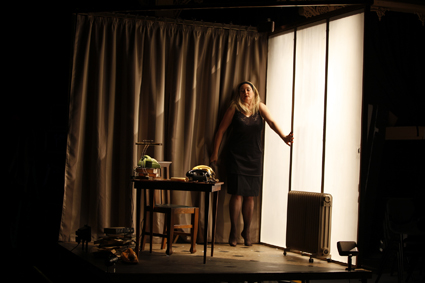
Leisa Shelton, Irony is Not Enough: Essay on My Life as Catherine Deneuve, Fragment31
photo Ponch Hawkes
Leisa Shelton, Irony is Not Enough: Essay on My Life as Catherine Deneuve, Fragment31
THE LAST TWO PERFORMANCES IN THE ARTS HOUSE FUTURE TENSE SEASON, BY MELBOURNE’S FRAGMENT31 AND THE GERMAN-ISRAELI TEAM JOCHEN ROLLER AND SAAR MAGAL, SHARE DOUBLE FOCI: IRONY AND TRAUMA.
Fragment31’s Irony is Not Enough: Essay on My Life as Catherine Deneuve performance is a theatrical rendition of Anne Carson’s poem of the same title, which turns the poet into a third-person Deneuve, and narrates her infatuation with a female student through the doubly ironic prism of cinema and classical references. What would Socrates say, she wonders, her words laced with mature, weary detachment. Deneuve, the cinematic Barbie doll, effortlessly blank, is inserted in the place of a complex self. (In The Guardian, December 30, 2006, Germaine Greer remarked that so devoid of personality have Deneuve’s roles been, that she cannot recall a single line any of her characters ever uttered.)
Fragment31 play with the representation of the fractured desiring self by simulating film. Shelton/Carson/Deneuve walks to the Metro; receives a phone call in her office; waits in a hotel room. Each scene is sculpted in filmic detail, each physically and narratively disconnected from the other, each floating as an island of naturalistic imagery in the mangle of props and wires of the Meat Market stage space. Sound, light, set, actors and musician, and designers, onstage too, come together in fitful fragments—the coalescing of the desiring, decentred self into one sharpened and fuelled by love. Even the narrator, Carson/Deneuve, is played by two actors: Leisa Shelton for body, Luke Mullins for voice. It is an attempt to discipline desire with a muffle of irony, dissimulation. But irony is not enough to stop infatuation; self-knowledge does not mandate control. Desire shows through. The poem crackles; the stage version, murkier and not as focused, less so.
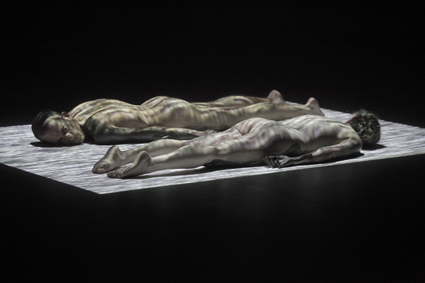
Jochen Roller, Saar Magal, Basically I Don’t But Actually I Do
photo Friedemann Simon
Jochen Roller, Saar Magal, Basically I Don’t But Actually I Do
If in the first work irony is employed as the girdle of trauma, to keep the fractured self in one piece, in the next work irony is a safe, fenced pathway to the exploration of trauma. Basically I Don’t But Actually I Do is Israeli choreographer Saar Magal’s answer to a question: whether to make a work about the Holocaust with friend German Jochen Roller or, rather, not about the Holocaust at all, but third generation Israelis and Germans.
It opens with a discussion over the order of epithets—which layer of identity comes first? They agree: German Jew, black Jewish German, even gay German black Jew; but, says Magal, “we’re not going to talk about Palestine.” Magal and Roller change clothes, from the yellow of the Star of David to the brown of the SS uniform, and back. They play Holocaust testimonies on tape. They enact a series of iconic WWII photos: Magal collapsing into Roller’s arms, Roller shooting Magal, vice versa. Magal says, “This man stole a book from a Tel Aviv bookshop!” And Roller recites, “I don’t remember. Everyone was doing it. I was simply there.”
We are asked to take our shoes off, walk, sit and, later, to get up. We don’t understand. “Aufstehen!” shouts Roller. Some of us are randomly marked out, and one person pulled out of the crowd, to dance briefly with Magal, and then sent back. The show creates small moments of terror: we are dislodged from our audience complacency, but nothing bad ever happens, because it’s not that kind of show.
Basically I Don’t But Actually I Do is a catalogue of images enacted, repeated, but only as traces. It assumes a traumatised audience, for which every hint will be a trigger of memory. But, remarkably, it is a work that refuses to create false memories. It tests recognition; it has exactly as much content as the audience brings to it. It is up to each person to see genocide in the stage imagery, hear the Nuremberg Trials in the dialogue. The piece gently probes. How much do we still remember? What does it mean to us? What does it do to us?
In Australia (as opposed to Germany or Israel), the answer is not much. There were some walk-outs, which I cannot imagine happening at a Holocaust tear-jerker (for reasons of decorum). But for those to whom it meant something, Magal and Roller created a tasteful, careful little memorial space, in which a past event was reconnected to the present, and the relationship between the two weighed up.
One could say that the risks in Basically…never felt sufficiently dangerous, the stakes never high enough to justify the pussyfooting (one German critic called it “politically correct”). The love woes of Deneuve/Carson are saturated with much greater danger, despite the ironic title. However, Basically…uses irony differently, as a way of coming closer to something unspeakable, rather than pulling away from it. If traumatic desire is a sore one still wants to pick, the Holocaust is a trauma of a completely other kind, one to tiptoe around carefully, holding hands.
Fragment31, Irony is Not Enough: Essay on My Life as Catherine Deneuve, creators, performers Luke Mullins, Leisa Shelton, music Jethro Woodward, set Anna Cordingly, lighting Jen Hector; Nov 16-20; Basically I Don’t But Actually I Do, creators, performers Jochen Roller, Saar Magal, lighting Marek Lamprecht, soundtrack Paul Ratzel; Arts House, Meat Market, Melbourne, Nov 24-27, 2010
RealTime issue #101 Feb-March 2011 pg. 38
© Jana Perkovic; for permission to reproduce apply to realtime@realtimearts.net
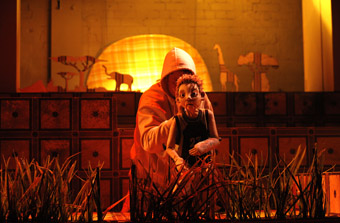
Africa, My Darling Patricia
photo Jeff Busby
Africa, My Darling Patricia
THE LAUNCH OF NEXT STAGE 2011 WAS HOT. THE TEMPERATURE WAS UP, THE WHARF 2 FOYER CRAMMED WITH ENTHUSIASTIC 20 SOMETHINGS AND ARTISTS THRILLED TO BE IN THE PROGRAM WHICH STC ASSOCIATE DIRECTOR TOM WRIGHT AND LITERARY MANAGER POLLY ROWE OUTLINED IN A NEAT DOUBLE ACT FOLLOWED BY A FEW WORDS EACH FROM DIRECTORS AND PERFORMERS.
Next Stage is focused on development, emerging artists, providing alternatives to the STC’s main program, attracting a different audience, “not trying to please everyone all the time” and “not setting expectations too high” for new works. Tickets are $25 and there’s a free beer per ticket offer.
First up in Next Stage 2011 is German playwright Roland Schimmelpfennig’s Before/After, directed by Cristabel Sved, who spoke mid-rehearsal of “the luxury of all working together and with all the languages of the stage being used.” A nice change from the challenges of resource-scarce independent theatre. With its 51 short scenes the play should provide a fascinating companion piece to the STC mainstage production of German writer Botho Strauss’ epic Big and Little Scenes.
Sam Routledge a collaborator with contemporary performance group My Darling Patricia expressed the group’s pleasure at being in Next Stage with Africa, originally a Malthouse commission, and outlined the origins of the work in the true story of German children caught running away to Africa. Told with puppets and broken toys, Africa presents a magical Australian perspective on childhood pain and fantasy.
Another innovative Sydney-based performance group, Post, in typical form stacked on a stand-up turn anticipating the themes and fun antagonism of their new work Who’s The Best? which was developed with Next Stage’s support in 2010.
Also developed in 2010, Money Shots will feature 15-minute plays about money by Tahli Corin, Duncan Graham, Angus Cerini, Rita Kalnejais, Zoe Pepper and The Suitcase Royale, directed by Richard Wherrett Fellow Sarah Giles and designed by Alice Babidge. As well the program continues the Rough Drafts series, week-long creative developments followed by free showings that allow audiences to track the growth of a play.
The heat’s on: Next Stage 2011 promises intense diversity of form as well as the means for hot-housing new work from a fascinating range of theatre and contemporary performance artists.
Sydney Theatre Company, Next Stage 2011; for season dates see
www.nextstage2011.com.au/
RealTime issue #101 Feb-March 2011 pg. 41
© Keith Gallasch; for permission to reproduce apply to realtime@realtimearts.net
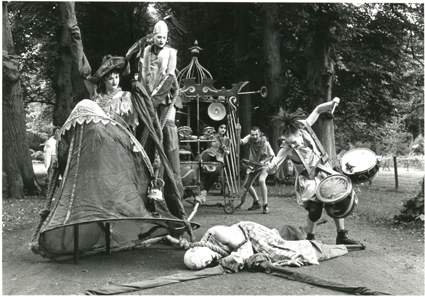
Toy Cart, Stalker, 1991
photo Geert Kliphuis
Toy Cart, Stalker, 1991
STALKER IS ONE OF AUSTRALIA’S MOST IDIOSYNCRATIC PERFORMANCE COMPANIES, EVOLVING OVER TWO DECADES FROM STILT-WALKING SHOWS—WITH VERVE AND INTELLIGENCE—INTO INCREASINGLY SOPHISTICATED, RICHLY THEMED LARGE-SCALE WORKS, ALL PERFORMED OUTDOORS, AND THEN DIVERSIFYING INTO TWO COMPANIES, STALKER AND MARRUGEKU. BOTH HAVE RESHAPED NOTIONS OF PHYSICAL THEATRE, INCORPORATING OTHER ARTFORMS AND EMBRACING SOCIAL, POLITICAL AND METAPHYSICAL ISSUES AND THEMES WHILE ACHIEVING INTERNATIONAL RECOGNITION.
Sydney-based Stalker is co-directed by David Clarkson and Rachael Swain, each contributing discrete shows to the company repertoire, while Marrugeku is co-directed by Swain and Broome-based choreographer Dalisa Pigram. I spoke with Clarkson and Swain after Stalker celebrated its 21st year at the end of 2010. Such longevity for a continually innovative company is quite an achievement, not least in a country of short-lived artistic ventures.
starting out on stilts
Clarkson tells me that an early version of the company had played in New Zealand for three years, but reformed in Sydney where it was joined by Swain in 1989 and given “$10,000 cold cash by the Sydney Festival after I showed them some of our New Zealand work and they said, ‘It looks great!’” Swain and Clarkson point out that their starting out was timely—the Expo in Brisbane and the Bicentennial had programmed a substantial number of outdoor works, as did the Perth Festival and the Spoleto Festival in Melbourne directed by John Truscott. Clarkson recalls that “within a year we were touring Australia-wide and within 18 months we were in Europe.”
I asked how the pair would describe their early work. “It was street theatre. Very high energy,” says Swain. “When we first got to Europe we made quite a big splash. David and I both grew up in New Zealand and I think there was a sense of the rhythms and energy of the Pacific in the work. It was quite pumping.” Adds Clarkson, “Our work was stilt-based and we took stilts somewhere that no-one else had. Dive rolls, backbend get-ups, carrying each other, throwing each other to the ground, picking each other up. Very bruising. ‘Hell for leather,’ that’s what it was. Stilt acrobatics.”
Swain mentions that Stalker was working with choreographers as early as their second show, Toy Cart (1990): “Nigel Kellaway directed and Rosalind Crisp choreographed and it premiered at Spoleto in 1990. It was high energy but it was also quite visually driven work and quite lyrical—a strong aesthetic that exists to this day.” Clarkson recalls that Swain “was never in love with Fast Ground (1989), our first piece, but looking back at it and at Grotowski’s movement work I can see connections—muscle and bone work, always distinctive from circus even though stilts are a circus thing. It was always for me about embodiment: ‘a state of being’ expressed through the body and what visual imagery we might use to support that embodiment.”
Swain and Clark acknowledge significant differences between their bodies of work, their aesthetics and Marrugeku’s artistic direction. Marrugeku started in 1995, commissioned into existence by Perth Festival. Stalker produces Marrugeku, but the company has its own life, based first in Central Arnhem Land for seven years and subsequently in Broome for eight, and with its own steering committee and direction. “But,” says Swain, “there are certain core elements that link all three bodies of work, combining dance theatre processes and aesthetics with circus forms and a fairly poetic, layered dramaturgy prevalent in all the works. David and I worked collectively to make material initially and then slowly brought other people in—Sue-ellen Kohler choreographed the third work we did, Angels ex Machina (1993)—often in very strong collaborative partnerships. Both of our processes are physical—we make material on the floor—like choreographers.”
working europe
Some of the aesthetic influences on Stalkers’ work came from their rapid arrival on the European summer festival street theatre touring circuit in their first year of existence. “We were exposed to a whole raft of European companies from the small street theatre acts through to really large scale: Generik Vapeur, La Furas dels Baus, Les Ballets C de la B, Vis-a-Vis, Dogtroep, all making very ambitious, large scale work.” Clarkson says that the company saw a model they thought they could adapt. “Some of the shows were in the streets, with a full 1,500 seat grandstand and all the production values, like the Dogtroep work. We saw a model used to create an incredible audience base and access to touring circuits, came back here and tried to function between the two markets, Europe and Australia. For about a decade that was both our advantage and, to a degree, our bête noir. We were trying to exist as if we were a European company but there wasn’t the market here for large scale outdoor shows outside the five major festivals.”
Swain regrets that “for me, the only presentation in Australia I’ve had outside a festival has been when the Sydney Opera House commissioned Incognita (2003). We’d spend our year in the European summer and come back for the Australasian summer for 10 to15 years.” Clarkson recalls that “in the early years we were on the road for 10 months of the year.” In the mid-90s, when Justin Macdonnell was the company’s manager, its circuit extended to Latin America, as it did to Japan with Marguerite Pepper and Rosemary Hinde. Clarkson says, “We were really surviving by touring and weren’t really funded early on. For youngish performers it was a tremendous experience and great exposure for us, an exciting way to live, but the ensemble burnt out. You can’t actually live by touring eight or nine months of the year.”
a model for survival
I asked when it was that Swain and Clarkson decided not to work together. Clarkson explains that he took “a big sabbatical in 1999. Blood Vessel was a Stalker show without me performing in it. I was in the States. Throughout the 90s we’d had a very close working relationship but then decided to go our own directions. [Arts consultant] Antony Jeffrey came in to work with us as facilitator to devise a new model. I think we both thought it meant either ending the company or one of us taking over. Personally I think what we got is a really great model for survival in the arts—shared infrastructure and management for two bodies of work that have similar sets of concerns.” Swain says, “it’s become a way of sharing resources and a point of dialogue and support for each other’s work, which I think we possibly wouldn’t have come up with ourselves. And so Antony is to be credited.”
market adjustments
Swain says she “went very strongly into the large scale outdoor theatre model and somehow managed to make that function until the dance theatre element of it became stronger and stronger and the large scale outdoor European summer festivals didn’t know how to program it. It was somehow too ‘arty’ for the summer festival world and the dance festivals that were starting to get interested didn’t know how to present outdoor work. So my work started to fall between the cracks and I think the fact that Shanghai Lady Killer [Swain’s latest creation for Stalker, 2010] became an indoor work has been a part of that process. I just wasn’t finding a way to park the work. Incognita should have had a longer life. It did three of the national Australian festivals, which is about as good as you can get in this country. Then in Europe we couldn’t fit either field any more. We have multi-arts festivals here so we’re used to all kinds of works being in a festival whereas in Europe they’re very artform specific.”
from the body
In 2010 David Clarkson created Mirror/Mirror (2009) for Stalker in collaboration with dancer Dean Walsh (RT94, p36). Before that he’d made Red (2004) and Four Riders (2001) “with an ensemble that I trained, with them taking on my approach to physicality.” Clarkson is currently developing a new work, Encoded, “working with a range of artists, virtual cameras and projection and point cloud generated animation” and wondering, “What is the next phase?” He suspects he’ll direct Encoded but not perform in it—“but it’s my own physicality that still enriches my creative process.” Like Swain’s Shanghai Lady Killer, Clarkson’s Mirror/Mirror also moved indoors.
a choreographic heritage
Rachael Swain appears to be working more and more choreographically, via collaboration with a range of choreographers, as in Incognita (2003) and Shanghai Lady Killer (2010) for Stalker and the Marrugeku creations (MIMI, 1996; Crying Baby, 2001; Burning Daylight, 2006, 2009). The works are large, multi-plane, theatrical, culturally dense. She attributes this in part to the influences of Europe in the 1990s and also of Stalker’s agent since 1991-2, Gie Baguet, as his first international company. Swain says, “Gie’s also the agent for Les Ballets C de la B and he introduced us to their work and other northern European dance theatre companies. The last decade for me has been a big project to bring something of their aesthetics into a dialogue with the kind of raw physicality of Australian dance and Australian new circus techniques. We saw so much work. We were in Amsterdam during the Yulidans international dance festival every year. We saw the evolution of the works of Anne Teresa de Keersmaeker, Wim Vandekeybus, Needcompany, Les Ballets C de la B. And we saw them every year. Australian physical theatre, dance theatre and circus have a really amazing physicality, a lot of which comes from a relationship with the landscape and the physical environment. I wanted to bring this and European aesthetics and processes together. A lot of that work is about a theatrical improvisational process that, as Alain Platel says, “sometimes leads to people dancing.”
That quotation puts me in mind of the work of Pina Bausch. Swain agrees: “Of course that is the lineage. Tim Etchells once said that he thought Forced Entertainment’s work was the end of a line of Chinese whispers that started in Wuppertal [the home of the Pina Bausch company]. And I sometimes think what we’re doing is too. Marrugeku’s Burning Daylight is the result of a very long Chinese whisper that started up in Wuppertal and went to Ghent through the collaboration between me and Koen Augustijnen [of Les Ballets C de la B] for Incognita and Serge Amié Coulibaly [from Burkina Faso; also worked with Les Ballets C de la B] for Burning Daylight and the classes I did over there.
“So I think that’s been the grand project on that front. Yes, I think I conceive and direct work as a choreographer but I really like to partner, most recently with Gavin Webber on Shanghai Lady Killer. Once again, that was about bringing European influenced contemporary dance from Gavin’s time with Wim Vandekeybus, formed through his time with ADT in a kind of loop back into the Australian dance theatre vernacular. I think that’s an ongoing project. And when I’m on the floor I’m working in an improvisational dance theatre process in shaping work.”
Swain is developing Shanghai Lady Killer after its 2010 Brisbane Festival premiere. “It’s a really big work for Stalker. It’s very complicated, an Australian-Chinese martial arts thriller that combines the wire and stunt work used in martial arts films, trampolines on stage, Chinese pole techniques and Wushu which is a particularly lyrical form of Chinese martial arts, in a kind of plot-driven futuristic thriller narrative. This was my first time working with a writer [filmmaker Tony Ayres] which was a great and challenging experience.”
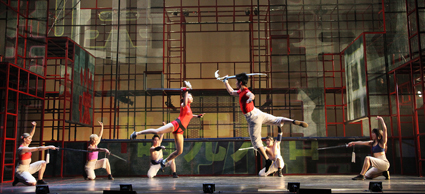
Shanghai Lady Killer
photo courtesy Stalker
Shanghai Lady Killer
Clarkson says he’s captivated by Shanghai Lady Killer despite early reservations about “the commercial narrative structure which I’ve always had problems with because it’s so bloody dominant.” Swain points out that she and Ayres conceived the show before the Global Financial Crisis when “there was a niche appearing for arthouse commercial theatre,” with some opportunities for radical, culturally diverse content. “But the GFC hit and the support that we had for it internationally went. We’d been aiming for a multi-million dollar version, but had to scale way, way, way back down. We were very lucky to be commissioned by the Brisbane and Melbourne Festivals through the Major Festivals Initiative Fund—enormous support and a big project for the fund. I think there is a big national home for Shanghai Lady Killer.”
intergenerational cultural sustainability
I wonder if Swain craves work on a smaller project. “Absolutely!” she replies. “We premiered Buru [Broome, 2010] straight after Shanghai Lady Killer. It’s a much smaller work although it’s still got a fairly large cast. It was devised and created with 10 young performers from Broome aged between 10 and 21—so it’s a very different feel. We worked for three years together with elders from the Broome community, very much in the wake of Burning Daylight, grasping this model as a way to use theatre as a sustainable form of culture, of carrying stories forward—obviously not the [sacred stories] but the ones they really want to pass on, to be public. The elders started to come into rehearsal and to say this is what I think should be happening now. It was a great moment for the company where there was really direct intergenerational knowledge transmission occurring in the rehearsal process and the young performers were really given the work to take forward. So effectively, we’ve established a youth company for Marrugeku. I don’t know if that means a fourth string to our bow now!”
Clarkson is similarly focused on intergenerational connections: “There’s a piece I’m doing called Elevate out at Penrith with three 19-year-olds, a kind of hip hop street stilt piece which is very much about the next generation. I think it’s only appropriate. Theatre is a gift that’s given to you and you pass it on.”
Swain says that “when I came to writing the speech for Stalker’s 21st birthday celebrations, I momentarily found it quite depressing. What is there after 21 years? What is left behind is ephemeral, in the memories of our audiences in all those different contexts, all over the world. And because that’s been so diverse for us and because what Stalker is in Belgium or what Stalker is in Colombia or what Stalker is in Perth, they’re all different, presented in very different models and to different sectors of the community. Twenty-one years of blood, sweat and tears, quite literally…broken bones and all that.
“But there are company members who have been in our work, learned new skills and gone on and done their own work or gone into other companies and contributed to other processes. I certainly hope in Marrugeku’s case that what comes after us will be the measure of the company’s success—finding a language that reflects the Aboriginal elders’ complexity of knowledge but that is also very contemporary. It is very hard to find the comprehension of that work, especially overseas. People often just don’t know what they’re looking at. I hope that we’re opening doors and that further down the track there’ll be more appreciation.”
Stalker have created a significant legacy over 21 very creative years. If the company had fallen apart a decade ago, that legacy might not have been as rich. Swain thinks that “there were times when I’ve thought had we been sane human beings we would have stopped.” Clarkson agrees, “Either financially or personally…but there have been big rewards, tremendous experiences.” And Swain concurs. Happy 21st, Stalker.
RealTime issue #101 Feb-March 2011 pg. 43,45
© Keith Gallasch; for permission to reproduce apply to realtime@realtimearts.net
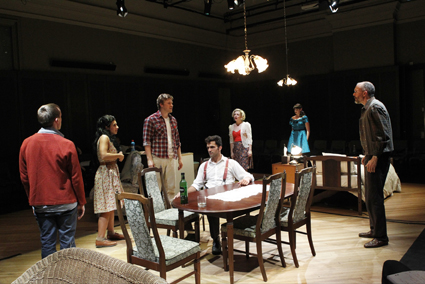
The Nest, Hayloft Project
photo Jeff Busby
The Nest, Hayloft Project
IF NIETZSCHE GOT IT RIGHT, AND HUMANS ARE LESS STATIC BEINGS THAN INCONSTANT BECOMINGS, THEN SURELY THE SAME CAN BE SAID OF THE INSTITUTIONS WE CREATE. CERTAINLY, THE MUCH-DISCUSSED “CHANGING OF THE GUARD” IN AUSTRALIA’S MAJOR ARTS ORGANISATIONS HAS MANY THEATRE PUNDITS PONDERING WHETHER THESE COMPANIES WILL BE PUSHED TO REINVENT THEMSELVES AS A RESULT, OR WHETHER IT’LL BE BUSINESS AS USUAL WITH A NEW BRAND IMAGE. LOOKING AT THE SMALLER GROUPS MAKING WORK IN MELBOURNE TODAY, HOWEVER, WHAT’S MORE EVIDENT IS HOW THE NATURE OF SUCH ARTISTIC ENTITIES IS ALWAYS A NEGOTIATION BETWEEN AN ENDURING IDENTITY AND A FIELD OF POSSIBILITY.
the nest
The Hayloft Project has remained one of the most exciting companies in Australia for several years, but focusing on the through-lines that connect each Hayloft production can distract from the impressive imaginative diversity it has also offered. Its final production for 2010 was The Nest, and while the production furthered the company’s interest in classic (especially Russian) texts adapted for a contemporary world, it was also a significant departure from what’s gone before.
Firstly, it saw Artistic Director Simon Stone hand over the reins. While Hayloft productions are almost always helmed by Stone as director, he has also allowed others to create their own works under the company aegis without overt artistic intrusion from its founder. 2009’s Yuri Wells was a hugely successful experiment in this vein, and that show’s creators also form the creative core of The Nest.
Taking as their source Maxim Gorky’s The Philistines, Benedict Hardie and Anne-Louise Sarks have developed a wonderful script that seems utterly of our time. As with Yuri Wells, Sarks again directs and Hardie performs, with a sizeable and accomplished cast making up a strong ensemble. Performed in the round (or, rather, square), Sarks displays a terrific command of pace, shifting quickly from scenes of crowded chaos to tiny, intimate moments of solitude or suspense. Despite the relatively brief running time—around 90 minutes—the sense of an expansive and credible world is quickly established, and something of the sweeping historical consciousness which often infuses Russian playwriting is maintained here.
But where productions of Gorky (or Chekhov for that matter) walk an uneasy line between historical specificity and more universal relevance, how would you know that The Nest hadn’t been written from scratch yesterday if you hadn’t already been told? The only thing that really reminds us of its origins is that oh-so-Russian habit of having countless characters turn up unannounced. Even this slightly anachronistic theatrical convention is knowingly laughed at after the production concludes and the theme songs from various sit-coms are played (sit-coms, of course, being the only place where it’s still acceptable for a constant stream of acquaintances to invade the house at all hours).
I’ve no doubt that in different hands—Stone’s, for instance—The Nest would have been a very different beast. But its inclusion within the Hayloft’s broader output only expands the company’s creative reach, making it home to a multiplicity of voices rather than a single, unitary directive. It’s all the better for it.
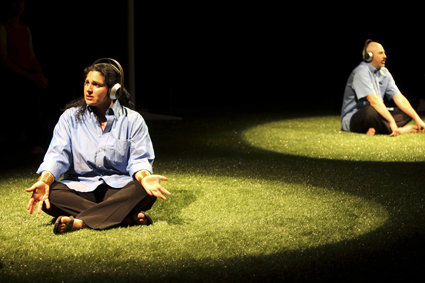
Georgina Naidu, Greg Ulfan Yet to Ascertain the Nature of the Crime, Melbourne Workers Theatre
photo Ponch Hawkes
Georgina Naidu, Greg Ulfan Yet to Ascertain the Nature of the Crime, Melbourne Workers Theatre
yet to ascertain the nature of the crime
Melbourne Workers Theatre, conversely, has had many esteemed directors across the decades, but is now undergoing a radical reinvention. Its last production, Yet to Ascertain the Nature of the Crime, hinted at the plans new director Gorkem Acaroglu has for recreating the company as one solely dedicated to documentary theatre, as well as a more general shift away from creating works based primarily around class concerns towards addressing a wider variety of contemporary social issues.
Yet to Ascertain…spoke to this new brief with outstanding clarity, incorporating questions of class and work but also closely scrutinising the realities of race relations in Australia today. It was developed from a range of verbatim sources including interviews, journalistic articles, official reports and first-person narratives. Three performers re-enacted these exchanges in a variety of theatrical styles, from frankly silly Bollywood dances to skit-comedy routines to sincere and moving monologues. Though patchy in tone, the collective weight of the production was considerable, and a lengthy final sequence in which a taxi driver is attacked by racist passengers before his own cab-driving community comes to his rescue is simply breathtaking theatre.
Though largely played in somewhat exaggerated, consciously theatrical ways, the various narratives produced here were of an intricate and provocative nature. Many circled around the experiences of Indian students and immigrants in Melbourne, including the real incidents of racially-motivated violence which have made international headlines as well as more engendered and institutionalised forms of discrimination. There are layers of irony to many of the word-for-word recountings of victims themselves, including denials that Australia is home to racism, as well as the police statements which are the basis for the show’s title. At the same time, contrary viewpoints which complicate the notion of racism as an ‘us vs them’ binary add to the overall challenge—and lack of easy answers—which the show presents to its audience. It’s a pity Yet to Ascertain…had such a short season, but it’s certainly an inspiring beginning for the company’s next stage of development.
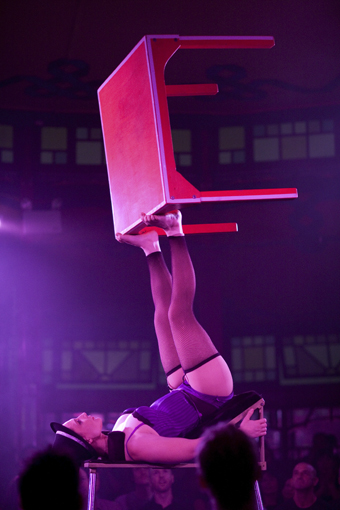
The Blue Show, Circus Oz
photo Robert Blackburn
The Blue Show, Circus Oz
the blue show
Circus Oz’s The Blue Show was billed from the outset as something unusual from the company. Housed in its new Spiegeltent, it promised an adults-only show as part of the midsumma festival, but what eventuated was something quite different. Less ‘adult’ in content than context, it was more an ageless celebration of sheer fleshy joy. Many similar Spiegeltent burlesques end up as shop-worn sequences of fairly tame titillation and nudge-nudge cabaret. Here, rather, was nudity and humour with a lack of inhibition that is often only found in children—it wasn’t that the acts set out to transgress social boundaries, but that they didn’t seem to even admit of their existence. Sure, there’s appeal in a show that allows us to enjoy a drink in intimate surrounds without toddlers scampering underfoot, but very much the same show could have played to all ages at an earlier timeslot without risking much outrage.
For me, the company’s regular higher profile family outings have long been hampered by “kid-friendly” clowning that doesn’t evince the same sophistication as some of the more intricate routines; the performers are all top-notch, but their talents can come across as dumbed-down when they don’t need to be. The Blue Show treats its audience as adults, as capable of viewing on a range of levels, but it also seems to me that many kids are just as able to handle this kind of subtle complexity. It’s encouraging to see the company branch off in this direction, and one can only hope that some of the acuity and focus displayed here will develop in the company’s more popular ventures in the future.
The Hayloft Project, The Nest, writers Benedict Hardie, Anne-Louise Sarks, after Maxim Gorky’s The Philistines, director Anne-Louise Sarks, performers Sarah Armanious, Stuart Bowden, Stefan Bramble, Alexander England, Brigid Gallacher, Julia Grace, Benedict Hardie, Carl Nilsson-Polias, Meredith Penman, James Wardlaw, set Claude Marcos, costumes Mel Page, lighting Lisa Mibus, music & sound design Russell Goldsmith, Northcote Town Hall, December 4–19, 2010; Melbourne Workers Theatre, Yet to Ascertain the Nature of the Crime, writer Roanna Gonsalves with Raimondo Cortese, Damien Miller, director Gorkem Acaroglu, performers Georgina Naidu, Greg Ulfan, Andreas Littras, performance consultant John Bolton, sound design by Mik La Vage, lighting Jason Lehane; Arts House, North Melbourne Town Hall, Nov 24-28, 2010; Circus Oz, The Blue Show, director Anni Davey, Circus Oz Melba Spiegeltent, Jan 13-Feb 6, 2011
RealTime issue #101 Feb-March 2011 pg. 44
© John Bailey; for permission to reproduce apply to realtime@realtimearts.net
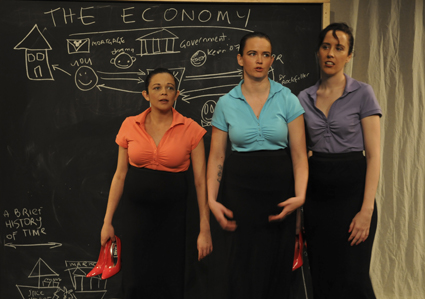
Natalie Rose, Zoe Coombs Marr, Mish Grigor, Everything I Know About the Global Financial Crisis in One Hour, Post
photo Heidrun Löhr
Natalie Rose, Zoe Coombs Marr, Mish Grigor, Everything I Know About the Global Financial Crisis in One Hour, Post
IN A DELIRIUM OF RIGHTEOUS FREE MARKET FUNDAMENTALISM, WESTERN CAPITALISM, ONSELLING UNSUPPORTABLE LOANS THE WORLD OVER, WENT MAD. SOME OBSERVERS RECOGNISED THE SIGNS OF INSANITY AND FORESAW IMMINENT COLLAPSE, THE REST OF US SUFFERED THE DELIRIUM OF THE AFTERSHOCKS AS STATE ECONOMIES, JOBS AND HOUSING MARKETS WERE SUCKED INTO A HELLISH BLACK HOLE.
Even if you didn’t feel the impact of the Global Financial Collapse in the pocket (a welcome $900 cheque from Prime Minister Rudd aside) you doubtless spent time anxiously wondering what had actually happened and would it recur in the shape of a much anticipated vicious double dip recession.
Nervous times yielded countless articles, broadcasts and books providing analyses simple and complex of the Global Finance Collapse. Some have been reassuring—providing a clear chain of cause and effect running from bad economic theory to market deregulation to failed governance and downright corruption. Others have revealed more worrying networks of disturbance, from unrelated one-off criminal acts (Bernie Madoff, a handy villain) to globalisation’s maximisation of the GFC’s impact, from American Republican and Australian Liberal politicians arguing for brutal economic clean-slating instead of stimulus packages to Detroit’s motor industry tsars driving cars to Washington’s Senate Enquiry and all of us having to grasp the reality that the USA was in substantial debt to China. The world had truly turned upside-down.
How can art assist in a time of paranoia and breathtaking absolutism? Belvoir’s B Sharp, in one of its last acts, brought relief and enlightenment in the form of A Distressing Scenario, a double bill from Sydney performance companies Post and version 1.0.
Of the two performances, Post’s Everything I Know About the Global Financial Crisis in One Hour, more effectively conveyed the aforementioned sense of delirium with a virtuosic stringing together of unlikely causes and effects, the semi-lecture format reinforced with bizarre chalkboarding (the board itself revealing ever new extensions) and interrupted with manic dancing, the waving of sparklers and the positioning of champagne bottles in readiness for the ultimate release.
The experience was like having the GFC explained to us by the ill-read, the ill-informed and the plain ill—the bandaged performers presented variously as victims of car accident, tonsilitis, cocaine addiction and pregnancy, all impediments to putting their show together. Undaunted, the Post trio launched into an elaborate and diffuse explanation of the GFC replete with muddled and inaccurate historical grabs and bizarre connections altogether reminiscent of paranoid popular media. An exhausting whirligig of associations dated GFC origins back to Rockefeller, the corn market, popcorn and the decline of the cinema, the 1988 Australian Bicentennial and Bette Midler tours as positive market indicators. These were accompanied by wild speculations about the value of training monkeys in universities and why there are no jaws of death for newsagents. The sheer, manic drive of the performance, its bracing informality, the self-belief, its mad poetry and smatterings of GFC-reality sucked an initially wary audience into a vortex of nigh impossibly suspended disbelief.
Everything I Know…was durational in every sense, for the courageous performers, sometimes perilously over-taxed, and for an audience riding the wild waves of free association, coursing the looping illogic and withstanding the recurrent, battering dance passages and the final champagne spray. With wicked ease, but little to celebrate as bankers and brokers clawed back their bonuses, Post left us nonetheless wiser about the way the human brain miscalculates and rationalises its way into disasters of the order of the GFC.
After the brief respite of intermission and anticipating further assault, we were bemused to find ourselves removed from Post’s compulsive cosmos and relocated to the parallel universe of version 1.0’s The Market is Not Functioning Properly. Same Big Bang—the GFC; same problems—how to comprehend and survive economic disaster; similar symptoms—faltering rationality and increasing delirium. The Market’s performers also, like Post, reveal themselves to be performers (“I’m an artist: no finances to speak of,” declares one).
But the Post and version 1.0 universes travel in opposite directions. Instead of the desperate, gutsy vigour of Everything I Know, The Market is neat, tautly framed, carefully paced. Two genteel women (Jane Phegan, Kim Vercoe) in pearls and satin gowns appear to parody themselves and then, more archly, middle-class womanhood as they grapple with the GFC and their domestic budgets (laid out on laminated cards that threaten to slip from their grasp). If Post are wildly mock educational, version 1.0 are calculatedly didactic. The women puzzle and bicker informatively beneath three screens inhabited by unreassuring world leaders, all men, alternating with three Australians, also men, with very little to say about the GFC.
As finances and life become less manageable (cut back on wine, on Belvoir tickets), the women strike poses of fright before the images of these men (the powerful and the ‘ordinary’ at times superimposed), dance awkwardly, swing together in violent circles, teeter on the edge of the raised stage and, finally, spew champagne into buckets hanging immediately before us. But they might as well have gone to pieces on another planet from our own. We could recognise the symptoms of their GFC-induced malaise but where was the rich, cranky substance of appalling cause and effect that we have come to associate with version 1.0? The Market was a surprisingly tame affair for a company whose major works have surreally and satirically brought to light the frightening deployment of power in politics, media and gender relations—revealing that the irrationalities and manipulation involved don’t have to be exaggerated, but reframed in order to be seen. Version 1.0 have set their benchmark very high and we expect a lot, not least the means with which to do battle with the insidious GFC.
–
B Sharp, A Distressing Scenario: Post, Everything I Know About the Global Financial Crisis in One Hour, deviser-performers Zoe Coombs Marr, Mish Grigor, Natalie Rose; version 1.0, The Market is Not Functioning Properly, deviser-performers Jane Phegan, Kym Vercoe, director David Williams, video artist Sean Bacon, sound Paul Prestipino, lighting Frank Mainoo; Belvoir St Theatre, Sydney, Nov 25-Dec 19
RealTime issue #101 Feb-March 2011 pg. 45
© Keith Gallasch; for permission to reproduce apply to realtime@realtimearts.net
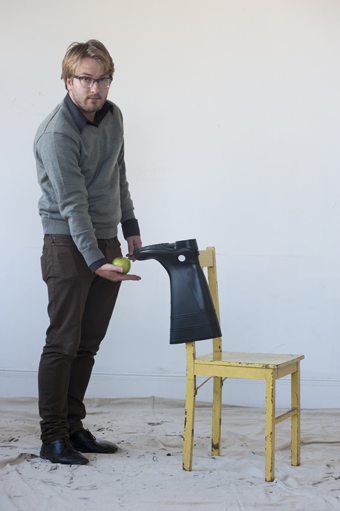
Ralph Myers
photo Patrick Boland
Ralph Myers
IN REALTIME 100, I GREETED THE 2011 BELVOIR PROGRAM WITH ENTHUSIASM. NEW ARTISTIC DIRECTOR RALPH MYERS’ LARGELY YOUNG TEAM OF DIRECTORS (INCLUDING SEVERAL WOMEN), A MIX OF RARELY SEEN CLASSICS (INCLUDING RAY LAWLER’S SUMMER OF THE SEVENTEENTH DOLL TO BE DIRECTED BY OUTGOING ARTISTIC DIRECTOR NEIL ARMFIELD), NEW PLAYS, A DANCE PIECE AND TWO ABORIGINAL WORKS COMPRISE A SERIOUSLY INVITING PROGRAM. IN ADDITION, THE INCORPORATION OF THE DOWNSTAIRS THEATRE INTO THE OVERALL PROGRAM SEEMS A SIGNIFICANT OPPORTUNITY TO PHILOSOPHICALLY AND PRACTICALLY EXPAND BELVOIR’S PROGRAM AND REACH.
MYERS, IN OUR FIRST MEETING, CONFIRMS HIS REPUTATION AS AMIABLE, FUNNY AND SHARP. HE’S AN ACCLAIMED THEATRE DESIGNER, NOT A STAGE DIRECTOR [AS YET], SO I THOUGHT IT MIGHT BE INTERESTING TO USE THAT AS THE PIVOT FOR OUR CONVERSATION.
You trained in visual arts, specifically in silversmithing, but then you went to NIDA.
I’m a bit impatient and hasty to see a quick result which is why I thought I might not make a good jeweller. And there’s something great about theatre design and indeed the process of making theatre in general. It’s something that happens quite quickly, you get a big result quite quickly and it’s all kind of slightly junky, which I think appeals to my kind of sensibility.
The materials, the disposability?
It’s ephemeral—you only need to make it last for a season while achieving the impression and the sensation that you’re trying to generate in the mind of an audience. Jewellery making—and I’m touching my wedding ring as I say this—is about the integrity of the material. How many carats is the gold, how well is it constructed, how many hundreds of years is it going to last? What I like about theatre is the exact opposite of that.
In theatre, it’s the durability of memory, isn’t it?
It is and that’s a strangely fugitive thing as well. Memories twist and transform. Neil’s wonderful production of Diary of a Madman makes quite an interesting comparison between what theatre was like 20 years ago in Sydney and now. He’s pretty faithfully reproduced that 1989 production with Geoffrey Rush and the original team, the original designers. It’s marvellous that even though it’s not that old, it’s stylistically from another era.
There are times when you have to live with your designs a lot longer than a Sydney season. A Streetcar Named Desire going to the US must have posed interesting challenges.
It’s a slightly horrible thing to say, but the ones that have the longest lives are not always the ones you want to. The curious thing about being a set designer is that ultimately you need to serve the vision of the director. So sometimes you have to make a decision to put your taste and your sensibilities—and your fears—aside and allow the director to ultimately make the decision.
You were serving Liv Ullman’s vision.
Absolutely. And she is an extraordinary figure, an important artist of the 20th century. Who am I to tell her what to do? I’m working on Ibsen’s The Wild Duck at the moment both as set designer and as artistic director of the company. We’re finding a way for that to work. And it does work because Simon Stone the director is very clear about his ideas and vision. So it’s not muddy.
There are a number of strong directors around who could be labelled auteurs, who arrive not just with a play but also a design concept for the designer to realise rather than invent.
You get directors who know exactly what they want and the task is making that work within the space and the parameters. And there are always an infinite number of details to resolve. I don’t mind that. I’ve been in situations for instance with Benedict [Andrews] where he’s led the process very much—I’ve realised an idea that’s come to me from him very much fully formed. On the other hand there have been other situations where the idea has been largely mine and it’s evolved in conversation. Barrie Kosky is another example. He has very strong ideas about what he wants. To be honest I find that the better directors know precisely what they want or latch onto an idea and allow it to be followed through to its logical conclusion. When I was working with Neil Armfield on Benjamin Britten’s opera Peter Grimes for Opera Australia, I’m fairly sure Neil came up with the idea of setting it in a church hall. I built a model of it and very quickly we realised that it would work. Then he allowed me to realise that very much on my own. So there’s quite an element of trust and understanding.
Your father was an architect, your mother a visual arts teacher; I’m very interested in the architectural quality of your work. It seems to me that some designers have a better architectural and spatial sense than others (whose work might resonate, say, with contemporary visual arts or technology or interior design). In certain of the shows you’ve designed the architectural quality is pronounced—those huge floating rooms in The Lost Echo (STC) or the room that revolves in Measure for Measure (Company B), that modernist superstructure hanging over a very ordinary, aged apartment in Streetcar Named Desire (STC), the grim in-the-round basement world for Blackbird (STC), the hall in Peter Grimes. They all struck me as very three-dimensional, very substantial. For all that ephemerality, they felt eerily solid.
I’m interested in solid things. My mother was an architect before I was born. I’ve always been around architects. I suppose if you come from a family of tailors, you look at what people wear. I am interested in people and space. I’m flattered that you think my work seems solid. The thing you’re fighting in theatre is that nothing is solid really. It’s all made out of bits of cardboard.
How do you feel about The Wild Duck? Do you engage with the actors and the director about the way the space is being used and inhabited?
I try to attend rehearsals as much as I can. I really like being in rehearsals. And of course the more you’re there the better the design serves the purposes of the play. I’d like to be there all the time but you can’t always be. In all good rehearsal rooms, there’s a certain amount of cross-fertilisation. Actors will suggest something about the set and you can suggest something about how they do their performance (LAUGHS). In the end it all comes out in the wash.
One of the tricks of being a good designer is to maintain as much flexibility as you can within the structures of how companies like this will work. All theatre and opera companies and certainly production departments will try to lock down the physical elements of production as early as they can because it makes it very much easier for them to do their job. One of the difficult things to say after the second preview might be: “Actually, it should all be pink” or “I think this is completely wrong. Let’s get rid of the set and do it on an empty stage” or “I think she should be wearing a wedding dress.” These things throw a spanner in the works, blow the budget and make it very difficult. But ultimately that’s what you might need to do: use the time at your disposal to make the production as good as you possibly can. Sometimes you can’t have the best idea three months in advance of the production or, in the case of opera, 18 months.
One of the things I’m conscious of as artistic director of this company is allowing it to remain pretty responsive, which it always has been. As a set designer this was the one place where you really could change your mind quite late which is a really fabulous thing. I think this probably comes from Neil’s chronic inability to make artistic decisions (LAUGHS). He’s left a great legacy for the rest of us.
For Measure for Measure you were working with projections and onstage cameras. You’ve made it clear elsewhere that you see theatre as a very different realm from film and new media—that’s not to say you’d exclude them. But that work provided a fascinating experience in terms of design, accommodating the revolving room that keeps transforming and the screens that frame it.
I’m often extremely sceptical about the use of audio-visual material in theatre productions because I think it can be a substitute for something that could be shown in real time or ‘real life.’ The figure on the screen is often much more interesting to watch than the onstage figure, because of scale. So your eye tends to be drawn there which starts to beg the question well why is there a figure there at all onstage? As you know, Benedict’s extremely interested in working in that way. As the designer for Measure for Measure of course I went along with it, made it work as best I could within the space, worked with Sean Bacon and in the end I think it was extraordinary. You gain something, of course, by the use of the camera to show a kind of detail that otherwise couldn’t be seen. That’s much more interesting than showing what you can already see. So Benedict’s focus on Mariana’s wedding—you know touching her engagement ring at the top of Act 3—or zooming in as he did in The Season at Sarsaparilla on a detail or moment that would otherwise be lost to the audience, is extremely interesting. It’s an interesting extension of that idea.
I suppose there’s not much you can reveal about your design for The Wild Duck at this stage. What would you say is the creative impulse for you in the production?
It’s extremely exciting. I don’t want to jinx it by saying it’s going to be good but Simon has a very sharp brain and a very good sense of what’s at his disposal in terms of the actors and the resources that are available to him after coming from a background in independent theatre where everything is slightly difficult to get hold of. Here things are more possible. That said, it’s quite a restrained production, not over the top in any way. He’s essentially taken the core story of The Wild Duck, those six central characters, the inevitable playing out of an action over a short period of time that happens in Ibsen plays, and stripped it of all the stuff around it, rewritten it and placed it in a very spare environment.
It all happens in one space?
It’s even more abstract than that somehow. It’s really no space at all. The adaptation has a kind of charm that’s often missing from the adaptation of classics—a kind of lightness, playfulness and charm that’s very easy to lose when you’re trying to faithfully adapt something. It’s a bit like—while being nothing like—Noel Coward or Oscar Wilde in that the way that people interact with each other doesn’t always reflect the great drama and import of the things that are being discussed. I don’t know how Simon manages to create that. He’s got a very playful rehearsal room. There’s a great deal of light. But it’s a horrific play. A 14-year-old girl in the end shoots herself.
Obviously like many before you, you’re enamoured of the Belvoir St Theatre space, and you’ve worked it before. Will you occasionally lease yourself out to bigger stages?
I’m working on a production for Opera Australia in 2012. That’s the only thing I’m doing outside at the moment. I’m designing for Benedict’s production of Chekhov’s The Seagull for our 2011 program.
What have been the pleasures of putting this program together for you?
It’s an enormous pleasure listening to a whole lot of people speak very passionately and enthusiastically about the things they want to do. The difficulty, of course, is choosing which ones to take up. A company like this should be as open as it can be, as able to hear as many ideas from as broad a range of places as possible. One of the challenges for a company is that you can become insular or that you only turn to people you know or who you’ve worked with before, which I think is extremely dangerous. The other side of that is that you have to listen to a whole lot of bad ideas from a whole lot of people too. But that’s okay. So that’s a great pleasure. And then you make a salad out of it. And there are a lot of reasons why some things end up in the mix and others don’t but really nothing ends up in there that I don’t think is going to be good or interesting or hopefully both. I very much started the process with the ambition to not include anything simply for pragmatic reasons.
Like making big box office?
Yes and you never can anyway. From a few years of working at the Sydney Theatre Company and from many years around the traps working as a designer in lots of theatre companies, you see that there are things that a company does for legitimate and artistic reasons and there are other things they do to satisfy what they imagine the audience wants or what’s going to make money, all sorts of reasons. My one ambition is to not have one of those productions. We’re lucky we can do that here. We don’t have quite the pressures of the big state companies. It’s an enviable position. The trade-off for winding up the B Sharp program was that we were going to be able to do fully staged productions down there. The disadvantage was that we wouldn’t be able to do so many of them. My ambition is to build that up over time so that it has the same volume and energy that B Sharp had but where everybody is being paid. My big ambition is to employ more artists in general. It’s surprising how few people think that’s a good idea [LAUGHS]. But I think it’s critical for a city of this size, a city as fabulous as Sydney to have a lush and thriving artistic community. And I think you have to do that by directing money towards people to do it. We’re the third or fourth biggest theatre company in the country. I think we need to face that reality.
Henrik Ibsen’s The Wild Duck, directed by Simon Stone, featuring performers John Gaden, Anita Hegh, Ewen Leslie, Eloise Mignon, Anthony Phelan, Toby Schmitz and designer Ralph Myers is playing at Belvoir Street Theatre, Feb 12-March 27; Belvoir, artistic director Ralph Myers, Sydney; www.belvoir.com.au
RealTime issue #101 Feb-March 2011 pg. 46-47
© Keith Gallasch; for permission to reproduce apply to realtime@realtimearts.net
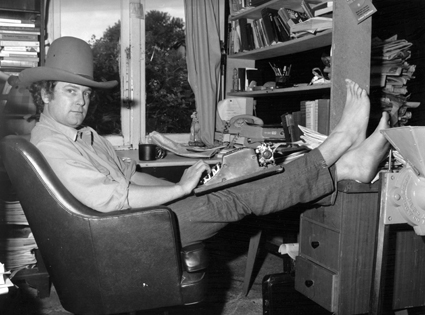
Frank Moorhouse (archival)
photo courtesy of ABC Document Archives
Frank Moorhouse (archival)
HERE’S AN INSPIRED IDEA: NOT ONLY PLAY A SERIES OF EIGHT CLASSIC AUSTRALIAN STAGE AND RADIO PLAYS PRODUCED BY THE ABC OVER THE DECADES BUT ALSO INTRODUCE EACH WITH CAREFULLY AND INVENTIVELY CRAFTED 30-MINUTE INTRODUCTIONS FROM WRITERS (WHERE AVAILABLE), PRODUCERS, ACTORS AND SPECIALIST COMMENTATORS FLESHING OUT THE SOCIAL, POLITICAL AND AESTHETIC WORLDS AND CREATIVE IMPULSES FROM WHICH THE WORKS EMERGED. PLAYING THE 20TH CENTURY REALISES THE VISION WITH VERVE.
The series is a collaboration between ABC Radio National’s Hindsight and Airplay programs aiming to “chart a century of Australian theatre” from Louis Esson’s The Time Is Not Yet Ripe (1912) to Katherine Thompson’s Diving for Pearls (which won the Louis Esson Prize for Drama in 1991!). The other plays are Betty Roland’s The Touch of Silk, Douglas Stewart’s radio verse play Fire on the Snow, Ray Lawler’s Summer of the Seventeenth Doll, Alex Buzo’s Norm and Ahmed, David Williamson’s The Removalists and Frank Moorhouse’s experimental radio drama Loss of a Friend by Cablegram.
Of the three introductions I’ve listened to so far, it was the world conjured by the reflections of Moorhouse, McLennan and actor Arthur Dignam on Loss of a Friend by Cablegram that I found the most engrossing. The commentaries on The Time Is Not Yet Ripe from academics John McCallum and PJ Matthews were richly informative but the voice given Esson (from his letters) was not engaging and the documentary’s structure is the least inventive of the three. The introduction to Diving for Pearls however is full of the sounds of its Port Kembla steelworks and coastal setting and there is clever segueing from playwright Thompson’s voice into those of her characters along with astute observations from the play’s first stage director Ros Horin and Di Kelly from the University of Wollongong on the political context.
The appeal of the introduction to Loss of a Friend by Cablegram for me lies in its embodiment of a period of transition in radio drama production in the early 1980s from the imitation of the live theatre experience on air to more intimate approaches, from single take recordings on tape (often subsequently destroyed) to intensively edited productions, from crude FX to field recordings (the right acoustic) and from predictable structures to experiments in form. McLennan, who produced the play, details these transitions with amusement against the sounds of tapes running and creaky old FX. Again there’s a brisk alternation between the documentary voices and the original recording which was made with Dignam and Robyn Nevin in a room in the Sebel Town House in Kings Cross with verite intimacy and a lovely depth of field. Typical of the period of transition the sense of experiment that comes with Moorhouse’s writing is undercut by stilted, hyper-articulated stage delivery. Even so there’s much to amuse and even disturb in the production as a man and his estranged wife deal with his bisexuality, not least when she asks, “Did you think you were a woman when you lived with me, when we were married?”
There’s much to enjoy from Moorhouse about writing, about notebooks (which provide the play’s structure), about bisexuality, and from Dignam about working in radio (“When I started to learn how to drink”—as the actors headed off to a Push pub after recording for, as Moorhouse puts it, “critical drinking”) and the pleasant experience of being involved in a new way of working. Even so McLennan is surprised that most of Loss of a Friend by Cablegram was largely recorded in real time, in the traditional manner, even Dignam’s character’s inner thoughts—achieved by the actor simply turning to another microphone. Producer Catherine Gough-Brady’s introduction to the play offers insights about the writer, the work and an era of transition—sexual and aesthetic—telling us much about radio as well as the Australian play.
ABC Radio National, Airplay and Hindsight, Playing the 20th Century, producers Catherine Gough-Brady, Regina Botros, presenter Andrew McLennan, broadcast Dec 19, 2010-Feb 6, 2011; the series can be heard at www.abc.net.au/rn/playingthe20thcentury/
RealTime issue #101 Feb-March 2011 pg. 47
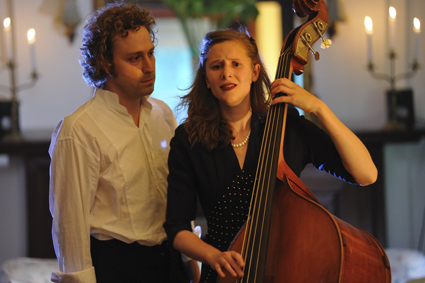
Mike McEvoy, Ida Duelund Hansen, Another Lament
photo Paul Dunn
Mike McEvoy, Ida Duelund Hansen, Another Lament
TARGET, THE ITCH AND ANOTHER LAMENT ARE THE WILD PROGENY OF CHAMBER MADE OPERA’S 2010 LIVING ROOM OPERA SERIES, AN INNOVATIVE APPROACH TO FUNDING NEW WORKS ENCOMPASSING PRIVATE PATRONAGE, GOVERNMENT SUBSIDY AND CROWDFUNDING. A HOST PROVIDES THEIR LIVING ROOM AS THE PERFORMANCE SPACE, WHILE BOOKING ONE OF THE LIMITED SEATS (IF YOU’RE LUCKY YOU’LL ACTUALLY GET THE SOFA) COMES WITH RECOGNITION AS A CO-COMMISSIONER, FOOD, WINE AND THE OPPORTUNITY TO DISCUSS THE WORK WITH THE COMPOSER AND FELLOW AUDIENCE-PATRONS.
While the Living Room Opera series has precedents in salon performance traditions, its particular combination of funding and social strategies gives hosts, audiences, composers and performers a unique sense of ownership, opening up the possibilities for original and inspired creations.
Luke Paulding’s Target re-imagines the Ancient Greek myth of Ganymede, the most beautiful of mortals abducted by Zeus to serve as cup bearer to the gods; Alex Garsden’s The Itch musically embellishes an article from The New Yorker in 2008 about a woman who awoke one morning with an chronic itch on her head (RT100, p40); and Another Lament (a collaboration between double bassist and singer Ida Duelund Hansen, from the mixed-ability performance ensemble Rawcus, and sound designer Jethro Woodward) explores the death of the English baroque composer Henry Purcell. The young composers’ musical styles are as varied as their subjects, from the bleeding edge of extended string techniques to jazz-inflected baroque arias.
“I did not especially set out to work with young composers,” claims Artistic Director David Young, “the works speak for themselves.” As many composers struggle to find funding once they grow out of the youth bracket of government grants, the Living Room Opera series provides a valuable lesson in alternative sources of funding for its participants.
target
Performed in “Melbourne’s living room,” La Mama, the work in progress Target showcases Paulding’s distinctive timbral vocabulary in exploration of the dynamics of sexual desire and fear in ancient and contemporary worlds. Through saccades between episodes of delicate wind, percussion and vocal extended techniques, Target’s enchantingly transparent sonic palette evokes a world of short attention span pleasure as Zeus (baritone Matthew Thomas) towers over Ganymede (boy soprano Jordan Janssen) in the cramped La Mama theatre. Flute and tuba breath tones flicker at the periphery of hearing until the terrifying and terrified power of Zeus’ voice is brought down upon Ganymede at the moment of his abduction. Ganymede interrupts the peripheral hum not with screams but with silence, the boy’s twittering interrupted by the glottal stops of trauma.
The audience was intimately close to the ensemble in La Mama’s black box, ensuring that none of the subtlety of Paulding’s composition was lost. After the performance, the audience had the opportunity to ask questions of the composer and hear key sections of the opera again. As David Young explains, the Living Room Opera concept takes its cue from the 19th century tradition of salon performances, where virtuosi would bash out the latest works by Liszt and gentlemen would show off their fine baritone in an intimate, semi-private setting. Beyond a small-scale format for the development of new grand works, Young sees the salon format as serving a pedagogical purpose. Warning that “this is not just a nostalgic experiment,” Young wants audiences to “learn more by having a close experience and speaking with the artists after the show.”
The didactic ending to Target evoked not only salon performances but also Schoenberg’s Society for Private Musical Performances of 1918–21. Formed for the development of musical understanding, the well-rehearsed works were repeated as many as six times during a single program. Unlike at the strictly pedagogical performances of Schoenberg’s Society, there was no shortage of applause at the conclusion of Target, which is set to become a fully-fledged Living Room Opera later this year.
the itch
With Alex Garsden’s The Itch, the Living Room Opera series moved in to full swing. Fiona Sweet and Paul Newcombe’s open plan living space filled with interested patrons quaffing wine while the performers loitered outside a set of french doors. Although Garsden’s masterful representation of skin irritation on string instruments was hard on even the most seasoned ears and despite the occasional twitch, cough or scratch of discomfort, the audience sat in rapt attention to Garsden’s score and soprano Carolyn Connors’ pained vocalisations. This was not an audience looking for a pleasant night’s entertainment, but one intent on supporting new music.
Offering the perks of being recognised as co-commissioner of the work, speaking with composer and performers, and sharing the performance in an intimate setting with like-minded aficionados, events like The Itch resemble Kickstarter and Fundbreak crowdfunding campaigns, where fans sponsor small-scale cultural projects. They are rewarded, depending on the size of their donation, with things like back catalogue CDs and visits to the recording studio of the supported artist. (Since Kickstarter campaigns rarely gather donations from outside the campaigner’s circle of friends of friends, it might be more correct to say that crowdfunding campaigns resemble an intimate living room gathering of a network of interested persons more than the decentralised and anonymous peer group that the “crowdfunding” appellage suggests.)
another lament
Another Lament takes as its inspiration the death of English baroque composer Henry Purcell. So the colourful version of the story goes, Purcell succumbed to pneumonia after his wife locked him out in the snow when he returned from a long night of carousing at the local theatre. Hosts Deidre and Naham Warhaft’s hallway and twin living spaces, separated by screen doors, provide a double proscenium arch for Rawcus director Kate Sulan’s immaculately choreographed tableaux vivants. Sulan uses the house’s depth and wings to conceal the Rawcus ensemble and lighting by Richard Vabre, haunting the tripartite stage with apparitions so carefully placed as to seem to have always inhabited the space. Even in moments of frenzied activity, when plates are broken and Purcell begs at the front door, the audience seems to be haunting a haunting quite indifferent to their presence.
Sulan’s use of simple repetition and broken symmetries complements Duelund Hansen’s pared back interpretations of Purcell hits on voice and double bass. She utilises a vast stylistic spectrum from baroque to jazz harmonies and mid-20th century Central European atonality, to extended vocal and double bass techniques. Her reinterpretations of Purcell demonstrate an expressive continuum in harmonic and timbral composition from unnerving baroque contrapuntal dissonance to the sickly crackle of cotton thread over a double bass string.
Woodward completes the ethereal habitation, manipulating sound throughout the three rooms. By looping and amplifying Hansen, actors’ voices, breaking tea cups and spinning plates, Woodward lends the house layers of resonating history as the performer’s voice is multiplied in a carefully controlled musical polyphony.
As representative of the Living Room Opera project, Another Lament stands as a celebration of contemporary chamber music and a rebirth of baroque arts business practice. The Living Room Opera series reflects the combination of public funding, private patronage and enterprise that Purcell himself enjoyed in Restoration England (while holding a post at Westminster Abbey), fulfilling commissions from royalty and composing music for the theatre. Though Chamber Made Opera’s workings may seem baroque (both historically and as in “irregular”) in an arts industry fixated on government subsidy, they are looking backwards to move forward, supporting a battery of composers by bringing chamber opera home.
Chamber Made Opera, Living Room Opera, 2010-11, www.chambermadeopera.com
RealTime issue #101 Feb-March 2011 pg. 48
© Matthew Lorenzon; for permission to reproduce apply to realtime@realtimearts.net
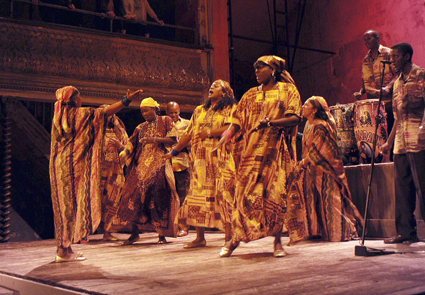
Creole Choir of Cuba
photo Zak Hussein
Creole Choir of Cuba
A HIGHLIGHT OF WOMADELAIDE 2011 IS BOUND TO BE THE CREOLE CHOIR OF CUBA—EFFUSIVE, DYNAMIC AND COMMITTED TO SUSTAINING THE CULTURAL HERITAGE OF CAMAGÜEY IN CENTRAL CUBA. THE CHOIR OF FIVE WOMEN AND FIVE MEN FORMED IN 1994 WITH AN AIM “TO RE-FORGE THE RESISTANCE SONGS AND LAMENTS OF THEIR FOREBEARS, TO CELEBRATE THE HISTORY OF THEIR HAITIAN DESCENDENTS ENSLAVED TO THE CARIBBEAN FROM WEST AFRICA” (WWW.CREOLECHOIR.COM).
The choir’s Cuban name, Desandann, means “descendants,” and the title of their recent album Tande-la means “listen.” What you’ll hear are songs of resistance and lament about the choir’s forebears working as slaves in sugar and coffee plantations and the subsequent grim legacies of colonialism. Listening to the album or watching a video of the choir in performance however conveys anything but overwhelming grief or naked anger; rather there’s a sense of the joy of survival, of cultural continuity and hope. As well there’s the potency of the music’s diverse elements—Spanish, voodoo, gospel, Creole—and its distinctive percussion-driven choral synthesis.
WOMADelaide 2011 has a strong performative streak, with bands and performance groups offering a heightened theatricality —the Ukraine’s DakhaBrakha, French hip-hopper Féfé, China’s Hanggai (“born from the Chinese punk scene…remains true to its Mongolian roots”), the brilliantly adorned Papua New Guinean Huri Duna Dancers and Brazil’s psychedelic Os Mutantes (bearer of the 1960s Tropicália heritage). France’s Le Phun will guide small groups to installations featuring “peculiar half-human and half-plant beings from the vegetable kingdom” and, also from France, Compagnie Ekart’s large-scale puppets will roam the festival crowds.
WOMADelaide’s continuing engagement with contemporary dance is realised this year by Adelaide’s Leigh Warren + Dancers who will perform a new work, Breathe, “exploring the sacred nature of suspended breath, forged around the ageless, spectral sound of the didgeridoo.” Composer William Barton will perform his work on the instrument for Frances Rings’ choreography. The dancers will be Lizzie Vilmanis, Albert David, Bec Jones, Lisa Griffiths, Adam Synnott, Lewis Rankin and guest Indigenous artists in what promises to be another visual and aural WOMADelaide 2011 highlight. RT
WOMADelaide, Sounds of the Planet 2011, Botanic Park, Adelaide, March 11-14, www.womadelaide.com.au
RealTime issue #101 Feb-March 2011 pg. 49
© RealTime ; for permission to reproduce apply to realtime@realtimearts.net
THE PINNACLE OF MUSIC MAKING IS SURELY THE SOLO PIANO PERFORMANCE. IT IS FOR THE PIANO THAT THE GREATEST MUSIC IS WRITTEN, AND WHEN VIRTUOSO PIANIST MEETS LEGENDARY COMPOSER—RICHTER AND BACH, BARENBOIM AND BEETHOVEN, ARGERICH AND CHOPIN, NIKOLAYEVA AND SHOSTAKOVICH—MAGIC HAPPENS. MUSICAL RECEPTION INVOLVES EMOTIONAL PERCEPTION. THE COMPOSER WRITES TO ELICIT EMOTIONAL STATES AND THE PIANIST CONNECTS THE LISTENER TO THE COMPOSER THROUGH HERSELF.
Pianists need more than a high level of technical facility. Indeed, they can’t fully realise the music until they can transcend the score, find the composer’s voice and use it to tell their own story. When buying a recording, I used to look for the ‘best’ rendition of the work, but soon found that many renditions will appeal in their own ways. You meet a unique and engaging individual, the pianist, who introduces herself through another unique and engaging individual, the composer.
The pianist’s teacher empowers and inspires the pianist to find the composer’s voice and her own voice. To become adept is a lifetime’s work, a vocation. In her insightful and uplifting memoir Piano Lessons (Black Inc, 2009), Anna Goldsworthy reveals that her own teacher, Eleonora Sivan, teaches the philosophy of life, and describes how her teaching creates the pianist.
Inspired by meeting Eleonora Sivan and some of her former students at a music teachers’ conference, composer Larry Sitsky wrote a seven-movement suite, The Golden Dawn, each movement of which would be performed by one of Sivan’s former students—Goldsworthy, Gabriella Smart, Jane Burgess, Inna Fursa, Rosanne Hammer, Phuong Vuong and Debra Andreacchio. Sivan was a noted performer and teacher before migrating to Australia, and those students are themselves now performing and teaching, continuing a pedagogical line that can be traced back to Liszt and Czerny. Sitsky is also a teacher, having been a professor at the ANU School of Music, and was taught by masters who inculcated the Busoni tradition in him. Comparisons with the legendary Nadia Boulanger spring to mind—a teacher who could so inspire composers and performers that a whole era of development resulted.
Sitsky has written some great piano works, his The Way of the Seeker, wonderfully recorded by Michael Kieran Harvey, being a notable example. The idea of writing a work that celebrates the master teacher is uncommon in Western culture, but appropriately acknowledges the importance of teaching. In this concert, each pianist ceremonially paid homage to her teacher by giving her allotted movement a sparkling premiere performance.
For Sitsky, music is fundamental to life itself and is inextricably linked with mysticism. He named the suite after an early 20th century magical society in England, the Golden Dawn. The society used an esoteric language, Enochian, from which the names of the various movements were taken. The work is powerfully expressive, and the character of each movement is reflected in its title. The opening movement, Mahorela (Dark Heavens) begins with a slow, hammering bass and develops into a series of short, stabbing gestures as a call to action. The second movement, Malpirgi (Fiery Darts) begins with a loud bass gesture followed by cascades down the keyboard, fleeting figures and rapidly repeated notes. Vinu (Invoke) is slow and rhythmic, and Ser (Lamentation) is dreamily mournful. Luciftias (Brightness) starts with quiet tinkling and gains in complexity and Yor (Roar) growls and bellows. The final movement, Vaoan (Truth) is measured and speech-like, returning to the bell-like tones of earlier movements. Recurring forms and motifs connect the movements. The black-clad pianists sit closely around the piano, which, given the magical theme of the music, resembles a three-legged cauldron from whose depths they conjure. This is an enchanting event, and the playing is superb.
This performance is followed by delightful renderings of Sitsky’s Fantasias No. 11, E and No. 4, Arch, played by Smart, and No 7, on a Theme of Lizst, by Goldsworthy, demonstrating the range and depth of his composition.
The Golden Dawn celebrates both a school and group performance. The seven pianists approach the composition in their own ways. Should they change places, the result might be different musically, but no less resolved. The next generation is establishing itself; for example Marianna Grynchuk, a student of both Sivan and Smart, is giving articulate and persuasive performances. Each pianist brings to her playing her own emotional range and expressive style, her own consciousness.
The Golden Dawn is a consummation of elemental life forces. Afterwards, both Eleonora Sivan and Professor Sitsky seem well pleased and the gathering of teachers, composers, musicians and listeners rejoices.
Larry Sitsky, The Golden Dawn, performers Anna Goldsworthy, Gabriella Smart, Jane Burgess, Inna Fursa, Rosanne Hammer, Phuong Vuong, Debra Andreacchio, Hartley Concert Room, University of Adelaide, Nov 27, 2010
Chris Reid’s review of Sitsky’s The Way of the Seeker appeared in RealTime 78.
RealTime issue #101 Feb-March 2011 pg. 51
© Chris Reid; for permission to reproduce apply to realtime@realtimearts.net
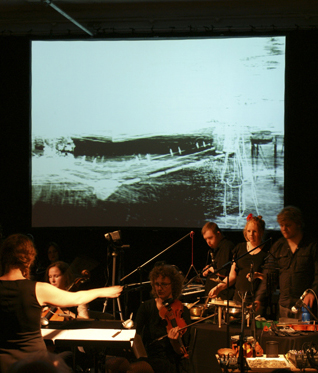
Daniel Bond (Amplified Elephants), Tom Oaks and Annemeike Oaks (Noise Scavengers), Belinda Woods, Caerwen Martin, Andrea Keeble (BOLT Ensemble), The Mountain, The Click Clack Project
photo Matt Bonner
Daniel Bond (Amplified Elephants), Tom Oaks and Annemeike Oaks (Noise Scavengers), Belinda Woods, Caerwen Martin, Andrea Keeble (BOLT Ensemble), The Mountain, The Click Clack Project
THE MOUNTAIN EMBODIES AN AGENDA FOR SOCIAL EQUALITY. IT BRINGS TOGETHER ARTISTS WITH VARYING ABILITIES, FROM HIGHLY EXPERIENCED PROFESSIONAL MUSICIANS, TO THOSE WITH DISABILITIES OR FROM DISADVANTAGED BACKGROUNDS.
Artistic director James Hullick has striven to create work that equally values the contributions of all members, regardless of ability. In CD liner notes, Hullick writes, “If we are to accept that all people are equal as they walk amongst our vibrant community, then we must accept that the abilities of all people are of equal worth to our community.”
The Mountain brings together three ensembles: The Amplified Elephants, Noise Scavengers and the BOLT Ensemble. The Amplified Elephants are a group of musicians with intellectual disabilities, evolving through a program at the Footscray Community Arts Centre. Noise Scavengers is a group of young sound artists emerging from a similar program at Cloverdale Community Centre.
The BOLT Ensemble is a group of professional musicians, put together to perform original works by Hullick. As well as performing this role in the Mountain project, they have also helped in its development, working closely with musicians from The Amplified Elephants and Noise Scavengers to explore and discover new sounds.
The Mountain is a multi-movement work, using combinations of these three ensembles. It is based on Jetsun Milarepa, the story of a Buddhist saint who finds redemption through having to build a tower, then tear it down and repeat this process several times over. In this performance, Jetsun’s story is told through a series of scenes. The piece is not so much a programmatic depiction of the story but, instead, a series of abstract, contemplative moments derived from the narrative.
A plethora of sound sources are employed in this performance. These cover an entire spectrum of volume, from the subtle rustles of a prepared harp, blown bottles and delicately struck gongs, to loud, pulsating synths, no-input mixers and the grating sound of a tortured violin.
Given the varying ability of the musicians involved, Hullick’s approach to composition is dictated by the musicians’ capabilities. The role of composer is one of facilitation and the organisation of material. Hullick manages to breath life into this role by creating circumstances in which performers are free to delve into a playful engagement with sound. Despite this apparent freedom in performance, the overall work maintains focus and direction through variety of sonic ideas. What is perhaps most successful is the way sounds produced by non-professional players are integrated with those produced by professionals. This combination of sounds produced complexes of timbre that were detailed and intriguing.
Hullick’s compositions for the BOLT Ensemble seem to have recently developed a language that has greater command in the evolution of musical ideas over time. Rather than being a series of sound combinations that amble through a performance, there are different degrees of momentum and energy; musical structures that play with one’s perception of time.
Despite the complexity of Hullick’s musical structures, his aim for music to embody social equality is not lost. There is an inherent dialogue in the work in which all the voices of the players make a valuable contribution.
Visual images by Klara B Klaric and Tien Pham provide a useful way of delineating the various scenes. While the overall contribution was generally atmospheric, the graininess and roughness of the images complemented the music’s aesthetic, if at times distracting our sense of its evolution.
The Mountain takes the idea of ‘found sound’ in an entirely new direction. As well as turning unexpected objects into musical instruments, this work also finds unexpected performers. Just as found sounds are inherently intriguing, the manner in which musicians discover and engage with sound yields its own intrigue and idiosyncrasies. The risks in this work, taken for the sake of artistic ideals, have paid off with success. The Mountain Concerts have realised the ideal of social equality in performance, and not merely as the spectre of possibility.
The Mountain Concerts, by The Click Clack Project, featuring The Amplified Elephants, Noise Scavengers, BOLT Ensemble, presented by Footscray Community Arts Centre, Cloverdale Community Centre and JOLT Arts Inc; fortyfivedownstairs, Melbourne, Dec15-18, 2010
RealTime issue #101 Feb-March 2011 pg. 50
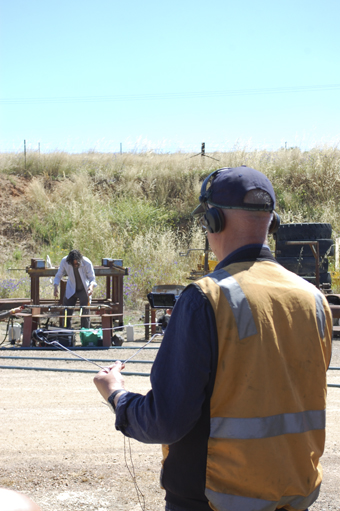
Chris Watson, Rolling Stock
photo Public Assembly
Chris Watson, Rolling Stock
ON A TOASTY SATURDAY AFTERNOON, SEVERAL HUNDRED PEOPLE GATHERED FOR THE ROLLING STOCK EXTRAVAGANZA, FEATURING INSTALLATION AND PERFORMANCE WORKS AT THE JUNEE RAILWAY ROUNDHOUSE AND ON AN HISTORIC TRAIN RIDE.
The project had a site-specific emphasis, building on the evocative architecture and machinery of the train and Roundhouse and upon the phenomenon by which sound can overlay and transform the visual environment. Dave Noyze and Garry Bradbury made a hugely entertaining work of the Roundhouse turntable, a sort of huge record platter on which train carriages can be spun and driven into the workshops. The rotation of the platter caused a fearsome clamour as tons of metal and concrete ground together. The artists made a subtle yet savvy intervention, adding their own sounds but largely relying on the spectacle of the machine itself. The duo’s work harked back to the futurist enthusiasm for mechanical noise, with perhaps less Italian aristocratic arrogance and more rustily laconic bogan self-satisfaction, laced with snotty Industrial lip-curl. One can only hope that they’ll be let loose on another edifice, perhaps the Sydney Harbour Bridge or the rotating restaurant atop Sydney’s Centrepoint Tower.
Among other works, a local parkour crew braved the sun to provide some hi-NRG action, vaulting carriages and locos, eliciting visceral sensations in the audience as they flew above the concrete, evoking the spirit of concrete-clad outer Paris. Joel Stern and Andrew McLellan drummed and thrummed out a two-person, rural-NSW style gamelan sound using junk that was lying about (presumably waiting for such a performance opportunity), creating moments of entrancing musical pleasure.
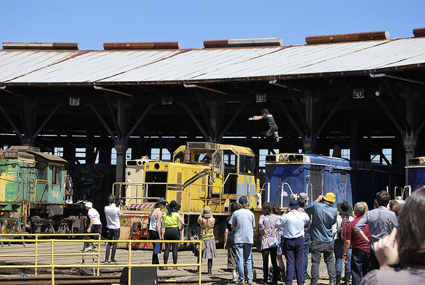
Parkour, Rolling Stock
photo Jennifer Teo
Parkour, Rolling Stock
Following the Roundhouse smorgasbord of sounds came a train journey to Cootamundra and back. Like the Roundhouse, the historic train needs barely the slightest breath from the artist, being a novelty in its own right. Infusing the artistic proceedings was the social scenario created by the train, where urban and regional were thrown together in the booths of the antique rail carriages. In one such encounter, my listening to the performance of UK artist Chris Watson co-existed with a woman’s story of her daughter’s suicide following a grand-daughter’s premature death. I could not ask the woman to stop, not least because the teller hadn’t noticed there was a performance to hear. Such is art as it emerges from its trench and sticks its head into the terrain of life.
Chris Watson’s polished and sophisticated work took the form of El Tren Fantasma (The Ghost Train), a sound design recreating another train journey. It is composed from recordings made by the composer for the Great Train Journeys TV series in 1998, documenting the last coast-to-coast passenger service of the Mexican State railway system prior to its closure due to privatisation. Watson’s strength is the masterful fidelity of his recordings with which he skilfully composes his simulations. The outstanding feature of the work was his manipulation of one’s sense of time, transforming a multi-day journey into a single experience. In Junee the work reads as an imaginative fancy, layering exotic Mexico over exotic rural NSW. Given the site-specific emphasis of the festival, one hopes Watson made some local recordings and might re-present them in situ in the future. El Tren Fantasma is soon to be released on CD.
Also working with the sound of the train was Sydney media artist Shannon O’Neill, whose Locomentum foregrounded the iconic phenomenon of rail rhythms. A subtle piece inviting close listening, it blended the live and recorded sounds to create a minimalist ‘phase space’ where the already hypnotic rhythm of the train is blurred by a recorded doppelganger. This innocuous play of rhythm opens up reflection on the auditory pleasure of trains, wherein the regularity of the sound is compelling. Trains, like ships, can have a particular pleasure, stemming from their combination of high-speed motion and hotel-style living. They have a lulling rhythm, but also the potential for humungous collision, injury and death. I’m reminded of the lullaby “rock-a-bye baby in the tree top; when the wind blows, the cradle will rock; when the bough breaks the cradle will fall”; it’s a rhyme that on reflection seems an odd one to relax a child.
Other works on the train included Sleeper Carriage by Noyze and Bradbury. Installed in a sleeper carriage, and sounding much like an Alan Lamb work, it offered a rich seam of electronic sound to be listened to from the privacy and comfort of a bed, albeit with the spoken accompaniment of artists and punters who took respite and refreshments in the compartments and perhaps didn’t realise or care how far their conversations carried. In another carriage the PVI collective presented a work based on local political issues via the medium of a tug-of-war. Numerous other works were presented, with details available at http://rollingstock.weebly.com/.
Art maverick Sarah Last, who describes herself as an artist rather than curator, organised Rolling Stock. Her work in the Unsound Festivals, the Wagga Space Program, The Wired Lab and a variety of other activities is noteworthy. There are few curators working in sound in Australia, and even fewer curators working with sound site-specifically. In her plenary address to the 2010 Regional Arts Australia conference, Last outlined her interest in breaking down artist-audience divisions and encouraging the creative and active participation of local communities in art projects. The audience at Rolling Stock didn’t actually get their hands dirty with noise making, but the presence of more non-practitioners than practitioners in the audience is a step in the right direction. While some of the works showed depth of engagement with the site and were created in cooperation with community, the degree to which audiences were challenged and their perception developed was less clear, perhaps by virtue of the very private nature of the art experience.
To my ear, the most amazing sound of the weekend was the soundscape of insects, animals and air movement heard at midnight in a quiet spot 10 kilometres from town—an immersive ecosystem of interlocking patterns, layers, events and narratives. Recording technology and artists will always be hard pressed to compete with the wonders that the world serves up. For me this is the strongest offering of sound culture: events like Rolling Stock induce heightened awareness of a realm of aesthetic information that is familiar to many practitioners but, I suspect, lost on people at large.
Rolling Stock was driven by Sarah Last’s pursuit of her ideas and aims and her ongoing relationships with particular spaces and communities such as the railway works and the people of Junee. These are long-term projects, embedded in her own life in a family farm that houses The Wired Lab. It will be interesting to see how these relationships develop and how Last’s objectives play out.
–
Wired Lab, Rolling Stock, curator Sarah Last, Junee, NSW, Nov 20, 2010; http://rollingstock.weebly.com/; artist residencies, Nov 12-19
RealTime issue #101 Feb-March 2011 pg. 53
© Bruce Mowson; for permission to reproduce apply to realtime@realtimearts.net
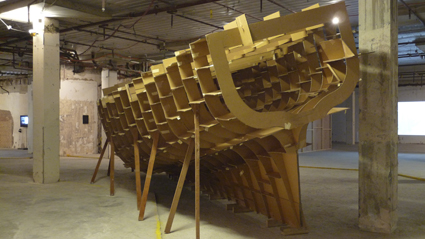
Jonathon Dady, An Uncertain Vessel (2010)
photos Alan Cruickshank
Jonathon Dady, An Uncertain Vessel (2010)
THE ADELAIDE CONTEMPORARY ART SCENE IS BIG ENOUGH TO SUPPORT A SUBSTANTIAL AND DIVERSE ART COMMUNITY AND SMALL ENOUGH TO STAGE AN EXHIBITION EXEMPLIFYING THAT COMMUNITY’S PRACTICE. CACSA CONTEMPORARY 2010: THE NEW NEW SHOWCASED THE WORK OF 44 ARTISTS ACTIVE IN SA OVER THE LAST DECADE. LOCATED IN 12 SITES, INCLUDING PROMINENT PUBLIC SPACES AND EVEN ON THE SIDE OF A TRAM, NEW NEW CONTINUES CONTEMPORARY ART CENTRE OF SA DIRECTOR ALAN CRUICKSHANK’S INTEREST IN PERIODIC SURVEY EXHIBITIONS.
Cruickshank indicates in the detailed catalogue that the participants were specially selected for the exhibition, which was intended to raise awareness of SA contemporary art and to educate viewers. The opening night at The Gallerie was so well attended that some patrons had to be turned away, attesting to wide interest. This raises the possibility of developing an ongoing exposition and a permanent contemporary art collection. It also raises the question of how artists get media exposure and recognition. New New provided an important opportunity for many artists, partly addressing the perception of CACSA’s preference for international over local art during the decade, though some notable artists were omitted. But it is a significant achievement for CACSA to mount such an extensive exhibition, which was only possible with substantial public and private support.
The work was strategically sited and the seven public works extended the exhibition into prominent locations. The choice of The Gallerie—a gutted, ironically-named, former shopping arcade—as the main location was significant in opening to the public a forgotten corner of the CBD and creating a vibrant atmosphere. But while New New resembled a biennial in scale, it eschewed any unifying curatorial theme. Approximately one third of the artists emerged in SA since 2000, and the work of the established artists generally typified their oeuvres, collectively presenting a Google Earth view of Adelaide’s art. It’s too soon to historicise that decade’s artistic development, but themes and directions are apparent.
New New aggregates the principal strategies of visual art and the forms of visual culture that have emerged since the 1970s—an expanded field of multifarious visual languages, employing traditional and vernacular materials, installation, performance, text, screen media and found objects, and actively engaging the viewer. Identity, contemporary culture and the very nature of the (art) object remain perennial considerations, and full appreciation of New New relies on the viewer’s awareness of recent art history locally as well as internationally.
Most striking was the work greeting viewers at the entrance to The Gallerie, Sam Songailo’s New Sound, an installation that immerses us in a dazzling colour-field, merging neo-Op Art into the fractured architecture to ‘clear’ our heads. Painting’s evolution is apparent in Paul Sloan’s Arise Therefore, which combines painting with found objects (rock band instruments and skeleton) in an installation that also inventively appropriates The Gallerie’s architecture. Anton Hart’s Twins incorporates a found photograph, construction and painting to juxtapose three forms of representation. Painterliness appears in contrasting ways in Christian Lock’s lush, swirling, glossy abstractions Sweet Tooth and The Luxurious Hours of the Duke of Berry, and in Warren Vance’s Voyage d-elimination in which small faux naïf illustrations are mounted on light boxes. Painting meets text and street art in KAB 101’s extensive untitled wall work at The Gallerie and the imagery on the tram.
George Popperwell’s teasingly cryptic but delightfully rewarding Far Away + Once Upon a Time and Bent Bank co-locate Old English texts with commercial packaging. Another intriguing work was Strange Fruit by the conceptual art group Green Candle, a collaboration between John Barbour, Paul Hoban and others. The group approach isn’t new in art, but exciting syntheses are developing between these prominent SA artists.
Adelaide’s established photographers showed the kind of work that has gained them their reputations. Mark Kimber’s lightbox-mounted photos of dioramas in Blyth Street challenge traditional concepts of masculinity. Darren Siwes combines images with installation to reflect on the impact of class and social structure on the developing individual. Ian North’s A Short Walk in the Country eloquently addresses his favoured theme of landscape and the situation of the viewer within it through photographs inscribed like an honour board with the names of great thinkers on landscape and environmental issues. Deborah Paauwe’s Entwined Song continues her concern with loss of innocence; Nici Cumpston’s photographic installation in Rundle Mall movingly documents traces of past Aboriginal occupation of drought-stricken Lake Bonney; and Brenda Croft’s scenes of Australia suggest she is recording it in anticipation of its loss, a kind of nostalgia for the present.
Video is developing in new ways. Made using a phone, Siamak Fallah’s five videos record his spontaneous and intimate interviews with friends and acquaintances. Iranian-trained University of SA masters candidate Nasim Nasr’s moving work, Erasure, shows a chador-clad woman writing on a chador-like form, whereupon the text is erased, referencing the ‘invisibility’ of Iranian women and the issue of cultural incommensurability. Andy Petrusevics’s Buzz! Fizz! Pop! comprises imagery projected onto small panels inside a viewing booth, playfully recreating life as a sideshow. Mark Siebert’s video, Mark Siebert’s South-East Asian Chess Tour, shows the artist playing chess, having declared himself a failed painter, the work inevitably recalling Duchamp’s preoccupation with the game and his withdrawal from painting. Yoko Kajio combines video with performance in Karistirma. And Monte Masi’s videos provide the exhibition’s self-referential element—his rap-style monologues and interviews with artists are both about New New and an element of it.
Environmental awareness emerges strongly but diversely in the work of Angela Valamanesh, Croft, Cumpston, Kajio and North, in Sue Kneebone’s A Broken Party, comprising animal bones on coffee tables, and implicitly in Hossein Valamanesh’s Wishful Thinking that employs the green-powered lighting on the face of a CBD car-park, the Rundle Lantern, to create a striking text.
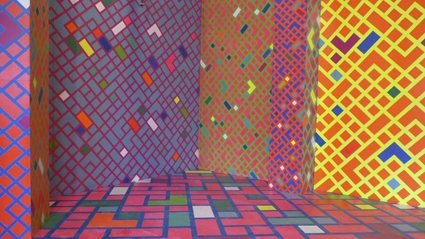
Sam Songallo, A New Sound
photo Alan Cruickshank
Sam Songallo, A New Sound
My favourites included Songallo’s work for its visual and architectural impact, Jonathon Dady’s An Uncertain Vessel for its grace and conceptual eloquence, and Sally-Ann Rowland’s Monuments, a series of black velvet forms mimicking indoor plants, for their elegant, brooding intensity. Dady’s An Uncertain Vessel is an outline of a boat roughly 10m x 3m x 2m, an iconic form made from cardboard and sitting tilted on wooden supports. It resembles a life-size 3D drawing, exemplifying Dady’s concern with the propositional and his use of discarded packaging to reconsider familiar forms and objects. For me, it suggests a stalled but much needed ark. Equally captivating is Joe Felber’s installation at the CACSA, which juxtaposes competing elements to challenge the viewer’s attention: Playback, El nuevo mundo acústica, in which multiple sound sources are broadcast asynchronously through fixed and swaying loudspeakers, and his video Jumping, Jerking Flesh. And Siamak Fallah’s videos succinctly embody the impact of new communications technologies on human interaction, as well as being the most genuinely new work in the show.
CACSA Contemporary 2010: the New New, Contemporary Art Centre of SA; The Gallerie; Feltspace; the SA School of Art Gallery, University of South Australia; the University of Adelaide; and at various public locations in Adelaide, Oct 29-Nov 21, 2010
RealTime issue #101 Feb-March 2011 pg. 52
© Chris Reid; for permission to reproduce apply to realtime@realtimearts.net
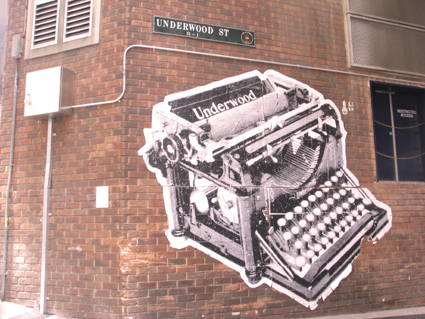
Woodwork, Simon Yates
photo Gail Priest
Woodwork, Simon Yates
WHEN TALKING ABOUT LANEWAY ART, IT’S HARD NOT TO IMAGINE THE VIBRANT PALIMPSESTS THAT ADORN MOST AVAILABLE SURFACES IN MELBOURNE’S CITY CENTRE. BUT WHILE MELBOURNE HAS TUCKED-AWAY GALLERIES, BOUTIQUE SHOPS AND UBERCOOL BARS EVERY FEW PACES, SYDNEY’S LANEWAYS ARE THE TRULY FORGOTTEN SPACES—SHADY NO-GO ZONES WHERE TRUCKS UNLOAD, GARBAGE IS DUMPED AND CHEFS STEAL A QUICK CIGGIE BREAK. HOWEVER IT’S THIS UTTER LACK OF CHARM THAT IS USED MOST INTRIGUINGLY IN THE LATEST SYDNEY CITY LANEWAY EXHIBITION, ARE YOU LOOKING AT ME?, CURATED BY BARBARA FLYNN.
Armed with the downloadable PDF walking guide I started at Underwood Lane, near Circular Quay. While the lane itself does not have much romance, the name proved to be a direct inspiration to both artists exhibited here. Simon Yates’ Woodwork consisted of large-scale photocopy paste-ups of old-style typewriters and telephones, drawing on the fact that early typewriters were manufactured by Underwood, as well as referencing the lane’s location—behind the old telephone exchange. I was unable to find the secret messages supposedly hidden in the keyboards and phone dials, but this didn’t matter. The wallscape immediately invoked a literary dreaming, calling up a pantheon of down-and-out writers clacking out stories in their inner-city dives overlooking lanes like this.
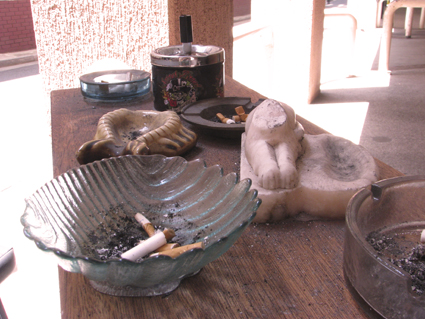
Milk and the town that went mad (detail), Mikala Dwyer
photo Gail Priest
Milk and the town that went mad (detail), Mikala Dwyer
The literary theme continued with Mikala Dwyer’s Milk and the town that went mad. For her the name Underwood conjured the spectre of Dylan Thomas and his poetic masterpiece Under Milkwood. On the barren corner beneath air-conditioning pipes, Dwyer placed a makeshift bar with stools, topped with a variety of curious and ugly ashtrays creating a hidden haven for smokers. As they indulged their guilty pleasure they were treated to Richard Burton’s famous reading of Thomas’ text. For a moment I wished I smoked in order to get the full experience, but just listening to Burton’s lilting voice, so clearly of another time, tangibly slowed the pulse in the midst of city bustle, cracking open the poetic potential of the site.
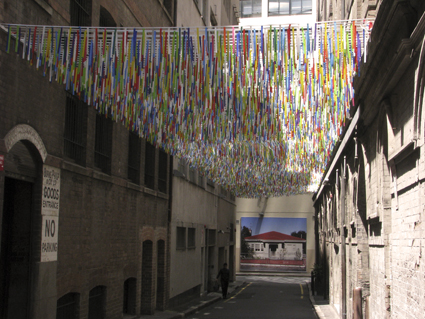
Rush, Nike Savvas (foreground), Room for Rent, Rocket Mattler (background)
photo Gail Priest
Rush, Nike Savvas (foreground), Room for Rent, Rocket Mattler (background)
High up on a wall in Tank Stream Way, Rocket Mattler’s battered “Room for Rent—apply opposite” sign directed me to a large format print of a typical old-style suburban home. It was both terrifyingly bland yet rich with detail, from the dog in the window to a barely visible graffiti tag on the front fence. To many, this picture of normality is what they are fleeing as they try to make it big in the city, while for others it offers a wistful sense of nostalgia, and for others still—the homeless, the overworked—perhaps it is a tantalising dream. Placed opposite Nike Savvas’ Rush, a ceiling of coloured plastic strips reminiscent of retro fly curtains—the most overt and celebratory artwork in the selection—the combination produced a queasy hyperreality.
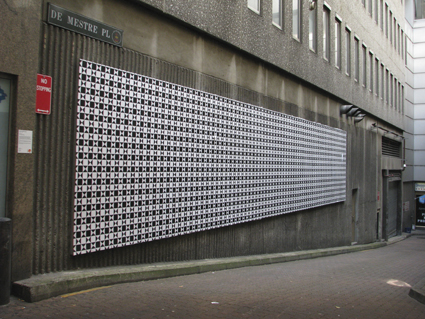
Warrior, Jan van der Ploeg
photo Gail Priest
Warrior, Jan van der Ploeg
In De Mestre Place, Jan van der Ploeg’s Warrior offered a large canvas of black and white geometric patterns in mesmeric repetition. Given the scale and architectural integration of other works by the artist, it would have been good to see him let loose beyond the rectangle. In Wynyard Lane, Jon Campbell’s HAR BOUR VIEW did just that, unabashedly revelling in post-modern irony, his large banner bearing the text of the title in sickly pastels.
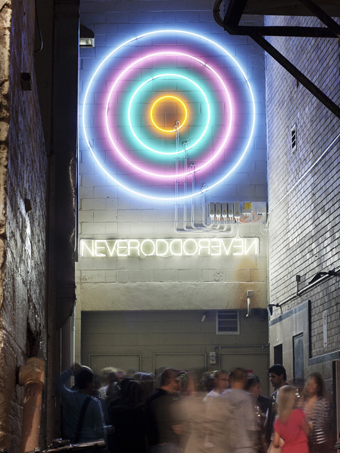
Circle/s in the Round for (Miles and Miles +1), Newell Harry
photo Jamie Williams Photography
Circle/s in the Round for (Miles and Miles +1), Newell Harry
Across at Temperance Lane Newell Harry’s Circle/s in the Round for (Miles and Miles +1) was an elegant wall sculpture of concentric neon circles that counselled us to “NEVEROD.” Inspired by Miles Davis’ 1967 Circle in the Round album, the work literally lit up the end of the dark alley in an eerie-cheery way. As with several of the works that have been exhibited since 2007, when the Laneways regeneration project commenced, negotiations are underway to make this a permanent public artwork.
Most of the works were in out of the way locations so it was particularly fascinating to explore the laneways themselves. I had a lot of difficulty locating Justene Williams’ Banker, Baker, Spanglemachinemaker in Curtin Place, but in the process found several other ‘possible’ installations. The act of reimagining the urban site, looking for the ‘art’ in it, was a fascinating by-product of the exhibition. (It turns out that Williams’ work was a video projection that started around 7pm, and even after returning for a second viewing at 8pm it was still not quite dark enough to get a real sense of the piece.)
Equally elusive was Simryn Gill’s Food on the Table, an ambitious proposal to create a feast in Abercrombie Lane, made from the discarded food found in bins. Gill was hoping to challenge ideas about wastage, consumerism and poverty, but was unable to fully activate the idea beyond research and consultation due to regulatory issues—which says something about the difficulties involved in mounting public art.
Rather than an instant re-invigoration of Sydney’s laneways, Are you looking at me? offers a gradual activation of forgotten spaces. The most successful works don’t attempt to decorate desolate sites, but instead propose reimaginings in and for them. In a city renowned for its love of spectacle, these small-scale aberrations are welcome, but in order to have a real effect on the cultural life of the city, we simply need more of them. The City of Sydney’s recently drafted Public Art Strategy suggests this might become a reality.
Are you looking at me?—Laneway Art 2010, curator Barbara Flynn, City of Sydney, Sept 23, 2010-Jan 31, 2011
City of Sydney is currently calling for proposals for Laneway Art 2011, deadline March 1; www.cityofsydney.nsw.gov.au; The City of Sydney’s Draft Public Arts Strategy can be found at www.cityofsydney.nsw.gov.au/cityart/about/
RealTime issue #101 Feb-March 2011 pg. 54
© Gail Priest; for permission to reproduce apply to realtime@realtimearts.net
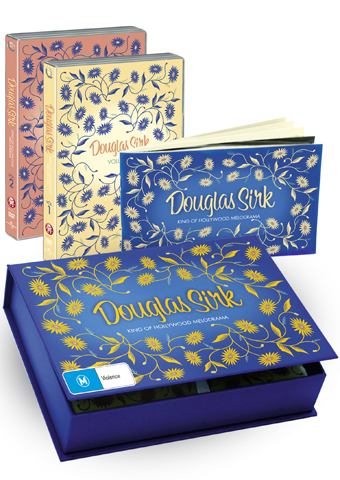 Courtesy of Madman Entertainment and in celebration of our 101st edition, RealTime is offering a lucky reader a ravishing cinematic giveaway: a 9-DVD box set of the great films of the 1950s master of aesthetically and socially incisive Hollywood melodramas, Douglas Sirk.
Courtesy of Madman Entertainment and in celebration of our 101st edition, RealTime is offering a lucky reader a ravishing cinematic giveaway: a 9-DVD box set of the great films of the 1950s master of aesthetically and socially incisive Hollywood melodramas, Douglas Sirk.
Titled Douglas Sirk: King of Hollywood Melodrama, the opulent Madman set includes the filmmaker’s classic melodramas—Imitation of Life, All That Heaven Allows and Magnificent Obsession—as well as minor classics like Tarnished Angels (about stunt pilots and based on William Faulkner’s Pylon) and Taza, Son of Cochise with Rock Hudson as an Apache chief in Sirk’s only western.
Read film scholar Wendy Haslem’s overview of Sirk’s key films on page 28.
To compete for the Sirk DVD set go to
www.realtimearts.net/sirk_survey.html
• Complete the short survey so that we can continue to improve RealTime Online for your reading pleasure
• Tell us how the 9-DVD Box set Douglas Sirk: King of Hollywood Melodrama will improve your life (the best answer will be the winner!)
• Join our e-dition mailing list (if you haven’t already) to receive fortnightly updates about new content on realtime online, news, exciting features and more giveaways.
RealTime issue #101 Feb-March 2011 pg. 56
© RealTime ; for permission to reproduce apply to realtime@realtimearts.net
In Sam James video work you’re watching an edition of RealTime
roll off the presses. Back in 1994, quite a bit of the pre-online print edition would have stayed on your hands as ink but more importantly in your mind, new synapses firing rapidly as we surveyed and critiqued the urgently needy hybrid performance and new media arts scene ignored in those days by the mass and other media. The excitement hasn’t abated, as indicated by the many artists and groups of the 101 we approached who have contributed to our 101st edition celebration with 101 or so words each about what’s next for them in 2011. The diversity, inventiveness, commitment and playfulness on show in their contributions and throughout this edition are reward enough for our 101st and will keep us fuelled up for the year to come.
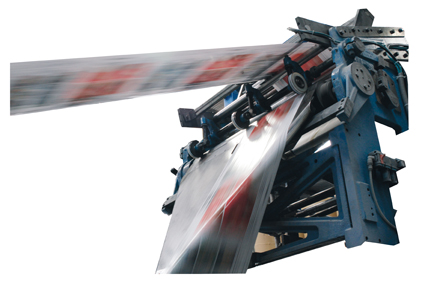
RealTime on the press
photo Sam James
RealTime on the press
To make sense of editions 1-101 and beyond as a comprehensive record of an era and to pay tribute to a generation of adventurous artists, we are archiving more and more of RealTime+OnScreen online. All editions are available back to 2001, all dance articles back to 1994 as part of our RealTimeDance portal (launching in March) and we’re working hard to put the rest of RealTime 1994-2000 online over the next year. If you’re a student, a researcher, an artist, an arts writer or a fancier of innovative art you’ll find our archive increasingly valuable, recharging failed synapses, firing new ones. Fond memories and online pleasures aside, opening and fondling a new print edition of RealTime still brings joy to many a reader: the ink might not rub off, but ideas and sensations still do. Read on. Celebrate.
RealTime on the press – video by Sam James
RealTime issue #101 Feb-March 2011 pg. 1
© RealTime ; for permission to reproduce apply to realtime@realtimearts.net
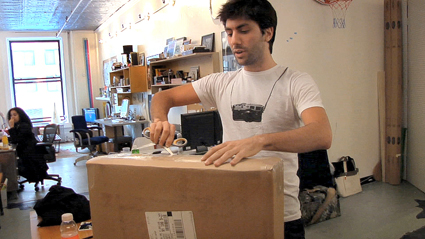
Catfish
GENRE FILMS, PARTICULARLY COMEDIES, HORROR AND TEEN FLICKS, HAVE ALWAYS BEEN QUICK TO INCORPORATE THE LATEST FADS. JUMPIN’ JACK FLASH FEATURED ONLINE CHATS, YOU’VE GOT MAIL REVOLVED AROUND EMAILS AND ROMANCE, JULIE AND JULIA FOCUSED ON A BLOGGER, WHILE EASY A, JUST RELEASED ON DVD, INCORPORATES VIDEO BLOGS TO HELP THE SPREAD OF GOSSIP, A MODERN EQUIVALENT OF THE SWIRLING NEWSPAPER MONTAGE.
In general, though, filmmakers have been slow to explore social media phenomena: the increasingly important daily impact on many lives of using websites like Facebook (FB) and Twitter. Perhaps it’s the text-based nature of these online worlds that makes it difficult to weave into dramatic narrative. But two recent films, Hollywood’s The Social Network and the low-budget doco Catfish, explore the history and ramifications of lives being created, lived and loved online.
Musicians have been quick to incorporate social media into their songs. YouTube is awash with clever ditties about FB loves and hates and the joys of Twitter. Australian singer/songwriter Kate Miller Heidke’s ballad “R U Fucking Kidding Me?” details a failed relationship with a nasty ex who now wants to be a Friend on FB. But contemporary fiction writers (at least those published in the mainstream) seem to have let the internet and its social ramifications bypass them completely. Literary critic Geordie Williamson argues that for most fiction writers the internet doesn’t even exist, despite the reality of a substantial subculture compulsively checking their email, iPhones, FB and Twitter accounts every couple of minutes (especially those in their teens and 20s):
“You only have to start reading with one eye for the internet to see how ignored it is by the profession that once explored the radical implications of Marx, Freud and Darwin’s thought, and which blasted totalitarianism, dramatised sexual revolution, thought the unthinkable about nuclear war…Faced with the web, though, fiction has retreated into silence. Old-school modernism toned down for middlebrow tastes (with a dash of post-colonial exotica, perhaps) seems the default mode for much self-described literature these days, that or a flight into the past, into the safety of the historical.” (“Only Connect,” The Australian, Sept 2, 2010).
James Andrews, looking at socially networked content engaged with film and television, argues that the whole system of ratings should be rethought in terms of the outcomes of the programs, that “the most popular shows are not those with the most viewers but…[those] that create the most conversations online… When I watch the show 24 I’m chatting about [it] on Twitter and FB with thousands of other fans…the question is, how do you produce media for a multi-minding, multi-screen audience?” (“Socially Networked Content: Why TV and Film Need Social Media,” FastCompany.com, Sept 2, 2009).
Filmmakers have been quick to experiment using FB and Twitter to promote and distribute their films, setting up FB pages and encouraging users to ‘Like’ their films, post their own reviews online and re-tweet the latest news. But they have been slow to take up the possibilities in their film narratives. Karin Altmann, head of the script development company ScriptWorks, comments:
“I read a lot of scripts for various bodies and I am stunned at how few of them even make a gesture in the direction of using social media as a tool for their stories. It’s especially weird considering how young so many of these writers are. You’d think they’d be all over it…It’s actually quite hard to do—because of the ever-present question of what do you actually put on the screen? A whole lot of text and graphics? And as for the script—what do you put on the page? That’s what makes a film like Easy A so interesting. It focuses on the effect of social networking on the character and then on the way she uses it to solve her problem, rather than worrying about seeing the graphics” (Conversation via FB, Jan 27, 2011).
But the climate is changing. Along with Easy A, in the last months two very different films, The Social Network and Catfish, employ FB as a structural framework, helping to propel the narrative at great speed, while the Australian film Wasted on the Young, soon to be released, incorporates text-based cultures into the visual fabric of a teen film. The enormous critical and popular success of The Social Network, a film that looked bland on paper before it was released, reveals an audience hungry for explorations of these virtual worlds.
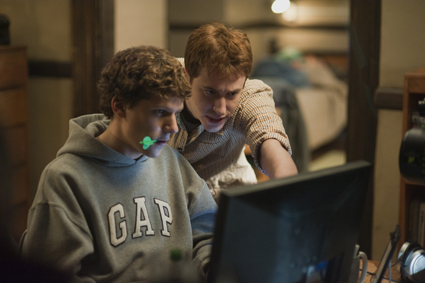
The Social Network
Interestingly, the film is written by Aaron Sorkin (creator of The West Wing) who is on the record as saying that the social connections of FB don’t interest him; his only connections with others online are through email (Mark Harris, “Inventing Facebook,” New York Magazine, Sept 17, 2010). Perhaps that is why The Social Network has garnered such a huge following. Its narrative is peculiarly old-fashioned in many respects, centring on a protagonist, Mark Zuckerberg, who engages in spectacularly fast-paced witty dialogue (like something from a 1940s film), but is unable, ironically, to make emotional connections with others. The film successfully sets up the disconnect between his aim for the website (to help bring people together, or more accurately, boys get laid) and his inability to even acknowledge the feelings of his girlfriend. But it’s clear the Zuckerberg character has been embellished. Novelist Zadie Smith argues: “The real Zuckerberg is much more like his website…Controlled but dull, bright and clear but uniformly plain, non-ideological, affectless” (“Generation Why?”, The New York Review of Books, Nov 25, 2010). Not enough characterisation for a hit film, Sorkin rightly guessed.
Smith also observes that while, in his non-fiction form, Zuckerberg concentrates on the word “connect” with an almost missionary zeal, the reality of the connections people make on FB are less interesting, primarily superficial, so much so that the novelist ended her relationship with FB altogether, finding the experience of going cold-turkey from such an addiction difficult. MIT professor Sherry Turkle, in her new book Alone Together, argues that the uptake of digital technologies is making society less human: “Under the illusion of allowing us to communicate better, it is actually isolating us from real human interaction, in a cyber-reality that is a poor imitation of the real world” (Paul Harris, “Social Networking Under Fresh Attack As Tide of Cyber-Scepticism Sweeps US,” The Observer, guardian.co.uk, Jan 22, 2011).
Ben C Lucas, in his soon to be released film Wasted on the Young, which screened in competition at the 2010 Sydney Film Festival, nurtures this theme, exploring the (virtual) headspaces of rich high school students in Perth who survive in strangely alluring yet empty competing worlds where adults don’t exist. Lucas melds text-based digital cultures seamlessly into the visual style and narrative of the film: “…the ‘isolation through technology’ thing played a big part in Wasted but that’s only because it’s the way people talk…It’s a basic part of our day to day but the underlying principles of bullying, of abuse, of exploitation of the technology, are as old as civilisation…the tools change, maybe enhance it, but the way we treat each other remains. If we had ignored or excluded texting and instant messages from Wasted it would have felt less authentic, in my opinion. Graphically we tried to involve it in the environment of the film so that it would just feel like another form of dialogue—part of the world.” (Conversation via FB, Jan 24, 2011).
With so much fictionalisation of character happening online, through avatars, the audience response seems to be an anxiety about whether the characters, or the film itself, are real. Much of the debate around The Social Network in the US centred on the extent to which Mark Zuckerberg’s character had been made up for the purpose of the film. At the Q+A screening of Catfish I attended, much of the audience time was spent questioning the filmmakers as to whether or not the documentary was a cleverly disguised fiction. With the recent release of docos like Banksy’s Exit Through the Gift Shop and Casey Affleck’s I’m Still Here, it’s getting increasingly (and wondrously) difficult to see where the borders of fiction and fact blur. And it’s not surprising, given the content of Catfish, that the audience is sceptical.
Catfish centres on a New York photographer, Yaniv Schulman (the film is co-directed by his brother Ariel), who meets an eight-year-old girl, Abby, on FB, becomes her Friend (attracted by her precocious ability to paint) and is gradually introduced to her family and friends (via FB), eventually falling for a spunky older sister, Megan, whom he gets to know over the course of eight months, through an exchange of text messages, status updates and jpegs. When various forms of communication start looking dodgy (Megan posts him songs she’s supposedly written that turn out to be just downloaded from YouTube), Yaniv decides to grab his satellite navigation system and head to Michigan to meet her, arriving unannounced.
What he finds reveals as much about the nature of FB, and the desire to connect, as the surprising naïveté of Yaniv. (THE MEDIA HAVE BEEN WARNED NOT TO REVEAL FROM HERE ON IN SO STOP READING NOW IF YOU HAVE TO.) The family he has got to know are, in essence, a construct. Abby and her mother Angela do exist but Mum has populated FB with an entire world of avatars—family members, friends, all with unique voices and stories, that she maintains late into the night after Abby has gone to sleep.
It’s a fictionalised narrative of her own, to entice Yaniv’s affections and escape her own difficult circumstances; she is the primary caregiver of two adult males with severe disabilities. FB allows her to ‘make herself up’ and manipulate the world around her so it makes sense, much like the filmmakers’ angle in screening the outcomes. It’s to Yaniv’s credit that, rather than confronting the woman and pushing his agenda of hurt and betrayal, he allows her longing and sadness to unfold. In a sense he has been fictionalising too, imagining Megan, creating a world around her that he wanted to exist, even Photoshopping her image into pictures of his own, creating a virtual romantic couple.
What’s most surprising, given the nature of the film’s central theme—just who can you trust in a screen-based digital world?—is the filmmakers’ apparent surprise at the audience challenges to the documentary’s veracity; in Catfish, everything is mirage. In The Social Network the reality of the enterprise—the cold, hard cash—is the focus. In the end, neither film is about realising your (romantic) dreams, but about how marketing hype and the conversations that follow can make you a star. And then punish you for it.
Wasted on the Young will be released March 3. The Social Network is set for release on Blu-ray and DVD on March 2, 2011. Catfish is screening currently.
Wasted on the Young, writer, director Ben C Lucas, producers Janelle Landers, Aidan O’Bryan, cinematographer Dan Freene, editor Leanne Cole. The Social Network, director David Fincher, screenplay Aaron Sorkin, based on a book by Ben Mezrich, producers Dana Brunetti, Ceán Chaffin, Michael De Luca, Scott Rudin, original music Trent Reznor, Atticus Ross, cinematographer Jeff Cronenweth, editors Kirk Baxter, Angus Wall; Catfish, directors and cinematographers Henry Joost, Ariel Schulman, featuring Yaniv Schulman.
RealTime issue #101 Feb-March 2011 pg. 27
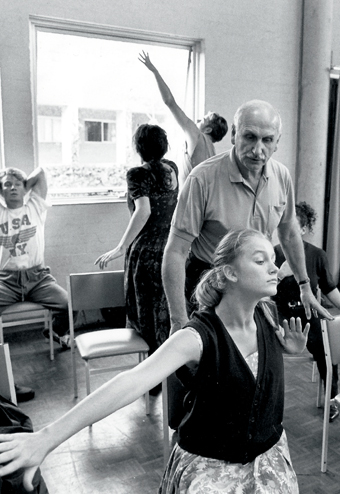
Keith Bain teaching at NIDA Open Day July 1993. Sophie Heathcote in the foreground (NIDA Archive)
$64.95 MIGHT SEEM A LOT TO PAY FOR A 320 PAGE BOOK THAT’S ABOUT TEACHING A MINOR PART OF AN ACTOR’S CRAFT—AN ILLUSION NOT HELPED BY A MUNDANE CLASS PHOTO OF KEITH BAIN DOING JUST THAT AT NIDA ON ITS FRONT COVER. BUT THAT WOULD BE TO WILDLY UNDERVALUE THIS BOOK’S CONTENT. FOR WHAT EMERGES IS THE REVELATION THAT MOVEMENT IS ABSOLUTELY CENTRAL TO THE ACTOR’S ART; AND THAT THE NOW 84 YEAR OLD KEITH BAIN WAS ABSOLUTELY CENTRAL TO THE DISCOVERY OF THIS IN AUSTRALIA.
Indeed, one might argue that our justifiable reputation for ‘physical theatre’ would never have developed if Doris Fitton had not summoned Bain to her Independent Theatre in 1959 and commanded him to begin a movement class. At that time, neither Bain nor the imperious Fitton had any idea what he was going to teach. What’s more, Melbourne’s APG claque would certainly disagree with Bain’s (and NIDA’s) centrality in all this! But Bain was there when Reg Livermore pioneered his first solo in 1961, when John Bell needed him for The Legend of King O’Malley in 1970 and when Jim Sharman tackled Jesus Christ Superstar in 1971.
The claim is further justified by the wide range of adoration offered by Bain’s former students in the book—ranging in time from Reg Livermore to Matthew Whittet, and in their influence on the national scene from directors John Bell, Jim Sharman, Rex Cramphorn, Gale Edwards, Moffatt Oxenbould and Baz Luhrmann to actors on the world stage such as Mel Gibson, Geoffrey Rush, Hugo Weaving and Cate Blanchett.
Do we believe the hyperbolic Blanchett when she declares in her introduction to the book that “His teachings are the foundation of my technique”? And “Keith Bain was and is the biggest single influence on my work as an actor”! It only adds up when her scattered quotes are brought together to include this: “He would brook no laziness, but would support your failure, because in this failure he could sense advancement round the corner; the attempt at what was currently impossible.”
The key to that achievement, of course, was that Bain was a brilliant teacher per se—and his thoughts on that subject should find a ready audience amongst teachers everywhere. Geoffrey Rush brackets him in pedagogy with Parisian clown-master Jacques Lecoq in their ability to “plant some personal awareness of what the parameters of creativity might potentially become in you.” This is despite Bain’s unvarnished description of the young Rush as “the most awkward looking, gangly, pimply student with the strangest physicality that you ever saw—and a power of concentration you wouldn’t believe.”
Bain had become a school teacher in emulation of the glamour he associated with the pre-WWII arrival of such authority figures in a remote town like Wauchope—where am-drams (amateur dramatics) and ballroom dancing were the major forms of relief from simply surviving the Depression. Fortunately, he was lead astray from this noble career when, at 27, he decided to become a dancer—not just one sort, but a polymath developing his improvisatory skills under the tutelage of expatriate ‘modern’ dance sage Gertrude Bodenweiser while earning money on TV variety shows or down at the Trocadero Ballroom (revived this year by the Sydney Festival) where his craving for freedom of expression in the samba, paso doble and cha-cha lead to his becoming The Man who was Strictly Ballroom. For the dancer and teacher was also a dab hand at engaging his students at NIDA—including the young Baz Luhrmann—with a bit of old-fashioned, country yarn-spinning.
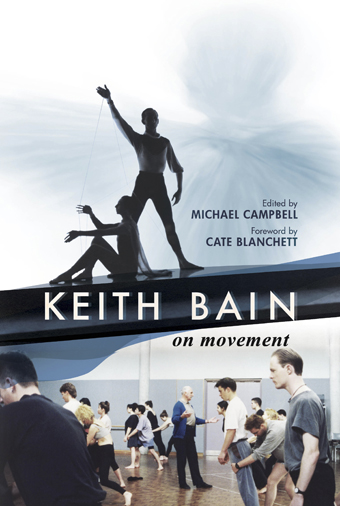
Keith Bain, On Movement
Indeed, the now white-haired Luhrmann declared at the book’s launch that Bain had taught him that learning was a life-long affair. Which makes it all the odder in the book that NIDA’s former bosses John Clark and Elizabeth Butcher fail to take the opportunity offered to explain why they backed both Movement and Bain by taking him on (part-time) in 1965. At least Katharine Brisbane—doyenne of Aussie theatre critics from 1967 until the 80s—used her current hat as publisher of the book to issue a mea culpa at its launch for never once crediting Keith’s contribution to the productions she was reviewing on stage. “We in the stalls knew nothing of his work.”
Bain himself is aware of this gap, using the book as an opportunity to remind directors that, as another former student, Miranda Otto, puts it so succinctly, “Movement goes on all the time”—not just when the text calls for a dance or a fight. Every entrance and exit has to look spontaneous, vital emotions have to find physical expression, and Movement can uncover deeper degrees of truth, subtlety and spectacle. Perhaps the most readable of the teaching chapters is that on Space—a philosophical disquisition as much as a textbook case. As NIDA staff member Kevin Jackson comments, “[Bain] introduced us to the notion of being a god, being truly alive in the magic space on-stage.”
As to Bain’s own skills at on-stage transformation, I can’t do better than quote actress Jeanette Cronin: “Those noble shoulders would collapse under the weight of indignity, that majestic chest would contract into a cave of sorrow, the proud neck could no longer support that once bright visage, the dancing eyes now drooped like raindrops. That wicked mouth lost its wit. He showed us a little finger could be sad; a mouth can contain the fury of a thousand frustrations.”
But then Keith Bain had experienced the “miracle of transformation” very early. It came “when I watched someone as grounded and normal as my barber father offer his hand to my mother and lead her on to the dance floor. Somehow, as if on a breath, their two bodies connected into one new unity as they moved into the figures of the dance.”
Amazingly, Bain also had time off-stage to be, in his own words, “a bloody busybody,” forming and chairing many of the major national and international dance bodies that now exist. But the book covers too little of the process whereby Keith brought together the warring tribes of dance through the simple expedient of a Dancers’ Picnic, quietly organised under the aegis of UNESCO’s International Dance Day. It has more noisily (but more narrowly) lead on to today’s National Dance Awards.
In the last issue of RealTime, Amanda Card reviewed Alan Brissenden and Keith Glennon’s Australia Dances (RT100), a book that had its genesis in the 1950s. Movement is obviously a stop/start matter. Bain began his book in 1993 when he received a Keating Fellowship for that purpose. The writing since has been by him while shaping of the book belatedly fell to the Keith Bain Book Team, notably his successors at NIDA, Julia Cotton and Anca Frankenhaeuser, under editor Michael Campbell. The beauty of this is that Keith Bain can use the word ‘luck’ a lot, while the beneficiaries of his belief in drawing “the best version of themselves” from so many students and casts can fall in behind Hugo Weaving and offer up their versions of Weaving’s, “He is a sort of guru to generations of us.”
Keith Bain on Movement, edited by Michael Campbell, Currency House, Sydney, 2010, hard cover, $64.95
RealTime issue #101 Feb-March 2011 pg. 40
© Jeremy Eccles; for permission to reproduce apply to realtime@realtimearts.net
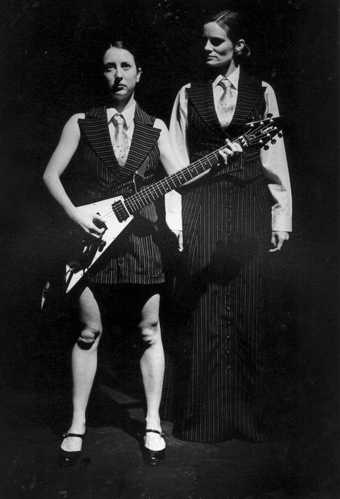
Lisa O’Neill and Christine Johnston, 1998
photo Jodie Ranger
Lisa O’Neill and Christine Johnston, 1998
I am starting a band with my long time creative partner Christine Johnston, I’m not a musician…But that’s okay. Christine has for many years said “You would look great in a band; I want to start a band and put you in it!” The response from my fellow practitioners was “What the f…k do you play?” I replied, “I’ll create my own position in the band!” So I’m now a proud member of what we call RRAMP. I thought it worth mentioning this project as a work that has pushed my performance practice into yet another and sometimes challenging direction. Lisa O’Neill, performer, choreographer, director
EXPLORATIVE BOUNDARY-CROSSING EXPEDITIONS AND COLLABORATIONS DELVING INTO THE AQUATIC, THE FORESTED AND THE INTER-GALACTIC. Aphids 2011 program launches with a BIG BANG, as heart-throb Kamahl serenades and croons mysteries of the universe in VOID LOVE, a concert and soap opera about deep space and astrophysics. Coral spawning, sex and death on the reef are placed under a voyeuristic lens, as Aphids develop CORAL WORK in flotation tanks and on the Great Barrier Reef. Mixed reality gaming infiltrates the coastlines and parklands of Southern Victoria with ATELIER EDENS, an R+D lab developing transmedia experiences and live performances in site-specific and natural environments. Willoh S Wieland & Thea Beaumann, Aphids
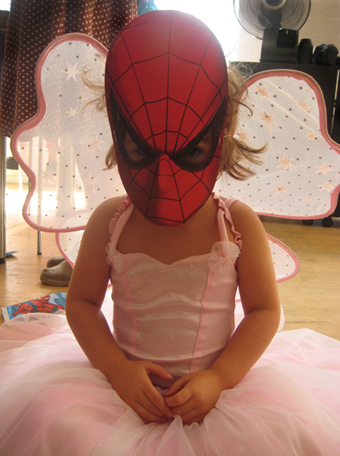
Cordelia Beresford, Superhero, My Favourite Doll
Two ideas I am working on in 2011: My Favourite Doll—video & still photography portraits of young children, boys and girls, with a human-form toy they project personal attributes onto, in some way examining the ‘wish-animism’ that is a normal part of infantile self-object development. I am fascinated by how we gain our sense of personal identity, along with all the cultural and gender-specific role-playing that forms it. Splitting—a multi-image video work, with psychic division as a starting point, portrays two female characters from two different eras inhabiting the same physical space and subconsciously reacting to each other. Cordelia Beresford, cinematographer, video artist
Every night, as we fall asleep, we leave the earth for just a while. In Sweet Dreams the singers of Song Company take flight into a different realm, a world of dreams, just by singing, and whilst singing, by creating images with their shadows and some of the wonderfully simple and self-made creatures of our collaborator, ecological systems designer Stephen Mushin. Think of it as ‘back to the cave.’ Or back to nature. Or back to our childhood. Sweet Dreams. The program will premiere in October before going to South America, then returning to Australia for the company’s final season in December. Roland Peelman, Artistic Director, Song Company
Currently I’m making a work with the Royal Flanders Ballet in Antwerp. In April-May I’ll be with the Ballet Du Rhin in France creating a new version of The Rite of Spring, experimenting with a sound engineer on the compartmentalisation and placement of sound throughout the theatre, including the wings, the back of the auditorium and from the stage itself amongst the dancers. For ADT I’ll make a work incorporating a live illustrator mark-making in charcoal throughout the performance in direct conjunction with the dancers. I’ll also be developing a new work that experiments with the dancing body and live processed video and photographic imagery. Garry Stewart, Artistic Director, Australian Dance Theatre
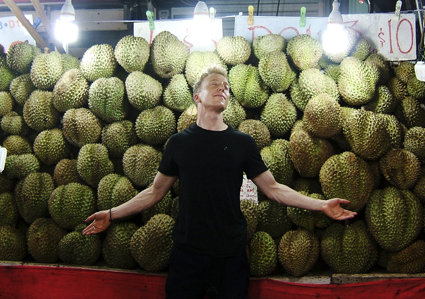
Skye Gellmann
This year I’m moving to a far away island to pursue love. I thought that Melbourne and its relationship with depression was on the cards but I was stolen. I effortlessly think about somebody all day and every moment boils down to seeing them again. For example, I write grants and they all read like dodgy schemes to go overseas! Still, I do have a couple of new art projects (both computer-game/performance hybrids) but the real challenges in my life are: selling all my belongings, re-starting my life and shedding hang-ups. In 2011 I encourage readers to feel 18 again. Skye Gellmann, physical theatre artist
Our year got off to a great start with Gob Squad’s Super Night Shot at the Sydney Opera House as part of Sydney Festival. Jeff Khan joins our team and I’m looking forward to working with him and Bec Dean on a truly interdisciplinary approach to our program. I’m really pleased we’re shaking up our programming model a little. We have two seasons at CarriageWorks—Uneasy Futures and Exchange—but heaps more on throughout the year. Watch out for WALK—it’s off-site and on-the-streets—and a whole range of projects ranging from Applespiel’s residency to the premiere of My Darling Patricia’s new work. Daniel Brine, Artistic Director, Performance Space
Field Theory: the second year of an experiment in sustainability and exchange. We’ll send out 800 handmade gifts. You can put $100 towards art projects that otherwise wouldn’t have seen the light of day. The last year of field theory has allowed for a colour audit of a megamall, an online soap opera about astrophysics starring Khamal and IVF family portraits. Jason Maling, Deborah Kelly and Willoh S Weiland thank you from the bottom of their hearts and pockets. Those in the know have seen glimpses of prismatic auditor socks and flammable magnets in the crevices of homes, streets and legs. 2011 will see four new projects and several gift sweatshops come to life. Lara Thoms, field theory
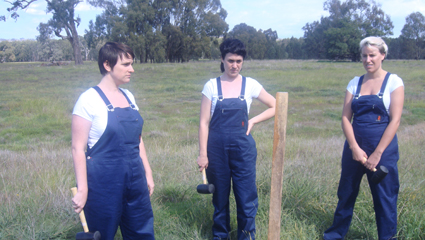
Di Smith, Frances Barrett, Kate Blackmore, (Kelly Doley not pictured), Brown Council, work-in-progress
courtesy the artists
Di Smith, Frances Barrett, Kate Blackmore, (Kelly Doley not pictured), Brown Council, work-in-progress
“This footage is really dark and shaky, but you can just make out the water surrounding the base of the ladder. The water is electrified, so if I fell, I would have been electrocuted…you just had to be there…” Chris Burden. We are excited to be developing A Random Selection of Video Tapes, an exhibition for Artspace in November. Inspired by Burden’s lo-fi documentary about his practice, we will explore documentary filmmaking and performance art documentation to see how they shape our cultural memory. We are especially interested in investigating the notion of ‘truth’ within such documentation and the role of the artist as its harbinger. Brown Council, video and performance artists
We’re excited about:
Only communicating in lists
4 shows we think will be irresponsible
4 Rough Draft creative developments
Not pursuing ‘the truth’
Not worrying about rationality
Sometimes being unreasonable
Not navel gazing
Having nothing constructive to say
Having a beer
No small talk
Theatre that’s:
Not sweet
Not edifying
Illogical
Confused about morality
Might not have big narratives
Not out to make Australia seem normal
Not about making the audience feel educated and intelligent
Contrary. Elusive. Sceptical. Delirious. Bitter. Bothersome. Arousing. False. Tawdry. Light. Archaeological. Foolish. Lewd. Innocent. Debauched. Volatile. Noxious. Spectral. Wanton. Illustrative. Pretty-Ugly. Profane-Sacred. Poor. Sad. Filthy. Tom Wright, Associate Director and Polly Rowe, Literary Manager, Sydney Theatre Company, for Next Stage
My year will start at Peter Brook’s Bouffes du Nord in Paris performing My Dearest, My Fairest, a love story told through music and played only on toy instruments. Celebrating its 10th year, this piece originated at Berlin’s Schaubühne and has since played in opera houses throughout Europe, the bars of Buenos Aires and Tel Aviv and, most memorably, Peter Lehmann’s wine warehouse in the Barossa. From the near ruin of the beautiful Bouffes du Nord, an Asialink scholarship takes me to its very antithesis—the Shanghai Dramatic Arts Centre where I will be their artist in residence. Joanna Dudley, director, performer, singer
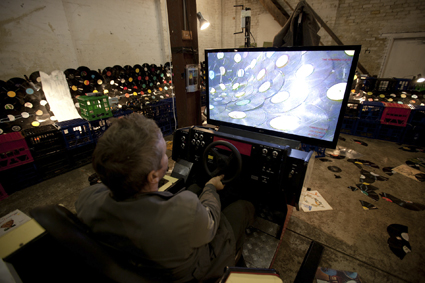
My Vinyl Arcade, Lucas Abela,
photo Alex Davies
My Vinyl Arcade, Lucas Abela,
2011 is going to be busy indeed: I’m currently touring Indonesia. My Vinyl Arcade project is going gangbusters, starting the year in the Australia Council window, then as an installation at Imperial Panda festival in March before being shipped off to Austria for the Donau festival in Krems in April. dualpLOVER is touring ravesploitation act Captain Ahab from LA in Feb. Justice Yeldham has a European tour, and I’m building him new instruments at Cydonia glass studios. I’ll be debuting Mix Tape at Tinsheds in June, a curated exhibition of exposed audio tape/interactive installation. And finally my fingers are firmly crossed that my proposed tap dogs meets merzbow ice-capades project gets off the ground. Lucas Abela, sound performer
2011 is shaping up really well. I’m excited to be working with architects Peta Heffernan and Elvio Brianese on the production design of a hybrid large-scale work for MOFO 2012 in Hobart—a wonderful commission for our 21st anniversary year. A 12-month design development period is tremendous. The work is based on the writing of Constantine Cavafy and will have a fusion of Greek and Egyptian music. Kimisis—Falling Asleep, from our 2010 program, is touring to Darwin, and an American producer is developing USA presentations for later in 2011 and 2012. Constantine Koukias, Artistic Director, IHOS Music Theatre and Opera
2011 starts fast for Insite Arts as producers of MONA FOMA in Hobart in January. 2 Dimensional Life of Her by Fleur Elise Noble will tour internationally with trips to New Zealand, Denmark, USA and the UK. Saltbush, a co-production between Insite and Compagnia TPO [creator of immersive, interactive theatre for children] from Italy, will tour to Adelaide Festival Centre, ArtPlay, Castlemaine Festival and then Korea. Mirazozo by Architects of Air will return to Australia after a successful season on the forecourt of Sydney Opera House. In between we’ll be showing a new work—The Drawing Project by Fleur Elise Noble. Lee Cumberlidge, Insite Arts
In 2011 some things fascinating me are: Depression-era folk furniture, Neolithic jewellery and objects, greenwood carving, gleaning urban timber, Modernist abstract sculpture and remnant vegetation on battlegrounds. In February I have two exhibitions: Polygon Wood at Greenaway Art Gallery opening on the 16th; and a group show at Artroom 5 opening on the 20th. I will then get packed up, ready to travel overseas to take up my Anne and Gordon Samstag Scholarship. With my destination in the laps of the application gods it seems I will spend the latter part of 2011 in either the USA or Portugal. Bridget Currie, visual artist
I am absorbed by futures and fictions with Lizzie Muller and a host of Australian artists: time travel, walking on Mars, shrinking things with ray guns, civil wars fought along the gender divide, cloud seeding, interspecies relationships, survival kits, fembots and more. Awfully Wonderful: Science Fiction in Contemporary Art opens in April. Throughout the year Performance Space is walking with artists around various Sydney locations. Later, we are exploring the body, its viscidities and exchanges. Now I’m sitting in the office with Jeff Khan talking more about the future—2012: a decade after we made first contact (really!). Bec Dean, Associate Director, Performance Space
Hurtling out of a commission for the gala opening of the Heath Ledger Theatre, State Theatre Centre—a new work using layers of animation mapped onto multiple screens with dancers navigating their way into and around a forest of light. Floating into a month preparing images of new digital art works for an exhibition in May. Flying to Melbourne to work on Winterreisse directed by Matt Lutton with Paul Capsis, Alistair Spence George Shvetsov and dancer James O’Hara. Approaching the third phase of creative development of Kings and Queens, a physical theatre production with painter Patrick Doherty, writer Reg Cribb, composer Jonathan Mustard, actors vocalists and dancers. Chrissie Parrott, choreographer, producer
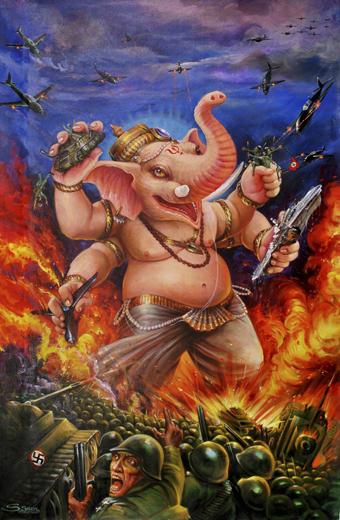
Ganesh Versus the Third Reich, Limona Studios, Mumbai
Back to Back Theatre’s new work Ganesh versus the Third Reich premieres this year. Constructed as a play within a play, the first narrative is the epic hero’s journey of Ganesh travelling from India to Nazi Germany to reclaim the Swastika (the ancient Hindu symbol) from Hitler. The second narrative is the moral and ethical journey that the makers of the play undertake in presenting the first narrative. The further Ganesh travels, the more enmeshed its protagonists become in the politics of appropriation. If you are a small theatre company from Geelong, Australia is it okay to rewrite Asiatic and European history? Should authors be allowed to craft fairytales, satires and comedies about anything? Back to Back Theatre Company
I’m most looking forward to a show that kicks off PICA’s exhibition program this year. John Gerrard is an extraordinarily accomplished Irish artist who has been using real time 3D, a technology mainly used in video gaming, to create eerily realistic animated video works that depict bleak but compelling agri-industrial scenes in America’s Great Plains. For this show, John’s first in Australia, we’ll see chilling imagery of infamous dust storms in Texas and Kansas during the 1930s, daily circumnavigations of a fully automated pig farm in Oklahoma and the relentless movement of a lone oil derrick in Colorado. It’s strangely powerful stuff! Amy Barrett-Lennard, Director, Perth Institute of Contemporary Art
What is ahead for Stalker? The best indicator is a snapshot of today—several of us researching a new work called Encoded. We are discussing developing photogrammetry techniques to enable real time virtual cameras to interact with live performance. It all comes from the use of photos to generate point clouds that we can then animate. The BIG question from today was how to embody such heavy use of technology in a physically meaningful way. After all Stalker has been a physical theatre company for well over 20 years! But we did start the day with yoga, and catapult training! David Clarkson, Co-artistic Director, Stalker Theatre Company
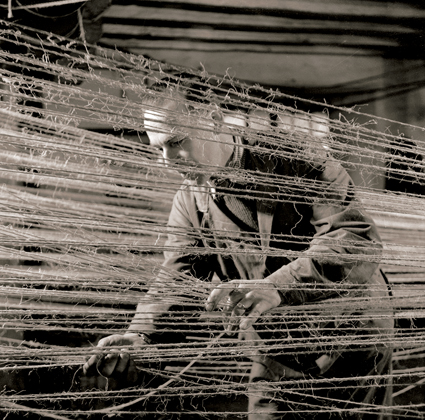
Chunky Move, Connected
photo courtesy Chunky Move
Chunky Move, Connected
After 15 exciting years of Chunky Move I am leaving at the end of 2011 with a bang! Turning on some sweet middle-aged moves in my solo show, Faker, at Dance Massive in Melbourne and am most excited about premiering two large-scale works: Connected—kinetic sculptor Reuben Margolin, lots of mathematics, composers Robin Fox and Oren Ambarchi, five extraordinary dancers, lighting Ben Cistern, costumes Anna Cordingly; Assembly—Richard Gill, Nick Schlieper, Victorian Opera, 50 singers, 8 dancers, chants, Gesualdo, Ligeti, a cappella, mass, crowds and power.…Oh, and if you are in Melbourne, a huge party in December!” Gideon Obarzanek, Artistic Director, Chunky Move
In 2010 we explained the GFC from what we reckoned. In 2011 we’re working out “Who’s The Best,” out of us…from what we reckon. And what the audience reckons. The show/competition will be at STC, then touring Oz. We’re all excited to hear the scores. After that we might have a crack at figuring out Death. Probably from what we reckon, and maybe some other sources too. For us this year’s all about drag, imposters, impressions, bad acting, The Biggest Loser, birth, auditions, shamans, epitaphs, avatars, and those nightmares where you have to give a speech but haven’t got any pants on… Mish, Zoe, Nat, Post performance collective
Tracing lines beyond the map. Deleuze and Guttari’s rhizome engenders an operational velocity that is ever apparent, though sometimes perhaps only to myself. There are lines and tracings that flow through Revelation and other aspects of theoretical, literary, curatorial and programming work with which I continually engage, both above and below the maps of culture. Presently deep in exploring trauma and film academically, this may well contribute to interesting decisions subsequently. As ever, I feel the need to be fighting the powers of boredom and stasis, searching for new films and expressions that challenge and stimulate, striving to present the limitless potentialities that can be reached. Jack Sargeant, Program Director, Revelation Perth International Film Festival, author, nihilistic bon vivant
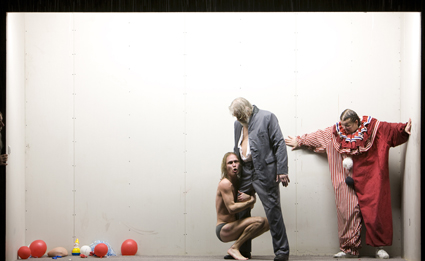
King Lear, director Benedict Andrews, Icelandic National Theatre
photo Eddi ljosmyndari
King Lear, director Benedict Andrews, Icelandic National Theatre
I’m in Reykjavik sitting at the kitchen table. Outside are the silver waters of the bay. One moment, the low sun shines, next a blizzard blows in from the mountains, or a thick fog from the sea. It’s a sublime, cosmic theatre—ideal to watch while preparing my version of The Seagull (Belvoir, June-July). The idiom and milieu will be distinctly Australian—my bones longing for Australian summer—but the turbulent Icelandic weather seeps in. I’m thrilled to be returning to Chekhov in 2011—to the dramatist of what Giorgio Agamben calls “the time that is left.” Benedict Andrews, theatre director
I am looking forward to building a rich practice outside of my project-based work and hope to find myself in a room with other performers as much as possible this year. There are a few things on the boil that I’m most excited about: Whelping Box with Branch Nebula and Clare Britton—a two-hander that takes on dogs, men and gods; regrouping with the raw joyous energy of Whale Chorus (Janie Gibson, James Brown); and finding ways to tour Hole in the Wall (with Clare Britton), something we want to see mature after a successful premiere in 2010. Matt Prest, performance maker
2011 promises big things for Stompin! We are exploring our inner rev-head with the premiere of I ♥ Cars at Ten Days on the Island. Set in a car mechanic’s workshop, this show is a site-specific, multi-art mash-up that explores our love affair with cars and the way they literally connect and separate us. Stompin’s incredibly talented team of artists, including Adam Wheeler, Emma Porteus, Philip Peck from Bluebottle and Dan Speed, will collaborate with 15 young, non-professional performers from around Launceston to create a performance event that shifts between abstraction, representation and documentation. Stompin says art/youth/community 4ever. Sarah McCormack, Executive Producer, Stompin

Polytoxic, l-r Fez Fa’anana, Leah Shelton, Natano Fa’anana, Lisa Fa’alafi, Mark Winmill, Amanda-Lyn Pearson
photo Sean Young
Polytoxic, l-r Fez Fa’anana, Leah Shelton, Natano Fa’anana, Lisa Fa’alafi, Mark Winmill, Amanda-Lyn Pearson
2011 will bring us a whole lot closer to realising two new works, kicking it off with a scratch showing of The Rat Trap at the Brisbane Powerhouse’s World Theatre Festival. Based around a twisted tale of blood ties, revenge and rodents, it’s a chance for all six Polytoxics to meld our gutsy physicality with aerials, theatricality and even some WWE wrestling moves. Also on the cards is further development of a smaller work, Lost Dances, which arose from research into lost, suppressed and archived dances of Samoa; a partnership with Queensland Theatre Company; a residency at the Brisbane Powerhouse; and our usual antics. Polytoxic, dance ensemble
2011 will be a year for regaining my physical and mental faculties after two years of art making and dissipation in the fine but exhausting city of Berlin. I’ve sublet my Neukölln flat, god bless it, to establish a new nest in Katoomba. A collaborative project, between myself, my partner and the Goddess of the Hearth. This Rabbit year will be one of quietude and completion. The focus: finishing a large scale writing project (a book of ghost stories) too often neglected in favour of the more obnoxious demands of performing. The body will get out there too: the epic cycle Songs of Rapture and Torture will be performed in its pent-amorous entirety; new works, developed and performed overseas, most recently at InBetweenTime, will see Australian premieres. Until then, I’ll be writing, bottling preserves and learning new skills domestic and esoteric. Sarah-Jane Norman, artist, writer
Looking forward to adventures…turning a most impossible ear toward the lost opera Minotaur—the Island (Chamber Made Opera, Ten Days on the Island)…to salt winds on the Bruny Island ferry…to living with ‘the company’ and ‘lunching’ with the audience. I am squinting toward horizons where wild paths of works flicker far into a year. And, after Falling Like a Bird (Ladyfinger) soft landing in Italy on an escapade, if the little puppet sisters of A Quarrelling Pair (Aphids) fly off to fight again about their rooms, their milk and whether hearts are big or small. Margaret Cameron, poet, performer, director
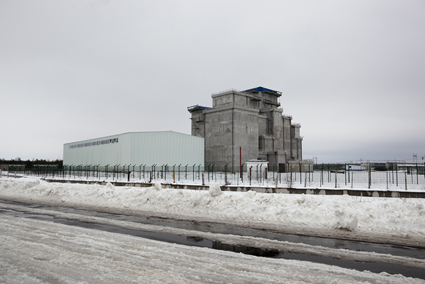
Precarious, Merilyn Fairskye 2011
Precarious (digital video, 65 minutes) evokes the aftermath of the explosion at Chernobyl 25 years on. This road movie takes the spectator on a journey from the shores of the Black Sea to the frozen heart of Chernobyl, passing through desolate, snowy landscapes littered with abandoned villages. Squatting in this icy wasteland, the ghostly sarcophagus of Reactor #4 is a constant reminder of the threat still lurking. Winter exerts its hold, ice keeps the hidden radiation at bay, but the spring thaw will once again release the surrounding rivers’ toxic flow. Accompanied by testimony from a group of veterans of the disaster, Precarious bears witness to the folly and resilience of humans and to nature’s fragility. Merilyn Fairskye, artist: photomedia, video, installation
The nexus between contemporary art and environmental sustainability will underpin Arts House in 2011 in two programs—Six Degrees and nude works. Six Degrees brings together the notion of six degrees of separation (sometimes known as Human Web) and the idea that if global temperature increases by six degrees Celsius the world will be uninhabitable. These two ideas underpin the Arts House Six Degrees project, inviting sound artists to collaborate and respond to climate change. In August, nude works is a mini festival of contemporary performance and live art that is elemental, stripped back and essential. Nude works may not all be performed entirely naked! Steven Richardson, Artistic Director, Arts House
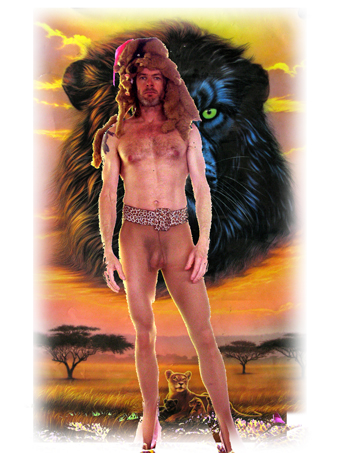
Lee Wilson, Branch Nebula, The Whelping Box
photo Mirabelle Wouters
Lee Wilson, Branch Nebula, The Whelping Box
We are excited about birthing our new performance, Whelping Box: from fighting dogs to mythological beings, in collaboration with Matthew Prest and Clare Britton. The project also extends to a stand-alone video, with Denis Beaubois and Steve Couri. We head to Melbourne in March to find new audiences for our recent work, Sweat, at Dance Massive. Next we brave new territory with a site-specific creative development when Concrete and Bone Sessions infiltrates the local skate park at night with nine artists utilizing BMX, skating, parkour, martial arts, dance and gore. Later in the year we explore artistic and familial connections when we head to Europe. Lee Wilson & Mirabelle Wouters, Artistic Directors, Branch Nebula
I spent day one, 2011, in Jakarta, a city of 15 million people that runs on subsidised petrol and hums with the sound of as many motorbikes. Jakarta sprawls as far as you can imagine, with massive shopping malls and countless kampungs crammed with warungs selling food, cigarettes and pulsar. I hope 2011 remains true to its first day. I am looking forward to working at Tin Sheds and hope to find ways of linking artists here with those from around our region. We need to turn the world upside down or we are all stuck in a Jakarta traffic jam. Zanny Begg, Director, Tin Sheds Gallery
“I do understand the anxiety and indeed fears that Australians have when they see boats…” Is Prime Minister Julia Gillard imagining herself to be an Eora woman witnessing the arrival of the First Fleet? If so, what an astonishing piece of theatre! Heiner Muller said, “As long as freedom is based on force, and the creation of art is based on privilege, works of art will tend to be prisons…” At the VCA Grant St. Theatre, Feb 17-20, Doomstruck Oedipus, Why Are You Here? Parts 1-2-3 will be asking, among other things, What is the role of performance in Australian society today? Ben Speth, theatre director
The sharp trill of an alarm clock launches Clocked Out into 2011. After 10 years of the same dream, forays into the wide alley searching for foreign objects, cleaning up the messy spills of Dada, we finally say enough is enough. It’s time to Wake Up! to the everyday sounds around us. [Wake Up! debuts March 23, 6:30 pm @ Queensland Conservatorium.] Also in 2011: watch out for our Ensemble in Residence series at Queensland Conservatorium, The Trilling Wire Series at Judith Wright Centre, the Radio Plays project at Queensland Music Festival, and a new collaboration with Continuum Sax! Erik Griswold & Vanessa Tomlinson, Clocked Out
2011, despite being an odd number, seems to have a lot of symmetry to it. It’s been 10 years since we created Same, same But Different and with it Force Majeure. 2011 sees us complete our collaboration with Sydney Theatre Company—Never Did Me Any Harm—a work about contemporary attitudes to raising children, something of a minefield we’ve discovered! Also looking forward to participating in the Adelaide Film Festival’s The Hive lab; presenting Not In A Million Years at Dance Massive; conducting our own lab, CULTIVATE; directing a play, FOOD (hopefully for Belvoir); and welcoming new CEO Lisa Havilah to CarriageWorks with open arms! Kate Champion, Artistic Director, Force Majeure
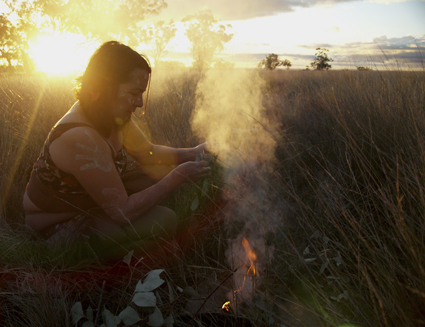
Lily Shearer leading a smoking ceremony at the posts
photo Michelle Blakeney
Lily Shearer leading a smoking ceremony at the posts
This year My Darling Patricia will premiere Posts in the Paddock. In 1900 relatives of mine were murdered by Jimmy Governor. The film and novel, The Chant of Jimmie Blacksmith, are based on his life. Actor LeRoy Parsons (Jimmy’s great-great grandson) and musician Aunty Rhonda Dixon-Grovenor will join My Darling Patricia on stage. Australian history is full of silences. We want Posts in the Paddock to allow Indigenous and non-indigenous artists to speak into that silence together. For us, it’s the culmination of three years of research and consultation. Also really exciting: our Malthouse commission, Africa, on tour with Mobile States and to STC’s Next Stage. Clare Britton for My Darling Patricia
2011 sees me in the middle of my three-part solo series, Trilogy. It explores the potential of durational and intensely physical choreographic forms to encounter the body as both a site and agent of continual becoming. In each piece the figure is restrained by an extremely minimal choreographic structure that the internal forces of the body rebel against, producing visceral micro-choreographies of rhythm and vibration. The first piece, Thousands, will return to Melbourne for Dance Massive and Cannibal, the second work, will have Sydney and Melbourne seasons. In October I’ll begin working on the final piece in the series. Matthew Day, dancer, choreographer
“Minotaur is a place—the island of Minotaur. The music is tense—just out of reach—fracturing and breaking into bits—travelling through corridors. The objects are the island, and are moved around the space like flotsam from a shipwreck. The characters are: Ariadne with a sound puzzle box, Venus in a man’s suit, Pasiphæ in a white hand-knitted dress, Theseus dressed as a matador, Dædelus, Monteverdi in a medieval dress, the small Minotaur with fur boots, Icarus with a gull’s head and a harpsichord. ‘She could have music depending on the wind.’” From text by Margaret Cameron & David Young. Chamber Made Opera, Minotaur, Bruny Island, 2011 Ten Days on the Island
2011 marks a clear shift in my practice. After mainly working as a solo artist for many years, my focal point will now be collaboration with other dancers, both on group works and on solos. I’m especially excited about the premiere of my new work, Mountains Never Meet, at Riverside Parramatta in August. It’s a collaboration with young footballer and performance maker Ahilan Ratnamohan and eight untrained male performers from Western Sydney. Exploring the connection between sport and art, the work aims to playfully challenge our notion of what dance is and who can be considered a dancer. Martin del Amo, dancer, choreographer
2011 starts with Embedded (trombone Rishin Singh, accordion Monika Brooks, double bass Sam Pettigrew) opening the Now now Festival and till death us do part. February: Bogong AIR Festival, playing in the high country of Victoria. West Head Project: releasing our first CD, a closely woven fabrik, on Splitrec. Blip (with bassist Mike Majkowski) release calibrated and tour the East coast. March-April: collaboration with Tess de Quincey. August: MURAL launches a CD at the Rothko Chapel, Houston, recorded there in 2010. November: first trip to Chile. I hope lotsa bush music in between. Jim Denley, improvising musician
Not travelling, or tooling ninja-style on productions, I’m bunkering down into the literal moon crater of COFA this year. These next two years I am trying to establish an understanding of digital animism, a haunted and blooming soul of video. I need to explore this state where the multiplication of video transcends itself and hidden meaning appears. VIVARIA will tour in Mobile States and I’ll be in Campbelltown making a fictional documentary on the imaginarium of shopkeepers. Every few weeks I can emerge to add life to the gestures of puppets and the enigma of performance art, still the wildest state of living. Sam James, video artist/projection designer
2011 will see my next feature film, Falling for Sahara, starring an entire cast of African refugees, premiere at the Melbourne International Film Festival in July…all very exciting. At the moment I’m writing a play about Vietnamese weddings for Belvoir and creating a four-hour dramatic mini-series for FremantleMedia about capital punishment, which we hope will go into production in late 2011. Khoa Do, filmmaker
2011 is a year of recovery. In the aftermath of the floods I’m provoking questions about the role of theatre in our society. How do we respond to the social trends, demography, geography and the uniqueness this brings to our storytelling? It’s not enough to just devise a program and expect people to come to it anymore. Engagement, Diversity and Excellence have become my mantra. I’m looking at creating an Indigenous Program, developing a Studio Program to give artists space and resources to create work, take the next step and explore their craft, and also trying to unashamedly increase the audiences for theatre in Queensland. Wesley Enoch, Artistic Director, Queensland Theatre Company
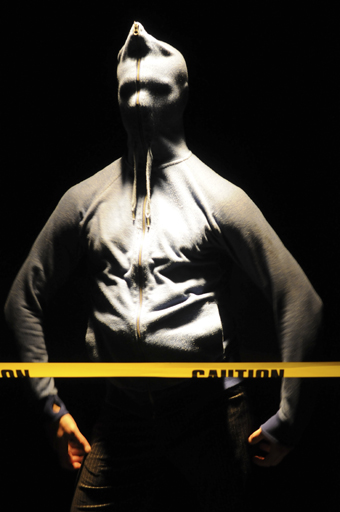
Dean Walsh
photo Heidrun Löhr
Dean Walsh
Granted an Australia Council two-year dance fellowship, my independent practice is presented with a renewed oxygen supply for more in-depth experimentation and an expansion of my interest in planned future works. Research, apart from many weeks investing in solo and group work and more frequent scuba diving, will also involve attending conferences and interviewing experts on environmental and species un/sustainability interfaced with exploration of our everyday perceptions of these realities. I’m taking my dance reflections out of the sub/urban and into the ocean and back again. Performance Space has invited me to undertake a stage one performance ‘research touchdown’ this coming May as part of their Uneasy Futures season. This new work is called Fathom. Dean Walsh, choreographer, dancer, Sydney
Dwelling Structure: a new music work that premieres in May. For this operatic project without singers, the sound of the house is the main protagonist in a collection of time-use episodes. Greatly inspired by textual development with writer Cynthia Troup and visual assemblage by Neil Thomas and very happy to be part of the Chamber Made Opera house. As David Foster Wallace, our new fave author, writes in Infinite Jest: “almost nothing important that ever happens to you happens because you engineer it. Destiny has no beeper; destiny always leans trench-coated out of an alley with some sort of ‘psst’ that you usually can’t even hear because you’re in such a rush to or from something important you’ve tried to engineer.” Madeleine Flynn and Tim Humphrey, musicians, composers
2011 looks bright, with some great projects coming to fruition early in the year. My ANAT Synapse residency with the Bionic Ear Institute culminates in a concert of newly commissioned works for the bionic ear on Feb 13 and two exciting new dance works. Connected, with Chunky Move and Drift by Antony Hamilton feature my sound designs in the Dance Massive festival in March. A new album with double bassist Clayton Thomas is ready; I’m still editing the 3D shoot of the laser show, reading a lot about holograms and giant Theremins, planning tours…the rest is highly classified. Robin Fox, sound and visual artist
Halcyon has always been about championing composers, so we’re thrilled to be launching our inaugural young composers project, First Stones, where participants will develop a new song for voice and chamber ensemble; the new works will be on show in Halcyon’s final concert for 2011. As well, we’ve commissioned a major chamber work from Sydney composer Andrew Schultz, to be premiered later this year in a program with George Crumb and Joseph Schwanter, and in March, Jenny, Andrew and Alison are Artists in Residence at Bundanon to share and develop ideas for the new work in relaxed and inspirational surrounds. Alison Morgan & Jenny Duck-Chong, Halcyon, new music ensemble
This is the year of time and practice, particularly primary research and its application. This means first hand interviews with informers for our work, engaging directly in the struggles that we reference, spending open ended time in pivotal locations, sending probes into our own bodies and cutting things out…I’ll be labouring on Hydra’s theatre work Prompter Live Studio and a new project based around a SymbioticA residency exploring empathy, abstraction and broken narratives. I’ll be curating performance for a peer exchange project called WASTE with an accompanying zine from Mother [has words], looking, sans sentiment, at what discarded conceptual efforts suggest. Sam Fox, director, Hydra Poesis
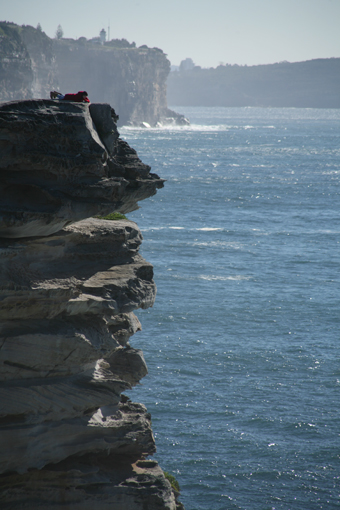
Fiona McGregor, Vertigo, 2009, still from performance video / multi-channel video installation
photo Julia Charles
Fiona McGregor, Vertigo, 2009, still from performance video / multi-channel video installation
Water—fundamental to our existence; the functioning of our bodies, the life cycles of our environment. Its scarcity across much of Australia has become one of the most urgent issues facing our society; its rare, violent overabundance causes chaos and destruction. It nourishes and yet can be used to torture both body and psyche. Through November Fiona McGregor will produce Water, a suite of installations and durational body-centred performances across all the Artspace galleries, both evoking the magical, poetic qualities of water and exploring states of relationship with it—saturation, absorption, deprivation. Blair French, Executive Director, Artspace
An ‘environmental’ triumvirate in 2011. Firstly, Site Listening, a term I coined to encourage the activation of the ears and reduce the dominance of our visual perception, will be a focus with a Queensland version to be unveiled as part of the Queensland Music Festival. Secondly, my project with Werner Dafeldecker, The Cold Monolith (based on our work in Antarctica under invitation from Argentina’s Dirección Nacional del Antártico), will be presented on Germany’s SWR radio and also as an installation at festivals. And finally I’ll be working all year on a series of audio/media works based on problematising contemporary understandings of [the Japanese aesthetic philosophy] Wabi-Sabi.
Lawrence English, room40
Ever wondered what a genre film director like Enzo G Castellari would have created if he were a choreographer? My debauched lifelong obsession with the avant-garde works of genre celluloid trailblazers found its way into my latest dance work, DRIFT. DRIFT fell from its loftier concerns of “architecture, the body and their intangible relationship” to “devising dystopian pagan rituals of the future!” The project began as a quest to discover Melbourne’s atmospheric derelict urban haunts. Like a location for film instead of theatre for dance, the location is a vessel for a nostalgic romance with B-grade sci-fi post-apocalyptic fantasy.
Antony Hamilton, choreographer, dancer
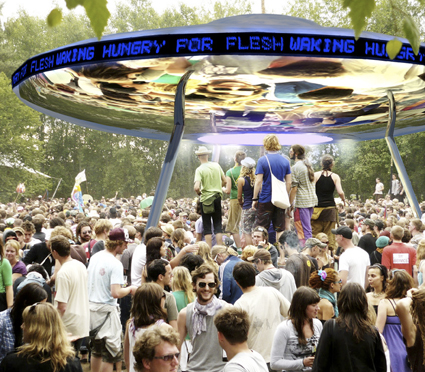
Close Encounters (3D render/composite), Jordana Maisie
In 2011, Close Encounters takes off. A large-scale interactive sculpture raised 2.9 metres: at a distance it appears as if a luminous UFO is hovering above the undulating festival audience, transmitting messages to the crowd as they move through the site. When walking underneath it, Close Encounters acts as a portal connecting you to the sky. The work provokes participation through text messaging and LED technology, inviting punters to ‘text’ the number displayed. By responding to the text provocations, a collective conversation begins—the audience co-creating a real time narrative as the festival unfolds. Jordana Maisie, new media & electronic artist
We’ll be creating a new stop-motion world in 2011. Interactivity and performance will get a look-in as we gear up to create a new multi-viewer experience to premiere towards the end of the year. We can’t wait to visit MONA [Museum of Old and New Art, Tasmania] where our 2010 work You Were In My Dream will be showing August–September, and the Mornington Peninsula Regional Gallery in May. We’ll be running stop-motion workshops, dreaming up new film ideas, sculpting miniature scenes and making faces. Isobel Knowles & Van Sowerwine, media artists
so what might be ephemeral practices? / launch of hard soft john barbour survey publication main gallery vernon ah kee tall man bonita ely murray river punch elizabeth newman + nicki wynnychuck installation nasim nasir women in shadow kit wise projections james + luna cheryl l’hirondelle mind the gap osw (bianca hester + terri bird) / noel sheridan project space ray harris videos ane damcho drolma one moon christine collins drawing installation nien schwarz residency + installation / odradekaeaf window box february through august curated by ray harris + matthew huppatz / wura-natasha ogunji videos / launch of new performance/installation/project space. Domenico de Clario, Director, Australian Experimental Art Foundation
Prediction for Luke George: You will reignite collaboration with your spiritual-art-brother Miguel Gutierrez (NYC). Late February is a powerful time for you both. You will meet and dance every day through a CultureLab Residency in a Melbourne House of Arts. Joining the power of your minds/bodies, you will develop supernatural perception and the ability to slip between multiple performance modalities at the speed of light. Through a completely illegitimate process, you will research what is the biology and neurology of performing. You will invoke a space that resists opinion and evaluation and invite an audience to exist within the live-ness of this dance. Luke George, dancer, choreographer
In November Marrugeku will partner with Atamira Dance Collective to present the third International Indigenous Choreographic Laboratory in Auckland. The labs (Sydney 2009, Broome 2010), explore resonances and differences in contemporary Indigenous dance-theatre from Africa, New Zealand and Australia. New influences, processes and cultural pathways are explored and their relationships to traditional practices. Each laboratory is steeped in the local cultural context and artists work from their own experience of being Indigenous artists or working in Indigenous contexts. IICL3 will be lead by New York based Zimbabwean choreographer Nora Chipaumire and Maori choreographers Louise Potiki Bryant and Charles Royal. Rachael Swain, Dalisa Pigram, Co-artistic Directors, Marrugeku
Critical Path 2011, Choreographic Research
■ ■→ IDEAS of bodies orientated CHAOS, falling, finding seeing; critical characters turning spaces; ■ musicality, hand movements past improvisations → artist’s language lucid notices watching them watch images. ■
■ Constructed lit surfaces connecting ■ ↔ ■ obscured frames; movement, blurred by motivation choreographies, embodied learning shared documented. Participation transitions, contact forgotten speed passing danced behind >>>> backs >> diagonally making circles weighting intention>>>>>> reviewing dramaturgically absurd interventions ■
↓↑With content of arms pelvis head ears eyes facing pointing fingers mapping directions thrown front toward distant tangents of irritation; slowly, swaged ■ Of imagined time future training permissible beyond >>>>> counting >>>>>> audience’s inspirations ║ reaction fast ↔ finding forgiven feet, shins, knees, thighs, torso ║ surface ↓↑ fading expectation blacked out. •∞
Margie Medlin, director Critical Path
•∞↔→↓↑║
Whilst my passion for natural systems, morphology and cultural histories has grown apace, my desire to work with galleries and museums has gradually diminished—displaced by my enthusiasm for environmental projects that directly engage public space and community. 2011 will see me on the high seas again, working from my boat Sisu in the Abrolhos Islands (WA) to develop CrayVox, a work for the Space(d) Biennale; then mounting VoxAura, the River Sings for European Capital of Culture in Turku, Finland; and onto Istanbul for ISEA with a sound installation entitled Weeping Willow. Add in a couple of large scale public sculpture commissions and that’s my year! Nigel Helyer, sculptor and sound artist
In 2011 I’m embarking on a feature documentary/on-line project with Melbourne colleague John Hughes to tell the story of the Filmmakers’ Cooperatives which operated in most state capitals in the 70s and early 80s, until in the mid 80s a centralised government bureaucracy effectively closed them down. The project will examine the history of the Co-ops and their aesthetic concerns in a period where filmmakers were deeply engaged with social/political issues. This is an important and overlooked moment of Australian film history which will not only entertain but also be useful to new generations of filmmakers, and essential in any comprehensive appreciation of Australian cultural history. Tom Zubrycki, filmmaker
Concerts with eRikm, Valerio Tricoli, Thomas Lehn and Stephen O’Malley in Europe. PIVIXKI in Canada and NZ, solo in Chicago, tour with Fusinato, Thymolphthalein LP on Editions Mego. New work for percussion quartet and flute that HAS to be better than the music for Kwaidan. Making the solo piano record that I’ve always wanted to make and re-issuing the last one the label shafted me on. Practising Doepfer every day, writing elaborate songs that WON’T be better than Scott Walker, doing my first film in six years, listening harder, reading wider, seeing deeper, remembering to live. Antony Pateras, composer, performer
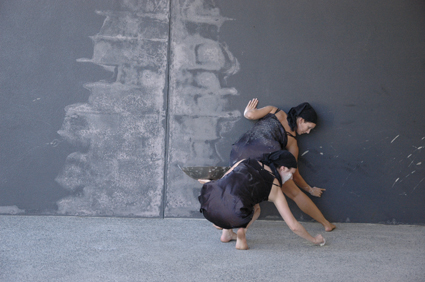
Brooke Leeder, Gabrielle van der Elst, wok, Tongues of Stone
photo Sarah Burrell
Brooke Leeder, Gabrielle van der Elst, wok, Tongues of Stone
After Prague (2003), Athens (2005) and Wellington (2006), Perth hosts the site-specific work of New Zealand’s Carol Brown (choreography), Dorita Hannah (design) and Russell Scoones (sound). Three years in development, Tongues of Stone features 15 dancers carving their way through the city, from the underground central station to the open foreshore. Reminding us of the disappearance of Perth wetlands, Tongues of Stone brings to the surface silenced memories. In a quest to make visible the lightest of art forms, STRUT joins the Barcelona-based Dancing Cities Network and brings its voice to worldwide conversations between dance, architecture, public space and social change. Agnes Michelet, Director, STRUT dance
To be excited about one dance project over another at Campbelltown Arts Centre is too hard. Kathy Cogill and Latai Taumoepeau trying to define what Intercultural work is? Beautiful. There’s a Bright Golden Haze on the Meadow. There sure is. Lizzie Thomson with local amateur actors reworking old musicals. Beautiful. Not to mention Antony Hamilton out on his own with us in cars listening to the radio. Who’s Donna Miranda? You just WAIT! In the meantime, Nat Cursio comes to town to curate a motza. Emma Saunders, curator, dance program, Campbelltown Arts Centre
Decibel are still going strong, in 2011 making a book, releasing recordings and running a subscription concert series. These PICA concerts will take place in the main gallery space so we really get a chance to explore ways of combining sound art and more traditional composition. There is so much great new music being made in Australia right now, and we are excited about playing, recording and writing about it both here and overseas! Cat Hope, director, Decibel, new music ensemble
Performance is the key to my creative thinking at this moment and it has dominated my thinking for the past 10 years. It never ceases to amaze me, that in 2011 Indigenous artists are still constructed as the ‘other’; performing in a space that is only allocated to the ‘Performative of Aboriginality,’ rather than just being artists who are Aboriginal. Why…? I will continue to make work that questions the reasoning behind why there is a lack of visionary thinking and courage to do it differently!
r e a, media artist
It’s about the emotional nerve. Working with artists from across the arts who inspire through their passion and individuality, and with the need to realise their respective visions. 2011 promises a rich palette—a performance of the complete Berio Sequenzas; collaborating with Jon Rose on his Pursuit project; an overseas visit to observe other new music festivals and organisations thanks to a Churchill Fellowship. Also exploring the music of Hannah Kulenty through movement with choreographer Amanda Phillips as well as celebrating the 50th anniversary of Grainger’s death with cellist John Adderson and Vincent Plush. Underpinning all of these activities, I continue to delve into the visceral, intellectual depth of pianism. Gabriella Smart, musician, Artistic Director, Soundstream Festival
2011: the year of collaboration! I’ll be digging alongside Ian Milliss as we embark on our Yeomans Project—about the cultural (and agricultural) phenomenon of Percy Yeomans (an Aussie visionary who invented a special ploughing system in the 1950s). I’ll also be digging through the archives with SquatSpace, as we work towards a 10-year retrospective project at Campbelltown Arts Centre in 2012. Apart from that, my gardening collaboration with Diego Bonetto will continue decomposing itself, at the Sydney College of the Arts. And through all of this, I’ll keep on getting inky at Big Fag Press. Lucas Ihlein, artist
Started the year working with Hitlab NZ to deliver an augmented reality work for the next Adelaide Film Festival…excited because it uses technology just on the edge of deliverability so we have to keep trying to solve the maze of what we can imagine and what is actually possible. Using coral specimens from a trip I made to Lord Howe Island last year to the southernmost coral reef and drawing data feeds of bleaching alerts from NOAA. The health of reefs is urgent so I thought about the sugar bowls of the Abolitionist movement and decided to do my first work for mobile phones. Lynette Wallworth, media artist
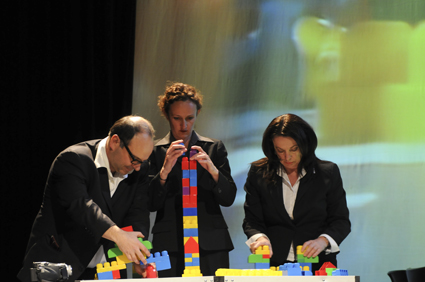
Alan Flower, Kym Vercoe, Yana Taylor, The Table of Knowledge, version 1.0
photo Heidrun Löhr
Alan Flower, Kym Vercoe, Yana Taylor, The Table of Knowledge, version 1.0
In 2011 version 1.0 are presenting new work all over the place—including Bathurst, Launceston, Sarajevo and our hometown of Sydney. What I’m most looking forward to is The Table of Knowledge at the Illawarra Performing Arts Centre in Wollongong, exploring an infamous corruption scandal involving developers and former staff of a major local government. It’s got sex, kebabs, massive overdevelopment and conmen played by balloons. The show opens in late August and will be visually spectacular and outrageously hilarious, with a cast of dodgy characters and stories too crazy to have been made up. No one said political performance couldn’t also be deeply fun! David Williams, Chief Executive Officer, version 1.0
In 2011 Urban Theatre Projects moves to a new Arts Centre in Bankstown; develops The Quarry in collaboration with Belvoir, directed by Alicia Talbot and written by Raimondo Cortese; and Effie Nkrumah and Alan Lao premiere the funny and politically incorrect show Ama and Chan. Roslyn Oades’ Stories of Love and Hate reappears as part of STC’s Education Program and a workshop program travels to Adelaide care of Vitalstatistix. Rosie Dennis runs a masterclass; Alicia and Michelle Kotevski return to London to develop a new commission from LIFT [London International Festival of Theatre]; Ahil Ratnamohan and linguist Daisy Wouters develop Michael Essien I Want to Play as You, in Brussels and Paris. Alicia Talbot, Artistic Director, Urban Theatre Projects
Dedicated to innovative new music, Ensemble Offspring will present a program of unique events in 2011 beginning with a fresh angle on the Minimalist tradition in our Why Patterns tour, featuring the vast canvases of Morton Feldman. In May we’ll join the NOW now crew in Sydney for a rendition of the Cardew epic, Treatise. In June, Professor Bad Trip will introduce Sydney audiences to the exhilarating drug-induced sounds of Italian composer Romitelli. And not satisfied with merely performing new works, our ongoing Partch’s Bastards project will premiere newly devised musical instruments capable of wondrous tones in September. Damien Ricketson & Claire Edwardes, Artistic Directors, Ensemble Offspring
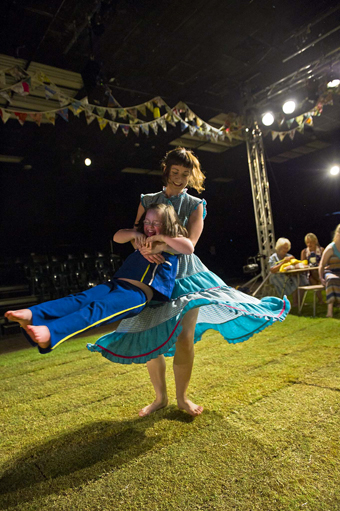
Jess White & Isadora Drummond Sweeney, Next of Kin, November 2010
photo Chris Herzfeld
Jess White & Isadora Drummond Sweeney, Next of Kin, November 2010
We’re excited about our new show for Come Out 2011. Take me there directed by Dan Koerner uses startling video technology and a pumping, original score by Ian Moorhead. At once poignant and hilarious, it not only transports the performers but the audience as well into a strange world where there is freedom to be wherever you want, whenever you want. Restless continues to be fiercely committed to combating discrimination within Australia’s artistic scene. The company has embraced a deeply inclusive rationale, working predominantly with people with disability across dance, tutoring, directing and choreography. Nick Hughes, Company Manager, Restless Dance Theatre
The art of play. I will continue my collaboration with Chiara Guidi from Italian theatre company Societas Raffaello Sanzio at Campelltown Arts Centre, working towards the creation of a work for and by children. Looking for opportunities to present: Impasse an installation collaboration with Denis Beaubois and William McClure. Over-lay: a performance collaboration with Paul Gazzola. The Raven Project with Frank Mainoo will become a “film club” presentation exploring the interplay between performance and film. Currently working with Shfa on Hoopla Festival and later in the year on Viva la Gong Festival in Wollongong. Jeffrey Stein, performer, creative producer
In our 12th year, Bonemap continues to develop new work within the influences of the ‘north’ and an ongoing questioning of the processes and overheads required to practice against the backdrop of a groaning natural environment. Although our practice, processes and methodology are continually rediscovered afresh, we are increasingly regarded as senior artists by the community and asked to recount seminal events in the manufacture of a culture that is becoming less transient. The creative sector continues to inspire development in the deep north as a new wave of exciting projects takes shape in the Cairns region including a $240 million performing arts centre, Indigenous museum and cultural precinct (see www.movedancetnq.com). Russell Milledge & Rebecca Youdell, Directors, Bonemap
Dreams Rising, a new hybrid work about transformative aspects of dreaming and memory, will be developed as part of The Opium Confessions series at The University of Sydney with showings for invited audiences in April. Concerned with the nature of visionary experience, it will draw on poetic and scientific approaches and, in collaboration with Radio National, weave together personal accounts of people from diverse cultural backgrounds in Sydney for whom such experiences have been life changing. Science offers an understanding of dreams and visions in terms of technical brain function, yet our culture has other dimensions, deep histories that honour the reality of visionary experience and find powerful forms of meaning in it. Tess de Quincey, Artistic Director, De Quincey Co
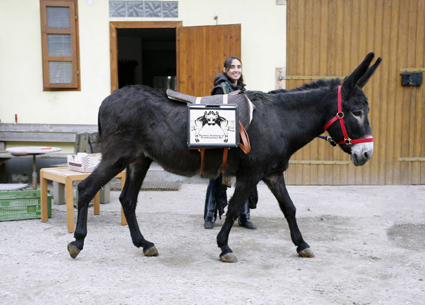
Donkey Institute of Contemporary Art, LCD screen. Vienna, 2010
photo Michael Yuen, courtesy of DICA
Donkey Institute of Contemporary Art, LCD screen. Vienna, 2010
Across Australia, Asia and Europe, my lecture tour series, Testing the City, addresses ideas drawn from the new mega cities in emerging countries. The tour follows last year’s lectures on dismantling old, prevailing city planning ideas. In the northern summer, the Donkey Institute of Contemporary Art [DICA] hits the road again, our non-profit space on the back of a donkey travelling the streets of Beijing. The institute lives by the charm and rhythm unique to the donkey’s soul. In this sense, DICA is the most inhuman and radical fulfillment of the avant-garde. Plans are brewing for an exhibition of young noise artists and a second travelling library. Michael Yuen, artist
ELISION is collaborating with SIAL-RMIT on a large-scale project, CONSTRUCTION, the follow-up to composer Richard Barrett’s Dark Matter. The project explores ideas of spatialisation in acoustic and electronic form examining relationships between “utopian” and real architectures—a long tradition stretching from Plato’s ‘Republic’ to Bacon, Campanella and onwards which is juxtaposed with real cities layered by violent disruptions of war, conquest and rebuilding. Also in the wings is a creative development with David Pledger’s NYID and American composer Aaron Cassidy. I’m enthused about this exploration of composition as a ‘choreography of gesture’ placed within Pledger’s concept of the body itself as a listening mechanism. Daryl Buckley, ELISION
2011 is going to be a great year for the company, touring our latest works and making new ones—taking us right across the country, deep into regional Australia and overseas. Human Interest Story opens the new Heath Ledger Theatre at the Perth Festival and plays at Belvoir in September while Untrained’s three-month Road Work regional tour will feature courageous locals. I’ll be developing a work commissioned by Belvoir in April with actors, dancers and the 2011 Tanja Leidtke fellowship recipient. We’ll take Structure and Sadness to the US in October and, back home in November, I’ll begin work on a brand new piece as yet unknown! Lucy Guerin, Artistic Director, Lucy Guerin Inc
2011: a year of multi-focus challenge. A film project, Virtuosi, will take me around the world filming extraordinary dancers, and a major performance project ,Variant, will be premiered in Sydney. There is real magic in the mix—Variant realises a dream cast of performers who push the boundaries in everything they do and are, quite simply, astonishing. The physical and emotional palette within Variant is the most diverse and exciting of my career. It will challenge the perception that dance is merely a ‘cult of a body-type’ and will turn the idea of what is normal on its head. Sue Healey, choreographer, filmmaker
CHRONOLOGY ARTS (new music collective) presents TACTILITY. Sound is an awesome medium, one of the most ephemeral, but this year we’re taking a leap away from the immaterial as we team emerging composers with emerging fine art practitioners, conceptualising in true symbiosis between members of six teams consisting of composers with a painter, two photographers, a sculptor, video artist and another artist—each creating right now to be ready to present ephemeral temporal art with solidified components upstairs at the TAP gallery, Sydney, at the end of March 2011…Huge Creative Risk. That’s the way we like it. Chronology Arts, new music
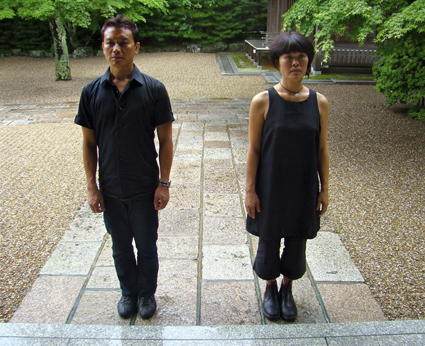
Tony Yap, Yumi Umiumare
photo Sean O’Brien
Tony Yap, Yumi Umiumare
Last year Yumi Umiumare and I launched a new and timely work inspired by the sites of our spiritual heritages in Japan and Malaysia. This contemporary performance work will be uncompromising, innovating deep rituals from our cultural background. ZeroZero is a development springing from the long-term partnership embodied in our renowned series, How could you even begin to understand? of which Jonathan Marshall wrote: “butoh and its multifarious manifestations of a body…draws on traditions of the ecstatic body—[How could you…] is the closest to a shamanistic trance most of us are likely to see…another masterful work.” Tony Yap, dancer, choreographer
Between channel surfing half a dozen crime dramas and simultaneously playing news clips on YouTube, narratives collide, genuine articles mix with the artificial, all confused into one. We want to see beyond surface representations. We want to see the car crashes and smouldering bullet holes on the streets. We want the police and the press to arrive, figure out what happened and present their verdicts to us. We will do this in public spaces, experimenting with the space between audience and event, between abjection and seduction, between producing popular narratives and exploring how they determine social relations and the dynamics of public spaces. Malcolm Whittaker for Team Mess
When I’m not wearing my RealTime blazer, I’ll be involved in an eclectic range of projects. Stuart Buchanan from New Weird Australia has invited me co-curate Volume 10 which focuses on the voice in experimental and ‘interesting’ musics. For version 1.0 I will contribute some sexy sounds to their tales of corruption in Table of Knowledge. Then I’ll sonify our corporeal fluids for Peta Clancy and Helen Pynor’s installation about organ transplantation, The Body is a Big Place at Performance Space. In between I’ll be delving further into vocal improvisation, learning to make a kaiseki banquet and writing a haiku or two. Gail Priest, sound artist
This year I will travel to Europe as the recipient of the 2010 Robert Helpmann Scholarship. I will spend four weeks researching ideas for a new dance work with UK choreographer Wendy Houstoun, continuing the relationship we began with the Fondue Set in No Success Like Failure; four weeks with German choreographer Antje Pfundtner, initiating a collaboration to make a new duet; and four weeks with Belgian-based NZ choreographer Kate McIntosh, sitting in as she creates a new group commission. Three months with three strong women. Then one month in Berlin attending workshops and dance performances. Viel spass! Jane McKernan, dance artist
2011. Meow Meow delves into the lush land of French New Wave cinema, works with Oscar winner Michel Legrand, Pulitzer Prize winner Sheldon Harnick and UK director extraordinaire Emma Rice in Kneehigh Theatre’s adaptation of Jacques Demy’s Classic 1960s French jazz romance “that just happens to be sung”—The Umbrellas of Cherbourg opens on the West End in March. Meow performs Cocteau at opera festivals in the US, continues punk-art-love globally with Amanda Palmer, Lance Horne, La Soiree and exotica with Thomas M Lauderdale; converts Floridian Republicans to the Meow Meow Risque Revolution; dreams of Malthouse Melbourne, Schubert, Schoenberg and presents a surprise announcement at the Edinburgh International Festival. She continues to carry her own luggage and experience crowd surfing as the closest she can get to “a good lie down.” Meow Meow, artiste
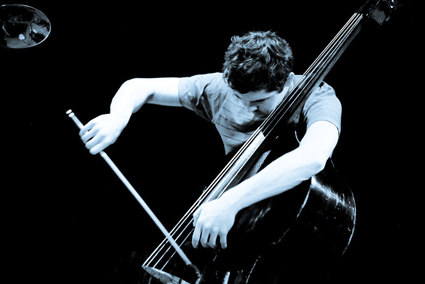
Mike Majkowski
photo Corrie Ancone
Mike Majkowski
Double bassist/improviser/composer Mike Majkowski’s list of things to do (so far) in 2011 (and the list is growing): continue SOLO double bass work (mix & edit recent recordings, record some more—aiming towards a new release); BLIP (duo w Jim Denley) tour to promote the release of a new record, Calibrated; complete the 2nd album, Frost Frost, by ROIL (trio w Chris Abrahams & James Waples) & get it released; more recording with ROIL; complete STRIKE’s debut album (trio w Jon Rose & Clayton Thomas) & get it released; get some gigs with the neo-marrickville-mega-babes (new group w Monica Brooks [drums] & Jon Watts [electric bass])…with Mike singing & playing electric guitar. Mike Majkowski, improvising musician
At the CD launch for Topology’s album Difference Engine, the band welcomes the charming Emma Baker-Spink to perform its Brisbane Songs. Then a few large productions with The Australian Voices exploring the Australian landscape in Sky Songs through new works by Rob Davidson and Gordon Hamilton; a show of new cross-cultural works featuring William Barton composing and performing alongside the band, with Dheeraj Shrestha’s sublime tabla; and a new work for John Babbage in collaboration with Natalie Weir and Expressions Dance Company. The quintet will then create another new engrossing one-hour piece followed by revisiting and redeveloping its hilarious Kransky Sisters collaboration. Topology, new music ensemble
The NOW now is alive and well, thank you very much. And for now, The NOW now will continue to present borderless music twice a month, in Sydney, throughout 2011. Pushing musical binaries so hard they snap. Making a space for the music of the present and the in-between. Always listening. The NOW now is here, now, with you, where it will always be and The NOW now would like to leave you with a Derek Bailey quote: “Of course there’ll be another NOW along shortly, but it won’t be the same NOW. It won’t be this NOW, the NOW now.” The NOW now
2011. January: in cia studios developing Accidental Monsters of Meaning (about surviving consumerist society). February: helping Albany put on a new community dance production. March: Accidental Monsters lands in the WA Museum—11 days straight, four hours a day, five dancers perform in perspex boxes. April: off to Taipei Artist Village for a two-month residency. May: creating in Taipei. June: catching up on uni—studying a Master of Arts in Sustainability. July: seek grants for next year’s artistic endeavours. August: more study. September: more study. October: more grant writing. November: off to Kyoto Arts Centre for a 3-month artist residency. December: cold, icy and inspired in Japan. Aimee Smith, dancer-choreographer
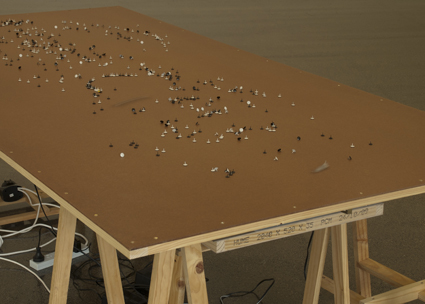
Arlo Mountford & Nick Selenitsch, Movement work #1, Wood, turntables, magnets, metal tacks, motion sensors, 2011
courtesy of the artists and GRANTPIRRIE, Sydney and Sutton Gallery, Melbourne
Arlo Mountford & Nick Selenitsch, Movement work #1, Wood, turntables, magnets, metal tacks, motion sensors, 2011
One of the most exciting projects for me in 2011 opened recently. Fellow Melbourne artist Nick Selenitsch and myself have been collaborating on works for a show in the RMIT Project Space—Movements—in which two kinetic sculptural works play with the human instinct to anthropomorphise basic phenomena—like thumb tacks propelled across a surface by magnets or steel balls collecting on a gallery floor. Also on the horizon are two major animated works that include reworking YouTube videos. And there will be a whole lotta saving the cashola for a studio residency in Japan at the beginning of 2012! Arlo Mountford, artist
Current project is Tongue of the Invisible, commissioned by the Holland Festival for jazz musician Uri Caine, singer Omar Ebrahim and musikFabrik which premieres this June in Amsterdam and Cologne. There’s a text by Jonathan Holmes after the Sufi poet Hafez and the work explores an ecstatic world of Improvisation as unpredictable play, Song as longing for the Divine, Musicians as listeners, drunk with desire, and The Concert as a tavern, a meeting-place between world and ’other.’ “This door is the mouth of love,/ Whether it leads to the mosque or the wine-shop/ Souls inhabit the dust of its threshold.” (Holmes). Liza Lim, composer
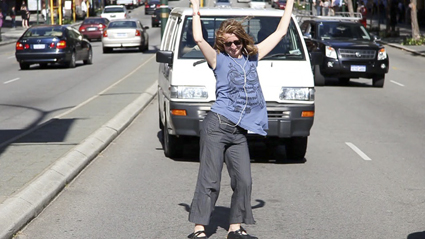
pvi collective t2 r&d
We are most looking forward to playing hard and getting our hands dirty in 2011 with: transumer inspired street intervention workshops at Adhocracy, Adelaide; a new series of quick and dirty public actions titled Do we need a permit for this?; developing national “go fcuk it up day” to launch in time for CHOGM when Perth becomes the centre of world political debate; showcasing t2 at pica, where audiences will be invited to undertake tiny acts of resistance against their built environment. 2011 is looking a little bit brutal & full of love, but we will have killer smiles and sly mischief on our side! PVI Collective
In 2011 an art gang I’m part of, which emerged out of the DLux TILT festival and Newcastle’s Electrofringe, will be ten years old. We’re boat-people.org, we’ve been making work around the ideas of race, nation, history and borders since John Howard conjured us into being with his 2001 border panic election. A decade on, we’ve made all kinds of public spectacles of ourselves and others, maybe including you, in (the hope of) the public sphere. As we reach double digits there’s much more mischief to be made around the troubled themes of our interesting times. Sign up, join us! boat-people.org. Deborah Kelly, artist
We are developing a project for the inaugural San Francisco/Sydney Biennial curated by Justine Topfer (SFAC Gallery) and Meg Shiffler (Director, San Francisco Art Commission Gallery). The exhibition is titled Envisioning Urban Change: Proposals for an Integrated Urban Life and will include three projects about each city created by local artists. The first stage of the project opens in San Francisco in April, the second stage will be exhibited at CarriageWorks, Sydney in August. Our project focuses on Sydney Harbour, exploring people’s relationship to it, the state of the water and how we imagine the harbour’s future. Josephine Starrs & Leon Cmielewski, artists
It’s hard to pick a highlight (how lucky am I?) but none of us in the FULL TILT office have quite come down off the ceiling yet after the extraordinary success of the new music theatre series Carnegie 18 which we showcased in January at the Arts Centre. But from this vantage point we can see the 2012 Carnegie 18 program rapidly approaching! If 2011 gave us an opera about netball, vaudevillian grotesques and rock musicals, then bring on the next round of little gems for 2012. I’m really looking forward to the next new batch! Applications close in May. Vanessa Pigrum, Program Manager, Creative Development, The Arts Centre, Melbourne
RealTime issue #101 Feb-March 2011 pg. 2-13
© RealTime ; for permission to reproduce apply to realtime@realtimearts.net
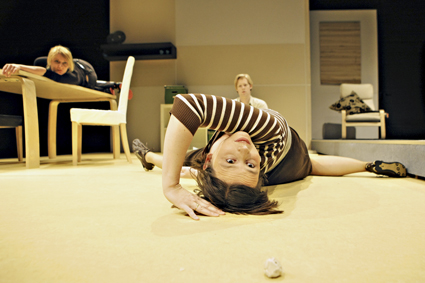
Good Cop Bad Cop, Kassys
photo Prudence Upton
Good Cop Bad Cop, Kassys
MAJOR ARTS FESTIVALS LIKE TO THINK BIG, PROGRAMMING A HANDFUL OF BIG WINNERS (WELL RUN-IN BY OTHER INTERNATIONAL FESTIVALS), ONE OR TWO OTHER WORKS OF SCALE (RELIABLE BRAND NAMES, RELATIVELY LOW RISK) AND A BIG RETINUE OF SMALL SHOWS. NOWADAYS ADD TO THIS A BIG SCHEDULE OF SOLO SINGERS AND BANDS AND OTHER ENTERTAINMENTS THAT CO-EXIST WITH THE FESTIVAL IF APPEARING TO HAVE LITTLE TO DO WITH THE ARTISTIC DIRECTOR’S VISION. THESE LARGELY PLAY TO A VERY DIFFERENT AUDIENCE, BUT PRESUMABLY PROVIDE GUARANTEED INCOME. THE 2011 SYDNEY FESTIVAL WAS AN OCCASION WHEN SOME BIG SHOWS DIDN’T COME GOOD AND LITTLE WAS BIG—THE PROGRAM’S SMALL-SCALE WORKS, TO VARYING DEGREES, OFFERING INNOVATION, PROVOCATION AND ENGAGEMENT.
The Netherlands company Kassy’s Good Cop Bad Cop snuck up on me. Here was an immaculate domestic setting, ideal for a sitcom or a David Williamson play, with three casually attired performers loitering onstage pre-show and occasionally striking unusual poses while staring intently at nothing in particular. What unfolds is a gentle fable-cum-soap opera about the lives and loves of domestic animals, acutely observed, cleverly avoiding standard mimicry (the actors dropping in and out of animality) and complemented with an onscreen commentary from the characters in a more human vein, but never too complicated so that the human-animal divide is constantly erased. Instead of anthropomorphism we’re offered a comic vision that looks both ways—distancing us from animal behaviour, to regard it anew, while pointing up our need to project intention onto animals and simultaneously confirming our own animal-ness. Beautifully paced and performed with loving attention to detail, Good Cop Bad Cop was a welcome surprise.
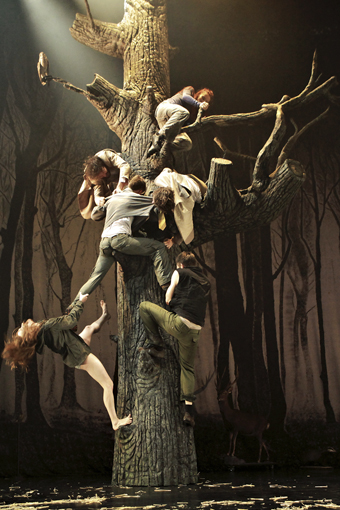
Food Chain, Animal Farm Collective
photo Prudence Upton
Food Chain, Animal Farm Collective
Animal life, human and other, was also the subject of Gavin Webber and Grayson Millwood’s Food Chain, a larger scale work with bigger ambitions. A huge tree, reaching up beyond the proscenium fills centrestage, immaculately ‘sculpted’ it appears at once real and false as does the world around it, transmuting from forest to museum diorama and back again and then, nightmarishly, into one. A pair of apparently taxidermied bears come to life and terrorise a pair of campers—she is eaten, he is wounded when the increasingly human bears shoot him—and a female museum attendant who, in projected shadow play on the wall of a tent, has sex with one of the bears. Subsequently, Salome-like, she dances with his head. In this fantastical world, the bears chat about human behaviour like smutty armchair zoologists, use the scent of their female victim to attract her wounded partner and transform into moustachioed, beige-suited, but no less violent men. The outsider in the scenario is a tree-dwelling man in a bad monkey suit who, leaving his isolation, lectures the smaller forest animals on how to deal with bears but veers wildly instead into how to accept your fate in their jaws—prefiguring his own subsequent demise.
While the bear behaviour is nicely executed and the stage design is embracing, the structure of Food Chain is loose, the pacing sluggish and the comic neo-Darwinian tooth and claw savagery taxing. Redemption comes in a beautiful and unexpected coda as the entire cast form a positive version of the chain of animal life, one of mutuality. This is the descent of species in which cooperation is vital and eternal: singly and then wondrously linked the performers perpetually lower themselves down the tree, disappearing ever so briefly behind it only to appear again at its top with the most subtle directorial sleight of hand.
Gob Squad’s much anticipated Super Night Shot also adopted animal guises, in the form of cheap masks as four performers ventured into the world immediately around the Sydney Opera House, each with a camera, to make a quickie movie in an hour which was then immediately shown unedited and sound-mixed live for us on four large screens. At the centre of a highly synchronised venture was the chance outcome of approaching strangers to find one who would kiss the performer wearing a rabbit mask. The resultant blend of technological assuredness and the happenstance of improvisation was engaging, and quite free of profundities. The work simply celebrated DIY spontaneity, technologically and performatively, with a Live Art back-to-basics vision challenging the sophistication and complexity of the big end of the entertainment world.
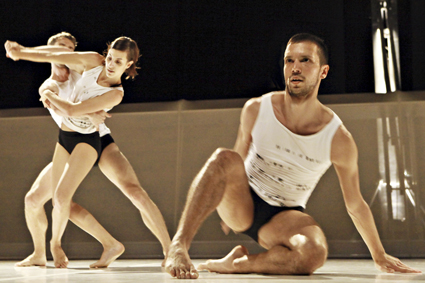
Entity, Random Dance
photo Prudence Upton
Entity, Random Dance
Wayne McGregor’s Entity is a large-scale work that also uses screens, three big, wide ones framing the dance space and mounted on mechanical devices that dancers could raise or lower by hand as required. Onto these were projected equations and data scrolling furiously if dimly. The dancing was also furious—fast and acutely articulated, balletic but constantly and miraculously off-centre in the Forsythe manner. Striking solos and duets with odd holds and sudden acrobatic inversions or rare slow unfoldings multiplied virally across the stage until the mass of dancers dissolved and a new set was initiated. I was seduced moment by moment but the sense of a totality evaded me.
McGregor’s fascination with the science and psychology of the creative process makes for good reading but the subject is not convincingly embodied in Entity: “By forcing breakdowns of coordination in his dancers, McGregor hoped to gain an insight into the relationship between their physical and cognitive functions. To this end he submitted the dancers to perturbations, assigning them tasks like counting backwards while dancing, and making them wear prisms over their eyes to distort their spatial awareness” (Luke Jennings, program note). Certainly the dancers evinced a remarkable certainty of purpose against the odds of speed and complicated shaping but Entity’s rhythmic sameness (countered somewhat by the melancholy string score of the first section but underlined by the driven pop pulse of the second), the iterated theme and variation structure and the vapidity of the screen deployment gravitated against coherence and interest. The relationship between dancers and projections was nil, the raising and lowering of screens insignificant—a prime example of ‘background new media.’ Australian artists Gideon Obarzanek, Lucy Guerin and Garry Stewart integrate dancers and stage materials, whether objects, projections or devices, with thoroughness and creativity.
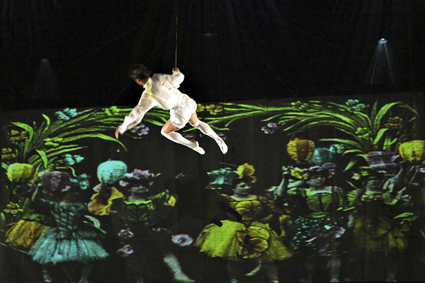
Alexandra Harrison, My Bicycle Loves You, Legs on the Wall
photo Prudence Upton
Alexandra Harrison, My Bicycle Loves You, Legs on the Wall
More projections came in the form of wonderful footage from the Australian National Film and Sound Archive from the early 20th century Corrick family circus that showed film—beautiful, funny, strange—as part of their repertoire, 1901-14. Whether or not this was just value adding or seminal multimedia work is not clear, but despite attempts by Legs on the Wall to connect stage action with film image, My Bicycle Loves You was not a convincing merger of live bodies and projections. This was partly a problem of scale, the images sometimes huge, filling the stage as a superfluity of screens flew in and out. At other times the correspondence, at human scale, was right, with a ghostly suggestiveness. But the production’s problems were not simply to do with a disjuncture between body and image but with a chasm between the past and now, between contemporary characters and their mysterious antecedents. There are moments when those in the present watch the past, but the connections are thin, as are the relationships between the seven characters in the contemporary setting, an apartment block where their lives intersect, each person with a problem or a fantasy life that remains largely unexplored. As physical theatre, My Bicycle Loves You was unusually tame for a company like Legs on the Wall, and the relationship between routine-based scenes and the overall scenario often seemed tenuous. The show had its physical high points (not least from Alexandra Harrison and Tom Flanagan) and a great band led by Ben Walsh, but its structural disjuncts were too large to accommodate its ambitions.
Bigger Than Jesus, written and performed by Canadian artist Rick Miller was a minor festival highlight, a bit like Richard Dawkins doing his atheism number as stand-up. Mixing forms (comedian, lecturer, preacher) and media (live video, rough puppetry, superimposed stage and screen images), Miller vented his hostility to organised religion with glee (the demotic Blakean preacher being the best of it) and cunning (an hilarious Last Supper featuring among the guests a John Lennon doll and a Homer Simpson PEZ dispenser as Judas). In the end it’s clear that Miller is not only fond of Jesus but in a curiously narcissistic finale becomes physically one with a projected painting (Dali I think) of his crucified other. With the debates over atheism, religious belief and fundamentalism still raging, Bigger Than Jesus is a timely entertainment if sagging mid-way in its jet flight to Jerusalem routine and in the datedness of some of its screen technology.
The less said about the festival’s big ticket show, The Giacomo Variations, the better. An underdeveloped, clunky cut and paste life of Casanova interpolated with occasionally apposite songs from various Mozart operas, it featured a very good soprano and a fine tenor (both required to do extraordinary physical acts while singing—usually of a sexual variety), an adequate actress and the Sydney Symphony Orchestra sounding fine. John Malkovich as Casanova meandered through the narrative with none of the brisk, varied delivery of his long-ago Dangerous Liaisons movie performance as a similar rake. It was indeed strange not to have a festival with a centrepiece (as awkward as that concept can be) like the Hamlet or the Wars of the Roses of recent Sydney Festivals.
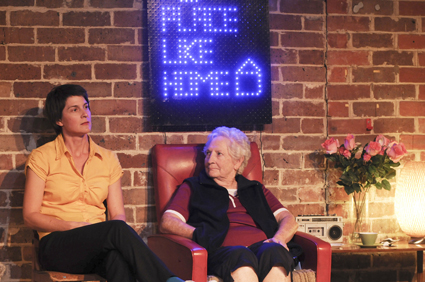
Rosie Dennis, June Hickey, Driven to New Pastures
photo Heidrun Löhr
Rosie Dennis, June Hickey, Driven to New Pastures
At the very small end of the festival spectrum was Rosie Dennis’ Driven to New Pastures, a subtle exploration of the impact of commercial residential developments on public housing in the suburbs. Except for its opening, where Dennis adeptly delivers a clever cliche-saturated sales pitch for a new nature free, maximum privacy and security development, protest is avoided. Instead Dennis recounts the events that will shift an older woman out of her home and into isolation. She is joined onstage by June Hickey, from Minto in outer Sydney, playing someone like herself who has been faced with this prospect (if with a different outcome from the one reported on stage). Hickey has an easy presence, listens, reads, dances with Dennis and speaks a little—perhaps she should have shared some of Dennis’ words (it seems she didn’t want to memorise lines, but there are other means) to give the show a finer balance, a break from the sense of monologue. Dennis’ writing and its fine grained improvisational feel is as pleasurable as ever and the simple theatricality of the work—the turning on and off of lamps for example—is effective, if faltering a little in an atypical scene in which one of the building’s inhabitants stages a rocket escape from the plight of displacement. Driven to New Pastures is an admirable work; I would like to have seen it closer to home with the audience who first experienced it, in a church hall in Minto in 2010.
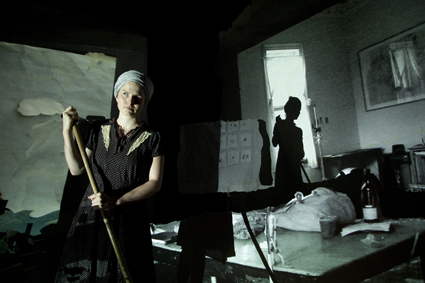
Fleur Elise Noble, 2 Dimensional Life of Her
photo Jamie Williams
Fleur Elise Noble, 2 Dimensional Life of Her
Returning to the subject of projections deployed in performance, Fleur Elise Noble’s 2 Dimensional Life of Her is a performative screen work par excellence. Huge sheets of paper swathe the intimate stage space onto which are projected a large living room in a couple of layers on one side and, before us, a black and white world of marionettes who appear to tear through the screens and finally set full-colour fire to the set. Noble arrives in the flesh (having hitherto functioned unseen as a puppet master or as a projected cleaning lady) to admonish her creations and send them off sailing. An essay on creativity, control, manipulation and ways of seeing, 2 Dimensional Life is witty, technically deft and engrossing, offering more dimensions than its bigger festival counterparts. Now, after its 2010 Mobile States tour and Sydney Festival appearance, it’s to travel to festivals around the world.
Sydney Festival 2011: Kassys, Good Cop Bad Cop, Seymour Centre Downstairs, Jan 26-30; Gavin Webber & Grayson Millwood, Animal Farm Collective, Food Chain, design Moritz Muller, Everest Theatre, Seymour Centre, Jan 26-30; Gob Squad, Super Night Shot, Studio, Sydney Opera House, Jan 25-30; Random Dance, Entity, concept, direction and choreography (with the dancers), design Patrick Burnier; Legs on the Wall, My Bicycle Loves You, story by Beatrix Christian, Patrick Nolan, Anna Tregloan and company, director Patrick Nolan, designer Anna Tregloan, projection consultant Tim Gruchy, Sydney Theatre, Jan 11-15; Bigger Than Jesus, performer Rick Miller, creators Rick Miller and director Daniel Brooks, Wharf 1, STC, Jan 18-29; The Giacomo Variations, writer, director Michael Sturminger, Concert Hall, Sydney Opera House, Jan 20-22; Driven to New Pastures, writer, performer Rosie Dennis, performer June Hickey, Downstairs, Seymour Centre, Jan 11-16; 2 Dimensional Life of Her, creator Fleur Elise Noble, Downstairs, Seymour Centre, Jan 9-13
RealTime issue #101 Feb-March 2011 pg. 14-15
© Keith Gallasch; for permission to reproduce apply to realtime@realtimearts.net
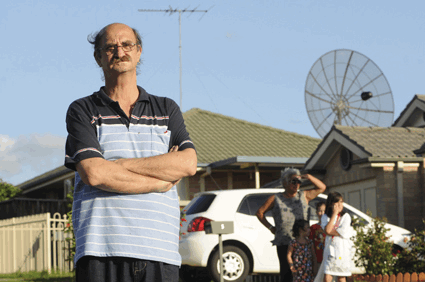
Streetdance, Lone Twin, image1 Darryl, image 2 Judie and daughters, image 3 Aunty Verna and grand daughter, image 4 Kaye
photos Heidrun Löhr
Streetdance, Lone Twin, image1 Darryl, image 2 Judie and daughters, image 3 Aunty Verna and grand daughter, image 4 Kaye
ONE OF THE THINGS I LOVE MOST ABOUT CONTEMPORARY PERFORMANCE IS THAT IT GETS ME OUT AND ABOUT TO PLACES THAT I MIGHT NOT OTHERWISE GO. GATHERING GROUND, FOR INSTANCE, TOOK ME TO THE BLOCK IN REDFERN, MARALINGA [RT77, P46] TO THE ETTALONG WAR MEMORIAL CLUB AND FAST CARS AND TRACTOR ENGINES [RT70, P41] TO THE BANKSTOWN TOWN HALL. TONIGHT I AM ON THE M5 DRIVING TO MINTO, IN SYDNEY’S SOUTH-WEST, HOME TO THE RUGBY LEAGUE TALENTS OF JARRYD HAYNE, KRISNAN INU AND ISRAEL FOLAU AS WELL AS THE POLITICAL TALENTS OF WHITLAM, LATHAM AND NOW LAURIE FERGUSON.
Fifty kilometres from the CBD, Minto is a world away from shiny, shiny Sydney: geographically isolated and economically disadvantaged. Nevertheless, it is currently undergoing rapid transformation, as Campbelltown’s Live Art Curator Rosie Dennis told Gail Priest in her interview in RealTime (RT100, p5)—public housing is moving out and private investment is moving in. Though it was not necessarily conceived as such, Minto:Live has become a part of this process of economic, social and cultural renewal. The project started in November 2010 when Dennis and several other artists literally set up shop in the Minto Mall. When curious residents came in, they found a range of activities on offer, including dancing with Lone Twin and Julie-Anne Long, crocheting with Nicole Barakat and publishing with Mickie Quick and Kernow Craig, all of which were to have performance outcomes of some description. Tonight, the final of three performances, is about sharing those outcomes.
It’s six o’clock and a crowd is milling in the mall car park. Volunteers hand out programs and a man in a cycle rickshaw distributes envelopes labelled “MINTO THE TYPEFACE.” Inside are postcards telling stories that Quick and Craig have collected from Minto residents. The stories are small, but the cards are large—handy in the heat, if you need a fan. Fanning a fire in front of Tyrepower, is Uncle Ivan Wellington. He carries the ceremonial smoking leaves slowly and carefully through the crowd. The smell seeps into our clothing. Then it’s time for Sweet Tonic—a choir of senior citizens—who sing three songs, including John Williamson’s “A Thousand Feet Have Been Through Here.” Walking across the asphalt to a concrete ramp, we spy a council worker in an orange vest slowly circling his hips—this is Street Dance.
Facilitated by UK performance duo Lone Twin with Campbelltown Arts Centre dance curator Julie-Anne Long, Street Dance features eight Minto households (13 people in total) dancing not only in the street but also in their front yards and favourite parks. In the opening dance, Ivan pitches his shoulder as if digging a hole, before stomping on the earth and jumping up a ramp. Standing at the top is Judi, whose dance is like semaphore without the flags. She and her two daughters stand still but move their arms with purpose and their wrists with delicate flicks. Up the stairs, Daryl is standing at the end of the cul de sac, rubbing his hands, half in anticipation, half in purification it seems. He extends an arm as if to hail a bus, offers his hand for a handshake and pats his pockets as he searches for his keys. Further along, a family of four puts on a Bollywood special in their front yard: two little girls in gold bounce around the lawn, before their father and mother emerge from the house to enact a skit about drink driving.
In the park across the road, a grandmother is walking around a large tree, kissing her fingertips and extending her arms. When a small girl joins her, they do another loop of the tree and then head off up the hill. From behind, the older woman looks like she is doing an elegant breaststroke while her granddaughter’s movements are more akin to a paddle. Next we stop by Kaye who does a dance of farewell (to planes) and welcome (she seems to want to share a secret). Around the corner Judi and her daughters turn on the car radio, boogie to “Crazy Little Thing Called Love,” jump into the Nissan and roll off into the night. Finally, at the end of the street Chris and Kiara do the washing—shaking and folding invisible sheets. Street Dance works with a subtle and complex combination of the familiar and the strange: on the one hand, creating a choreography of every day gestures, on the other, reminding us that the nature of our day depends on gender as well as geographical and social location. Similarly, though it could be described as an attempt to make the suburban strange, it also has the opposite effect, making me realise that suburbs are strange enough, with their stamped concrete and security cameras. In these moments, Street Dance actually works to make these Truman Show streets feel slightly less surreal—like an ordinary place to play and perhaps dance.
Following Street Dance, we head to another park, where three women sit in armchairs working on Barakat’s Common Threads. One sits with a pile of old rags making rope, which the others then use to crochet. The result is what one of them describes as a “string sculpture in action” and it looks like large doily. Further up the hill, we sit on picnic blankets and listen to the sounds of nine trumpets. TrumpetSWest’s first piece is slow, sweeping and sombre while the second is jauntier, as the lead player meanders in front of the melody.
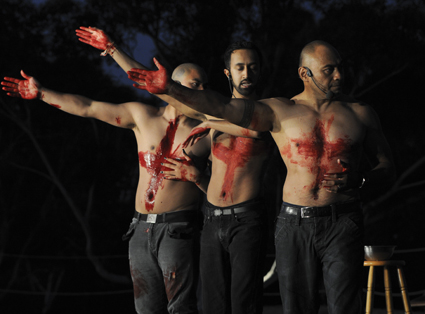
Nikki-Tala Tuiala Talalolo, Hetain Patel, Charlie Fruean, Ten
photo Heidrun Löhr
Nikki-Tala Tuiala Talalolo, Hetain Patel, Charlie Fruean, Ten
The longest contribution to Minto:Live and the one most self-consciously framed as a performance (set in a natural amphitheatre, staged on a blue mat) is Hetain Patel’s Ten. The show alternates between storytelling, music and movement, as Patel talks about being born in England to Indian parents. Formerly embarrassed by his background, he has since come to embrace it and, in an effort to become more connected to Indian culture, taken up the tabla drums. This segues into the musical sections, where he and his two local collaborators (Nikki-Tala Tuiala Talaloloa and Charlie Fruean) clap out complicated 10-beat rhythms. Talaloloa then offers a Samoan slap dance and Fruean a Maori haka in return. In the final third of the show, the men start to borrow verbal and physical phrases from each other so that Patel performs a haka and Talaloloa, in his gently clipped vowels, talks about mixing red paint. Ten is an elegant and interesting piece, if slightly too long, particularly for neighbourhood children who are busy bobbing about, disrupting the audience’s sight lines and thus reasserting the community aspect of the event over its performativity.
Perhaps they are anticipating the wheelbarrows full of ice cream further down the hill, where three large video screens play the Minto Waterhole, a film created by Class 3/4J at Sarah Redfern Primary School with the help of Howard Matthew, Caitlin Newton-Broad and Sanjay Hona. The film is an endearing mix of live action and animation, which depicts a secret water world full of puppet creatures, lurking somewhere below Minto—a magical thought on this hot summer night.
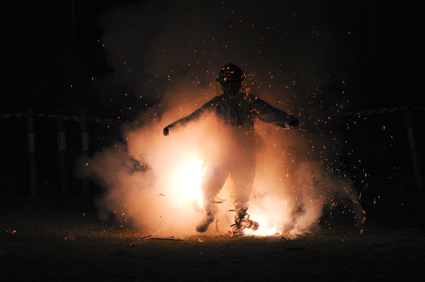
Gwendolin Robin, Instant No. 6899
photo Heidrun Löhr
Gwendolin Robin, Instant No. 6899
Minto:Live concludes with a smoking ceremony of another kind: Gwendoline Robin’s Instant No.6899. Dressed in what looks like a white space suit strapped with explosives, Robin slowly puts on her helmet and wraps silver tape around her neck. The anticipation is almost too much for the children behind me, who think she might be a suicide bomber. She lights a fuse and then her suit explodes, setting off small grass fires. “She’s dead!” the children cry, but then as Robin walks down the hill with a stream of smoke in her wake, they revise this to “She’s the walking dead! She’s a zombie! She’s on fire, she’s a fire zombie!” This stream of images is itself one of the evening’s many small pleasures and as we walk back towards the mall, we smile with the knowledge that Minto is teeming with imagination.
Minto:Live, curator Rosie Dennis; Welcome to Country, Uncle Ivan Wellington; Sweet Tonic; Street Dance, Lone Twin with Julie-Anne Long and residents of Minto; Common Threads, Nicole Barakat with residents of Minto; TrumpetSWest, Freddie Hill and company; Ten, Hetain Patel, Charlie Fruean, Nikki-Tala Tuiala Talaloloa; Minto Waterhole, Caitlin Newton-Broad, Howard Matthew with Sanjay Honas and students of Sarah Redfern Primary and High Schools; Instant No. 6899, Gwendoline Robin; Minto, Jan 20-22
RealTime issue #101 Feb-March 2011 pg. 16
© Caroline Wake; for permission to reproduce apply to realtime@realtimearts.net
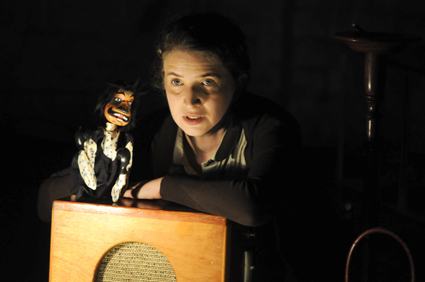
Talya Rubin, Of the Causes of Wonderful Things
photo Heidrun Löhr
Talya Rubin, Of the Causes of Wonderful Things
EARLIER THIS YEAR PLAYWRIGHT SUZIE MILLER NOTED IN THE SYDNEY MORNING HERALD THAT OF THE 80 MAINSTAGE WORKS SCHEDULED FOR 2011, ONLY NINE (OR LESS THAN 12 PERCENT) WERE WRITTEN BY WOMEN. THE NEXT DAY THE PAPER PUBLISHED A PREDICTABLY INFLAMMATORY LETTER TO THE EDITOR FROM A MAN WHO WROTE THAT WHILE HE “REJOICE[D] IN FINE PLAYS BY WOMEN” NONE COULD BE CONSIDERED GREAT AND THUS THEY DID NOT DESERVE PROGRAMMING.
It’s a familiar argument and though Miller and the letter writer appear to be on opposite sides, they have more in common than they might care to admit, for they both define writing so narrowly it’s as if post-structuralism never happened. Surely, if we’ve learned nothing else, writing is about more than the words on the page; in the context of performance, we write with bodies, light and space as well as words. Taking this broader definition, it is clear that there are in fact many women “writing” for performance. Indeed, contemporary performance in this country is unthinkable without them—imagine the Sydney stage without Frumpus, the Fondue Set, My Darling Patricia, Post and Brown Council, to name just a few. Yet these names never feature in these annually rehearsed, rehashed arguments.
My frustration with the conversation was exacerbated by the fact that I had recently been to Liveworks at Performance Space where I had seen a number of strong works by women, who in fact dominated the program. Not that there weren’t some men too—Jiva Parthipan, Jason Maling, Paul Gazzola and Jason Sweeney on screen—but it was the women who caught my eye, working in a variety of combinations (solos, duos and groups) and forms (lectures, dances and comedies).
One of the strongest shows in Liveworks is Talya Rubin’s Of the Causes of Wonderful Things, which might also be called The Curious Case of Esther Drury and Her Five Missing Nieces and Nephews. In an atmosphere of carefully curated chaos—the stage is littered with lamps, chairs, piles of dirt and projectors—Rubin cuts back and forth between several characters including Esther, the police officer investigating the disappearances, Esther’s sister Claire who is in a relationship with an abusive French puppet called Frankie and Esther’s neighbour Mr Hiroshimoto. Rubin plays expertly with perspective, creating tiny scenes in a glass box, larger scenes projected onto the wall and some truly surreal interludes, such as when a donkey mask named Samuel takes to the stage in a town talent contest. With a judicious edit, this already unsettling and affecting show could become something truly special.
Paper People shares a similar aesthetic: the room holds a small stereo, a pile of white feathers, a wooden chair, a couple of microphones, cushions and a doll. We follow the performer around the room as she leans against a wall, rubs a doll against her breast, lectures us on audience participation, throws a red cushion in the air, eats a bowl of chillies and finally stitches herself to a man in the audience with red wool. The entire room holds its breath as someone hands him a pair of scissors and he cuts them apart one thread at a time. Paper People evokes a strange sense of intimacy, indeed the strangeness of intimacy itself: what it is to look into someone’s eyes (the performer is constantly looking at the audience with a mixture of invitation, resignation and resentment), share a favourite song, desire someone’s full attention and yet fear it, lest you prove lacking. Not that she does, and we leave the space wanting more.
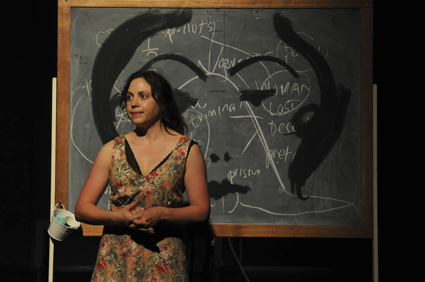
Nicola Gunn, At the Sans Hotel
photo Heidrun Löhr
Nicola Gunn, At the Sans Hotel
Slightly less successful though no less suggestive is Nicola Gunn’s At the Sans Hotel, which begins with her character “Sophie” confessing in a faux French accent that Nicola couldn’t make it tonight. To compensate, Sophie gives us an overview of Nicola’s planned performance, complete with chalkboard drawings and references to Kazuo Ishiguro, Cornelia Rau and Rau’s alter ego Anna Schmidt. This is about the only interpretive clue on offer as Sophie continues to tell rambling stories in English and German before dancing with projections of herself and finally to Beyonce’s “Single Ladies.” Read with Rau in mind, At the Sans Hotel might be seen as a sort of “schizoanalysis” of her tragic case; read more broadly, however, it could be seen as a riff on what happens when we forget ourselves (in every sense).
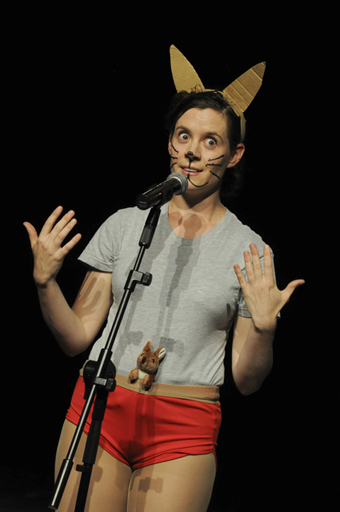
Jane McKernan, Opening and Closing Ceremony
photo Heidrun Löhr
Jane McKernan, Opening and Closing Ceremony
While Gunn focuses on forgetting, Jane McKernan is more concerned with remembering. Resplendent in red shorts and flesh coloured stockings, she spends most of Opening and Closing Ceremony outlining a potted history of gymnastics and its less glamorous cousin “physie,” touching on Beijing 2008, Brisbane 1988 and the nature of community along the way. During this time she has been adding a tail, two ears and some whiskers to her costume and once it is complete, it’s showtime. McKernan lunges and stretches her way down the stage while a voiceover shares her inner thoughts about being a dancer and mother as well as her own childhood memories. In the final moments, she performs a triumphant routine to Rick Astley’s “Never Gonna Give You Up.” Opening and Closing Ceremony is a gentle and humorous meditation on what it is to be shaped by gender, culture and nation or, more specifically, physie and Brissie in the mid-1980s.
Similar themes emerge in Colombian artist Claudia Escobar’s manola, which consists of a series of striking but not always legible images. The show begins with a bag inspection, continues with Escobar wandering the stage with a brick on a rope and boiled eggs in her mouth, and finishes with her sipping through a straw from a condom full of milk. It also includes Ahilan Ratnamohan as a transvestite Miss Colombia and then as a guerrilla fighter who captures and tortures Escobar, who whimpers, “I can no longer fantasise about my death.” In the dying minutes of the performance, she whispers “this is a secret between you and me;” but for the most part the secret remained hers and, because of the untidy scenography and underdone dramaturgy, was not something I could fully share.
Fiona Winning and Victoria Hunt are also concerned with the legacies of colonialism. Their Dancing the Dead deals with Hunt’s Maori ancestor Hinemihi, also the name of a tribal meeting house which was built in 1881 and survived the 1886 volcanic eruption, only to be sold for £50 to Earl Onslow in 1892. Onslow had “her” dismantled and transported to his estate in England, where she still stands. The most interesting parts of the lecture come when Hunt herself stands and explains how she might create a dance about Hinemihi: showing us how she might represent her spirit trapped in the rafters or the energy of the volcanic earth. This “performed conversation” between Winning, Hunt and members of Hunt’s extended family is not only useful background information for Hunt’s future performance, but also a careful memorial in its own right: one that conveys Hinemihi’s absence as well as her ongoing and dancing presence.
On a lighter note, Karen Therese uses the performance lecture form to cause her audience acute discomfort by talking about nothing but comfort. The show starts with Therese sitting behind a desk, wearing a blonde wig and sharing some of her ideas on her subject. She has also consulted with friends and, more interestingly, a corporate management book that identifies the “comfort zone,” the “danger zone” and, in between, the “optimal performance zone.” Therese spends the rest of the lecture detailing how she’ll achieve the optimal zone in this particular performance. (Brian Fuata sits stage left with words of reassurance and a cup of tea.) The show finishes when she pulls several people from the audience on to the stage and asks them to dance to Beyonce’s “Halo”—dancing in public, in this case the very definition of discomfort.
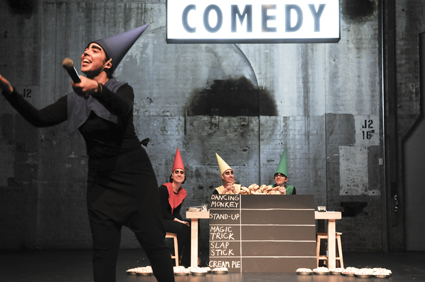
Brown Council, A Comedy
photo Heidrun Löhr
Brown Council, A Comedy
Perhaps the highlight of Liveworks is Brown Council’s A Comedy. For four hours, the four performers (dressed in dunces’ caps) place themselves at the mercy of the audience, as spectators select which comedy trick or trope they’d like to see next from a list that includes stand-up, the dancing monkey, cream pies and magic tricks. This is all done to a soundtrack of ‘boom-tish’ effects and the musak of late night talk shows. In staging a four-hour comedy, Brown Council bring a much-needed levity to durational performance, which can tend towards the solemn, even po-faced. But duration has a habit of turning even the humorous into the tortuous and, as the night wears on, we reveal ourselves to be petty, silly, mean and violent. When the piece finishes with an almighty food fight, it feels like a finale to Liveworks, even though it’s only Friday night. Two days later, A Comedy remains my favourite for its intelligent conception, excellent execution and the collective exuberance it unleashed.
In its own way, attending Liveworks was itself a durational performance and like any endurance effort there were some discomforts. The timetable was difficult to decipher and the timetabling itself somewhat strange—the theatres were rather empty on Thursday and Friday afternoons, and it wasn’t until Friday evening that the event really started to hit its stride. Then on Saturday, it seemed that there were more takers than tickets, meaning that some people missed out. Perhaps if the event were moved to take in Friday, Saturday and Sunday, more people might get to see these works in progress (as many of them were). This, in turn, might encourage them to come back to Performance Space not only for more “progress reports” but also for more adventures in live art. And when these adventures are “written” (devised, designed, directed and performed) by women, they have the potential to shift the conversation not only about women’s writing but about the nature of writing itself.
Performance Space, Liveworks: Fast & Furious, CarriageWorks, Sydney, Nov 11-14, 2010
RealTime issue #101 Feb-March 2011 pg. 18
© Caroline Wake; for permission to reproduce apply to realtime@realtimearts.net
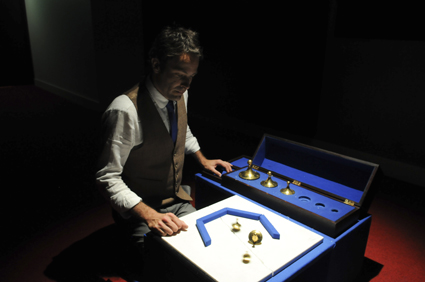
Jason Maling, The Vorticist
photo Heidrun Löhr
Jason Maling, The Vorticist
I ALWAYS FEEL EXULTANT WHEN I WALK INTO CARRIAGEWORKS DURING THE DAY AND DISCOVER SOMETHING CREATIVE HAPPENING. SUNLIGHT SHAFTS THROUGH, LIFTING THE BEAMED ROOF; PEOPLE EDDY FROM ROOM TO ROOM, VIVIFIED BY WHAT THEY’VE SEEN. THIS IS THE PLACE AT ITS BEST: ACTIVATED BY ART THAT INQUIRES, REGENERATES AND INTERACTS. USED ONLY FOR FINITE PURPOSE AND MATERIAL GAIN, CARRIAGEWORKS FEELS DEAD.
There is probably no event on its calendar that has greater potential to animate the place than Performance Space’s Liveworks, so it was disappointing to arrive Thursday midday and find CarriageWorks virtually empty. The Vorticist nonetheless was booked out—a one-on-one performance with a strong reputation honed over years. Artist Jason Maling was ambivalent about the context, deeming it “perhaps too theatrical,” but submitted the work because he wanted to be rid of it. At Liveworks, his usual process of building an archive was reversed, to become its deletion.
Dressed in waistcoat and tailored trousers, Maling leads his audience of one through a maze of corridors and stairs to a small, secluded space. You sit on the floor with him either side of a low table covered in handcrafted arcane tools and relics on paper from previous visitors. A tête-à-tête ensues with the artist. Intimacy is intrinsic to any one-on-one and the form can take this for granted and be conceptually lazy; so too artworks that request a story or secret from the audience. Yet The Vorticist, which started with this premise, ended with much more. What is this thing? Who were all these people before me? A trace installation of scrolls from years of such encounters, accumulated in a space above the foyer.
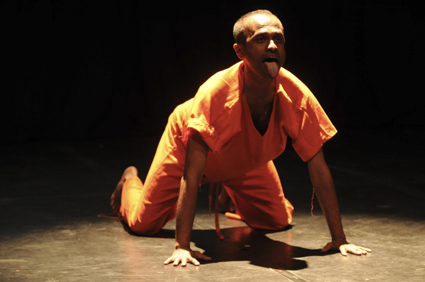
Jiva Parthipan, Last Remaining Relative
photo Heidrun Löhr
Jiva Parthipan, Last Remaining Relative
Jiva Parthipan’s performative lecture, Last Remaining Relative, recounted the artist’s recent emigration to Australia, interwoven with a series of anecdotes about international travel and art. Parthipan has been on the move his whole life: departure at age ten from war-torn Sri Lanka; decades in London; work around the world as an artist. Now he is in Australia under the visa category “Last Remaining Relative.” Constantly thwarted and harrassed by bureaucracy due to his race, Parthipan could have treated the subject harshly, encouraged into didacticism by the lecture format. Instead he was an engaging, witty, informative speaker, his true stories attaining an Orwellian absurdity. Pungent asides about the local bureaucracy finished the work perfectly. Some of the most eloquent moments were articulated with Parthipan’s body alone when he left the lectern to impersonate a tiger, then later a monkey. His performance set the political bar high at the festival, and no-one else topped it.
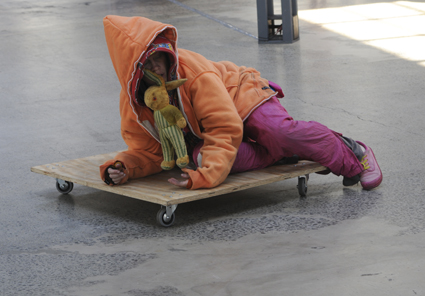
Linda Luke, Hoodie – Thirteen
photo Heidrun Löhr
Linda Luke, Hoodie – Thirteen
Thirteen by Linda Luke and Vic McEwan began in the foyer in the afternoon. A performance installation about homelessness drawn from Luke’s personal experience, titled Hoodie, was Part One. To McEwan’s gentle, eerie soundtrack, Luke slowly moved across the floor, half hidden and constrained by a hood. The wheeled contraption she employed part way through became an improvised skateboard, the perfect second prop. Luke was utterly in character, but the lack of audience drained energy from the work. Again through no fault of the artists, the work’s tent installation felt a little contrived as CarriageWorks management disallowed the artists from inhabiting it full-time for the three days the performance ran. I regret not making it to Part Two.
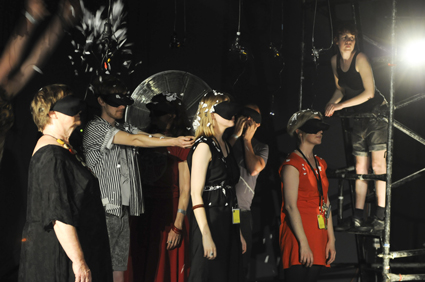
Thrashing Without Looking
photo Heidrun Löhr
Thrashing Without Looking
Thrashing Without Looking by Martyn Coutts, Tristan Meecham, Lara Thoms, and Willoh S Weiland was an interesting combination of light-hearted enjoyment and psychological challenge for those who fear the unknown or loss of control. It provoked all sorts of thoughts about the modes of disembodied communication we engage in now—televisual, internet—how trust and agency are still called upon and how intense and liberating is the sense of touch. There were moments of alienation, boredom, confusion, anticipation, humour and the ending was surprisingly tender. I didn’t want to leave.
I Luv Amanda Crowe, a work about teenagers in 80s suburbia—a strangely dominant trope in Australian performance—floundered through lack of content, courage and form. Surely adolescent desire connotes fear, tenderness, pathos, embarrassment, but all the embarrassment expressed by the performers seemed to be more about the work than its actual subject matter. Even the superlative Georgie Read couldn’t save it. The performance begs a question that came to mind frequently throughout the festival around the programming of works-in-progress.
By contrast, Brown Council’s A Comedy came to Liveworks honed by years of the quartet’s explorations of modes of comedic entertainment in performance. The masterstroke lies in their recent meld of traditional comedy with endurance via a slightly sporty aesthetic. They pushed this even further at the last minute by deciding to create a single four-hour performance instead of one hour slogs back to back. Everything is distilled: the girls’ plain black outfits; their coloured dunce caps, cannily distributed among the audience as well; the bare stage; the casual demeanour of the three performers up the back chatting and eating peanuts while their fourth is in the hot seat. The peanut gallery, of course.
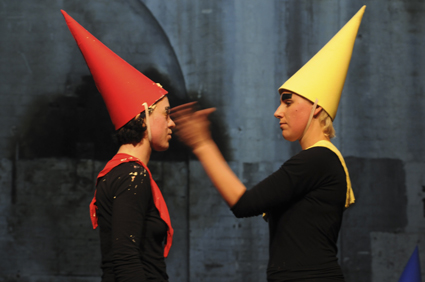
Brown Council, A Comedy
photo Heidrun Löhr
Brown Council, A Comedy
A Comedy was built on five tricks, vaudeville classics such as cream pie throwing as well as stand-up. Others like the dancing monkey go back millennia and, merely by being humanly conveyed, revealed their sinister side—banana gorging, face slapping: our gluttony and lust for violence and desperation to please. There was a tremendous command of material from every one of the performers—Fran Barrett, Kate Blackmore, Kelly Doley and Diane Smith—the discomfort and hilarity building by the hour. Utterly compelling, with much food for thought.
Into/Out of Me by Brigid Jackson posed the question: To what extent does my body belong to me? Occupying a small dressing room for just under two hours, with Benjamin Cittadini manipulating sound, Jackson began on the floor, blowing up and tying off plastic bags. She gradually moved to stalking in a tight circle, making the occasional incision on her chest, dripping milk into the blood with an eye-dropper. Taped to the mirrors around the room were little sachets of hair, nail clippings, blood. In the program the work was described as an exploration of the boundaries of bodies and what is left behind, the latter less personal than the former. Yet the body remnants around the room remained disconnected, the performance itself not coherent. Like the hospital gown they didn’t articulate beyond signalling that Into/Out of Me was about the body. Nevertheless the audience seemed hungry for this sort of intimate, visceral performance, in a festival otherwise sadly devoid of it.
David Cross’s Hold, from Performance Space’s Nighshifters program, was a perfect companion piece to the Liveworks. Entering the installation I was awestruck by the size of the inflatable, a weird hybrid of ship and castle. Climbing into it was daunting and exciting, the appearance of what seemed a fake hand something to be avoided. Then, on the crest, a choice has to be made: fears surmounted, the audience’s agency absolutely intrinsic. The sheer audacity and sculptural beauty of the work opened further, enhanced by the dilemma of how to negotiate trust with a stranger and the question of reciprocation. A beautiful twist occurs in the middle, the whole experience profoundly moving. Cross performed a companion piece on Saturday morning in the blazing sun opposite the farmers’ market. In a sense Hold’s microcosm, it again tackled reciprocity and engagement this time with a small contraption worn on the artist’s head, activated—or not—by a partner. One hand, one eye; the necessity of action. Confronting from the inside, entertaining from the outside. The simplicity of these elements and the artist’s immense effort produced a complex work that, like Hold, made an endless variety of connections.
Cross’s work benefited greatly from its accessible positioning and in the range of people it reached. With so much of Liveworks dependent on audience interaction —Thrashing, Thirteen, A Comedy, to name a few—it seemed a shame to let performances languish in the barely attended daytime working week slots. Saturday afternoon by contrast had so many events on simultaneously you were bound to miss many. Even then, many people I know who attend cultural events every weekend didn’t know about Liveworks. Full price tickets for works-in-progress, some barely begun, created more hindrance to healthy numbers.
There is the danger of insularity. Indeed, the lushest party was the restricted artists’ event at kick-off; by contrast, after Night Time on Sunday night, full and buzzing, the foyer sadly emptied. Can the performance world accept its marginal status to the point of complacency? And how much longer can CarriageWorks be so unaccommodating and expect to survive culturally? Moved to straddle a whole weekend and offered to a broader audience, Liveworks could blossom. CarriageWorks itself, in spite of its resistance to date, could still be the best place for it. What seems ancillary—fairly priced good coffee; bars and restaurants worthy of the neighbourhood, open late as befits a mature culture; a decipherable and well distributed program—could be linchpins. The possibilities are endless.
–
Performance Space, Liveworks: Fast & Furious, CarriageWorks, Sydney, Nov 11-14, 2010
RealTime issue #101 Feb-March 2011 pg. 20
© Fiona McGregor; for permission to reproduce apply to realtime@realtimearts.net
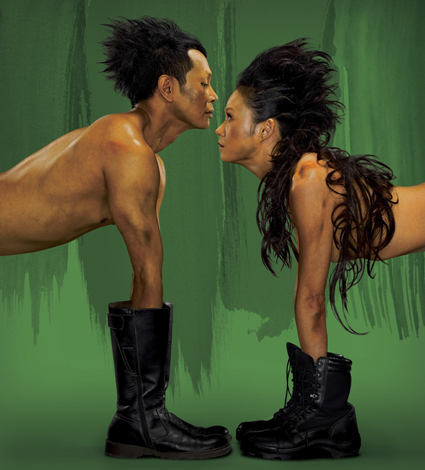
Animal Farm, Wild Rice
IN AN ERA OF INTERNATIONAL ARTS AND FILM FESTIVAL GIGANTISM, SMALL FESTIVALS HAVE TREMENDOUS COMMUNITY AND THEMATIC APPEAL, THE POTENTIAL FOR SHARED EXPERIENCE AND CLARITY OF PURPOSE. TEN DAYS ON THE ISLAND IS AN EXEMPLAR OF SUCH FESTIVALS. CURRENT ARTISTIC DIRECTOR ELIZABETH WALSH HAS BUILT SUBSTANTIALLY ON THE ORIGINAL THAT WAS MAGICALLY REALISED BY ROBYN ARCHER, THE FIRST ARTISTIC DIRECTOR OF TEN DAYS ON THE ISLAND (FOR WHOM WALSH WAS PROGRAM MANAGER, 2001, AND EXECUTIVE PRODUCER, 2002- 2005). I SPOKE WITH WALSH ABOUT HER FORTHCOMING THIRD AND FINAL FESTIVAL.
The festival has embraced more and more Tasmanian communities every two years, more island cultures around the world and tackled the very idea of ‘islandness.’ What’s been the focus of your approach?
What I really wanted to do with the 2011 festival was to get artists to engage for longer out in the community. So there’s a whole range of residencies all over the state. Theatre Newfoundland Labrador Youth Theatre is making work here with Launceston’s Second Storey. Melbourne’s Chamber Made Opera will be on Bruny Island [with Minotaur—The Island, a ‘reconstruction’ of a lost Monteverdi opera] and The Gertrude Association, also from Melbourne, will work with the King Island Cultural Centre [in a new media residency with an installation and workshops]. It’s about engagement between artists in communities that aren’t urban-centric—the festival itself isn’t urban-centric. It’s all over Tasmania allowing people out there to have the one-on-one experience of meeting an artist. This development over these three festivals has been the thing I find the most satisfying. It really changes the way in which people approach the festival—being more than just an audience.
How do these meetings work?
Often around projects or ideas that engage Tasmanian companies and artists through commissions which, where possible, have a broader creative presence than just providing performances. I’ve developed collaborations over these three festivals between young people passionate about music and professional music groups. There was the Tasmanian Youth Orchestra and the Strung Out Project in 2007, then access was provided for TYO in 2009 to Ethel [a string quartet from Manhattan] and in 2011 there’s a collaboration between the Australian Youth Orchestra’s Wind Quartet and the Tasmanian Youth Orchestra along with tutoring by the principal oboist of the Tasmanian Symphony Orchestra—potentially changing the creative output of younger artists.
Continuity’s important for you?
It’s like a longer conversation and finding new ways to develop it. It’s not just a flash in the pan.
The festival’s geographical scope seems to broaden each time too. How many towns did you ‘inherit’?
In 2001, for the first festival Anthony Steel’s report recommended eight and I think with Robyn Archer we actually did 32; 2007 was 52, last festival was 56 and this time round we’re going to 62.
They’re all willing partners?
(LAUGHS) Absolutely. If we didn’t go to certain areas, I’d be lynched. It’s one island and there are only half a million people here but the communities are very different in terms of their interests. It takes one good music teacher and suddenly you have an interest in string playing. It takes one person who’s interested in dance to wind up at a school like St Helen’s or someone with a passion for the visual arts, like Sally Marsden on King Island, and suddenly you’re able to not only support what they’re doing but also build opportunities in the community.
I don’t like using the term “community development,” because I don’t think that’s what it’s about. A lot of my work has been around putting artists in environments where they have opportunities to work in different ways in terms of situating their work. So Chamber Made Opera is going to a little hall on the end of Dennes Point on Bruny Island. I haven’t asked them to make work in a different way; I haven’t set up an environment where they’re necessarily going to change the creative experience that they’re engaged with. But certainly being there will change things—buying a loaf of bread at the local shop will change their own and locals’ experience. It’s about putting artists into different environments, changing not only them but the environment they’re in. If the world were full of more of those experiences, we’d be a better place. People take up the opportunity to meet and engage with artists like Ross Bolleter (RT91, p14) collecting old pianos on and off for three months for his work Ruined for the 2009 festival. How often do you get to meet a composer? It opens up the work to a broader audience and, I hope, people’s imaginations and inquisitiveness.
So, sometimes the artist might be working directly with people, sometimes it’s just being there that’s critical?
I’d like to think that Ten Days is not just a ticket price. It’s about evolving a whole range of different entry points for people, providing commissions that are the beginnings of conversations for artists and audiences and contributing to the broader sense of identity of this place. There have been particular projects that have been very important in this respect.
The Port Arthur Project [see rt review] in 2007 involved 27 commissions at Port Arthur with the University of Tasmania and Port Arthur as partners. In 2009 it was Trust, where we worked with the National Trust and, again, the university on commissions in five National Trust properties. And this time round we’re working on site-specific installations with the NRM North [Natural Resource Management Group] in the northern part of the state in five locations that are as diverse as a field, a community hall and a restaurant. The interest here has been about developing a conversation around built and natural heritage. We have so much built heritage here—that kind of “Georgian-ness” of the place. But my exploration’s been more about how contemporary Tasmanians articulate that history in a way that’s for now. Not that I’m saying don’t restore those beautiful homes or don’t touch the wilderness but, rather, how do we view these as they’re presented to us—for example as images for tourism.
Has the concept of a festival of island cultures from around the world evolved over the years?
It’s a fabulous idea. The genius of Archer, picking on the thing that seemed to be a disadvantage! Often small islands off continents—like Newfoundland and New Zealand—are the brunt of jokes, seen as backward and behind. What’s been interesting in the conversation generated by Ten Days on the Island is that it hasn’t been filtered through the main cultural hubs of the world. Not everything has to have been through New York or be the biggest thing or part of the star system that operates within more urban festivals. It liberates you to go out and really have a look at what people are doing in other places. Once upon a time would a show like Vestuport’s Metamorphosis for the 2009 festival have ever come to Tasmania? And that came from digging around in Iceland!
There are also links with international academic Island Studies about island dwellers experiencing not the same but very similar things: in the leaving of islands, in notions of the sea, in politics determined by the size of a place—Ivan Heng’s work from Singapore is significant here.
I see also there’s a Korean work for young people—Halmang, Myth of Jeju Island—about the mythology associated with an island off Korea.
And it’s been fascinating to find all that reggae material in the Pacific [Pacific Reggae: Roots Beyond the Reef]—an extraordinary kind of movement. So it’s not just islands or one kind of idea—the festival teases out a whole range of different kinds of connections that aren’t necessarily obvious. That’s the great thing for me as an artistic director—having several festivals gives you time to go digging and find those things that are not just literally the obvious connection.
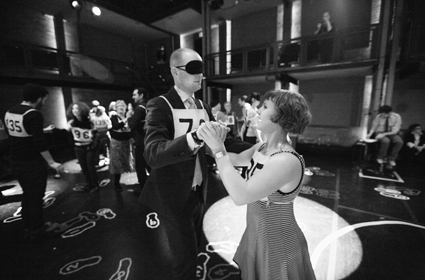
Dance Matathon, bluemouth inc
photo Gordon Hawkins
Dance Matathon, bluemouth inc
Are there shows that will particularly appeal to RealTime readers?
Dance Marathon by bluemouth inc (Manhattan-Toronto) represents the evolution of a particular kind of theatre form. Dancing, moving, having a partner and the dance marathon premise of the film They Shoot Horses Don’t They, these are the mechanisms through which the company explores a different kind of relationship between performer and audience. It’s fascinating.
Orwell’s Animal Farm, as adapted by Ivan Heng for Singapore’s Wild Rice, is an extraordinarily well-made piece of theatre in which the actors play the animals, transforming into them onstage. The dogs are fantastic: they’re just stupid. The show’s quite fantastic.
Daniel Barrow’s Every Time I See A Picture I Cry just won the Scobie Award for contemporary art in Halifax, Canada. Daniel works with layers of acetate on which he has illustrated the world of the narrative he’s about to tell. He manipulates the acetate using an overhead projector to animate the story. It’s exquisite. Right out there. It’s about a janitor sifting through the city’s garbage in order to create a phone book and a chronicle of the life of every citizen in the town. At the same time he’s being stalked by a serial killer. Another fascinating work and an exploration of a different form altogether.
Chronicles of Long Kesh, a theatre work from Belfast’s Green Shoot Productions, uses documentary style interviews as its basis. It’s tough material—we’re talking about the blanket protests and Bobbie Sands starving himself to death—and it’s hard to perform. But the structure comprises 10 or 15-minute vignettes, some only two minutes. These are interspersed with the songs the prisoners in The Maze used to sing to each other. One of the IRA guys was a choirmaster. Interestingly, it’s another story of an island—The Maze. Could that have happened in another place, that story? Guantanamo Bay is an island. When I saw the show, I couldn’t speak for half an hour afterwards. We know something of the story and ‘The Troubles’ but it’s something else to be in the dark with a great piece of theatre.
The 2011 festival program looks very good—ample shows, diversity of practice, location and invention.
The scale of our program is small, our budget is tiny. Maybe Darwin is smaller. But I look at the program and think, actually this is good—all sorts of ideas and experiences across the island. A lot of it’s about working partnerships. It’s great that after three festivals I can leave and think, We did good here.
Festival-goers should also look out for Stompin’s I ♥ Cars; Erth’s Dinosaur Petting Zoo; Djupid (The Deep) from Iceland and Scotland; version 1.0’s Bougainville Photoplay Project; Terrapin Puppet Theatre’s Australia-China collaboration, When the Pictures Came; New Zealand String Quartet; Craig Walsh’s Digital Odyssey; Julie Gough’s The Crossing; Ming Wong’s Life of Imitation, about the golden age of Singaporean cinema; Puso, by Philipino artist Richie Ares Doña; and Welsh visual artists Heather and Ivan Morrison working with locals, puppets and an old truck in Mister Clevver.
Ten Days on the Island, Tasmania, March 25-April 3, www.tendaysontheisland.com
RealTime issue #101 Feb-March 2011 pg. 25
© Keith Gallasch; for permission to reproduce apply to realtime@realtimearts.net
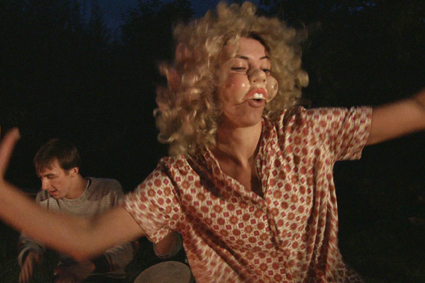
Children of the Commune, Audi Festival of German Film
german film: radical docs
One of the immediately fascinating components of the 2011 Festival of German Film program is Radical Docs, presented with ZDF/ARTE and described as exploring radical attitudes to life. In films about art The Radical Gardener (director Hermann Vaske) observes an artist striving to live up to the ideals of Andy Warhol, Malcolm McLaren and Meinhard Neese, while Super Art Market (Zoran Solomun) reveals the attitudes and lifestyles generated around the art markets of Berlin, New York and London. The lives of children in an Austrian commune are investigated in Children of The Commune (Juliane Großheim), while gated communities in America, Africa and Asia are revealingly scrutinised in On the Safe Side (Corinna Wichmann, Lukas Schmid). The full festival program, including more Radical Docs, will feature recent releases and a Retro program of significant films of the last decade. As ever, the festival is eagerly anticipated. Audi Festival of German Film, Palace Cinemas: Sydney April 6-18; Melbourne, April 7-18; Brisbane, April 7-12; Adelaide, April 13-18; Perth, April 14-18; program available March 15 www.goethe.de/australia
muffling muff
Whatever you might think of Melbourne Underground Film Festival director Richard Wolstencroft’s politics, the laying of charges against him by the Australian Federal Police for screening the Canadian film LA Zombie at the 2010 festival was nonsensical. In a recent press release Wolstencroft wrote, “Our only intention was to play this important work of cinematic art to an appreciative adult audience after its screening was cancelled by the Melbourne International Film Festival due the OFLC’s [Office of Film and Literature Classification] absurd decision not to grant it exemption to screen…Two months later my home was raided by police searching for a copy of LA Zombie. Why an artistic director who runs an established film festival like MUFF should have such draconian tactics…applied to him over a work of art in our day and age is another problem altogether. I had made sure two months earlier that I didn’t have a copy and that our only copy had been destroyed.” On January 20, Wolstencroft was issued with a summons to which, bizarrely, was attached “a diversion notice, agreeing to settle the matter without a felony on my record and with a donation to charity.” Had a formal charge been laid a gaol sentence and fine might have ensued. With pro bono help from leading lawyers, the MUFF director is working out what to do—let the issue drop or face the demands of challenging the AFP action. Wolstencroft has received letters of support from the film’s director Bruce LaBruce, Camille Paglia, Jack Sargeant and the directors of Locarno and the Raindance Film Festival. See Jack Sargeant’s account of the background and the key issues in RT99. Mystery MUFF: Freedom Of Speech Event and Fundraiser, Red Bennies, Chapel Street, Melbourne, Feb 27, www.muff.com.au
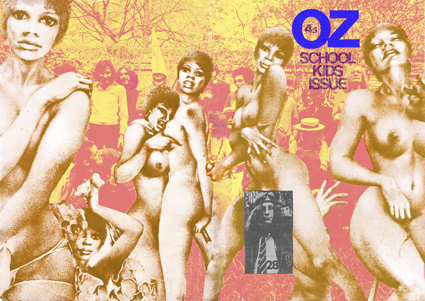
Cover of Oz magazine, part of Lampoon—An Historical Art Trajectory (1970-2010)
provocations: poster-cover-collage
Sydney’s enterprisingly mobile Arthere, run by photographer and curator Sandy Edwards and exhibiting in often unexpected venues, is staging an exhibition of Jim Anderson’s poster and cover art from the 60s and 70s at the Tin Sheds Gallery. As one of editors of Oz Magazine with Richard Neville and Felix Dennis in London from 1968-73 Anderson was charged with “Conspiracy to Corrupt Public Morals” and publishing an obscene magazine. For this exhibition the artist “has re-imagined some of those Oz covers (School Kids Oz, Homosexual Oz, Special Pig Oz) that the British Establishment found so offensive at the time.” Also on show will be Anderson’s more recent collages which he calls ‘lampooneries.’ Showing on the eve of the 40th anniversary of the Oz Conspiracy Trial and in conjunction with the 2011 Sydney Gay & Lesbian Mardi Gras Festival, the show promises a riot of colour and provocative opinions across half a century. Lampoon—An Historical Art Trajectory (1970-2010), February 18-March 12, Tin Sheds Gallery, University of Sydney, www.tinsheds.wordpress.com
the poster & the cultural revolution
For a different perspective on the politics of poster art of the 60s and 70s as propaganda, an exhibition at RMIT Gallery explores “the relationship between the political poster art of the Great Proletarian Cultural Revolution and its impact on contemporary Chinese art.” The show draws on the vivid original posters from the University of Westminster collection, works from collaborating artists Liu Dahong, Shen Jiawei, Li Gongming and Xu Weixin, and oral histories reflecting on the art of the Cultural Revolution. China and Revolution: History, Parody and Memory in Contemporary Art, RMIT Gallery, Melbourne, Jan 21-March 19, www.rmit.edu.au/rmitgallery
expanding dance worlds
With Dance Massive on the horizon in Melbourne, it’s great to see other programs announced, including Dance Bites from Western Sydney Dance Action & Riverside Theatres in Parramatta and the contemporary dance program at Campbelltown Arts Centre from curator Emma Saunders (p8). Dance Bites commences with Fiona Malone’s new large-scale work Picture Perfect (Feb 16-19) which follows a woman in her quest for physical perfection—how far will she go? Other works in the program will come from Narelle Benjamin and Frances Rings in a double bill, and collaborations between Martin del Amo and Ahil Ratnamohanm and Lisa Griffiths and Craig Bary. In Perth MOVEME.ORG.AU, a new promotional body for contemporary dance is hosting six productions across the year, including Buzz, WAAPA’s Link, Strut and Daneil Micich. Dance Bites, Riverside Theatres, Parramatta www.wsda.org.au/projectscur.htm; www.riversideparramatta.com.au;
MOVEME.ORG.AU, Perth
mardi gras: common noise
Once upon a time, the Sydney Mardi Gras ran a seriously engaging discrete arts festival as part of its annual celebrations. Now in one small step for man, as part of Mardi Gras 2011, Chronology Arts has engaged five emerging composers (Andrew Batt-Rawden, Nicholas Ng, Marcus Whale, Lachlan Hughes, Max Bendall) to write works for Common Noise—an art-music concert delving into sexuality and masculinity through music. The performances include sections of senior composer Colin Bright’s Book of Cock song cycle. Common Noise, Supper Club, Oxford Hotel, Sydney, Feb 19 & 23, 7pm,
www.chronologyarts.net, www.mardigras.org.au
blade runner re-worked
Ridley Scott’s sci-fi classic Blade Runner (1982) continues to be an inexhaustible source of inspiration and theorising. Why you might replace Vangelis’ score (superior to the composer’s other output) with your own and edit scenes from the film is a mystery that will only be solved by seeing.
Berlin-based filmmaker and sound artist Zan Lyons perform with viola, foot pedals and laptop while simultaneously remixing and reworking the film. The performance comes at the end of GoMa’s film program, A New Tomorrow: Visions of the Future in Cinema, which coincides with the exhibition 21st Century: Art in the First Decade. Cinematheque, Gallery of Modern Art (re-opening, post flood, Feb 13), Brisbane, Feb 26, 27, http://qag.qld.gov.au/cinematheque/current/21st_century_cinema
expanding the australian sound sphere
The Australia Council is inviting Australian musicians, sound artists and media artists working in sound to apply for a 3-month residency in the AlloSphere at the University of California, Santa Barbara. “The Allosphere is a 30-foot diameter sphere built inside a three-storey near anechoic (echo free) cube. It allows for synthesis, manipulation, exploration and analysis of large-scale data sets in an environment that can simulate virtually real sensorial perception….The AlloSphere is an instrument similar to the telescope, in that it enables scientists to see data in new ways in fields ranging from nanotechnology to theoretical physics, from proteomics to cosmology, from neurophysiology to the spaces of consciousness, and from new materials to new media. But it is has also been compared to a musical instrument or orchestra…” The Australia Council, through its Music Board and the Inter Arts Office, is the first organisation in the world to support a formal artist residency at the AlloSphere, in partnership between with the University of California Santa Barbara. Allosphere Residency, www.australiacouncil.gov.au/grants/grants/allosphere_residency; www.allosphere.ucsb.edu
RealTime issue #101 Feb-March 2011 pg. 26
© RealTime ; for permission to reproduce apply to realtime@realtimearts.net
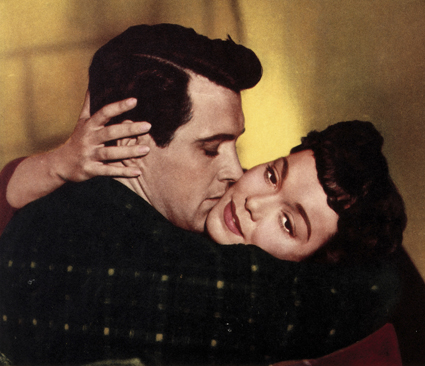
Rock Hudson, Jane Wyman, All That Heaven Allows, Douglas Sirk
IN THE 1950S THE FILMS OF DOUGLAS SIRK WERE CONDEMNED AND DISMISSED BY SOME REVIEWERS AS LOW BROW, POPULAR FANTASIES FOR WOMEN—OVERLY DRAMATIC, HYPER-EMOTIONAL AND SENTIMENTAL. IN THE SATURDAY REVIEW, ARTHUR KNIGHT DESCRIBED IMITATION OF LIFE (1959) AS “LIFE AS [AUDIENCES] WOULD LIKE TO BELIEVE IT, AND IT MAKES GOOD MOVIE MATERIAL—AT LEAST FOR A MATINEE.” THE MONTHLY FILM BULLETIN’S REVIEW IDENTIFIED THE FILM’S DUAL FORCES, DESCRIBING IT AS “HIGH-CLASS PULP FICTION” AND SUGGESTING THAT, “ITS ONSLAUGHT ON THE EMOTIONS IS ALMOST ENTIRELY SYNTHETIC…ITS ATTITUDE TOWARD ITS RACIAL PROBLEM IS DEBASED AND COMPROMISED.”
However, Sirk’s melodramas were embraced in the 1980s and ‘read against the grain’ as rich and revealing film texts that were simultaneously reflecting and critiquing the culture of their production. By developing intricate narrative patterns encouraging identification and catharsis, Sirkian melodramas were seen to function as ‘safety valves’ for patriarchy, siphoning off cultural anxieties.
Douglas Sirk was an art historian when he began his career as a director of German theatre and cinema during the 1920s. Influenced by the style of German Expressionism, particularly its projection of a character’s psyche onto an artificial external space, Sirk brought this vision to Hollywood, and this aesthetic defined the melodramas he directed for Universal Studios. He was also inspired by the politicised theatre developed by Brecht and used techniques of ‘distanciation’ to provoke an active, critical spectator. As a result, the universe created in Sirk’s melodramas deliberately breaks with realist conventions, creating artificial worlds. An excessive mise-en-scène is constructed with a use of frames within frames to separate characters; mirrors and reflective surfaces to suggest split, or multiple identities; spaces that are segregated; and vivid colours to highlight character traits. The melodramas explore time in narrative, prioritising accidents, interruptions, coincidence, fate and particularly the trope of being ‘too late.’
Sirk’s films feature a fascination with failure. Magnificent Obsession (1954) features an array of plot twists and parallel worlds beginning with the resuscitation of the rogue playboy and jet boat pilot Bob Merrick (Rock Hudson) at the expense of the life of the respected Dr Wayne Phillips. The film details the anguish and affection of a burgeoning romance between Helen Phillips (Jane Wyman) a character who introduces herself to Bob as “Mrs Wayne Phillips.” While trying to escape Bob’s clutches, Helen is hit by a car, resulting in a blindness that can only be cured by Bob’s return to his earlier career—neurosurgery. Sirk’s All That Heaven Allows (1955) uses the same stars to explore the controversy of a ‘May/December’ relationship, with Jane Wyman as Cary, the older woman battling resistance to her affair with Ron (Rock Hudson). The image that resonates most from this film is the reflection of Cary framed in the screen of a television her son and daughter have bought her for Christmas, hoping to distract her from unbridled passion.
Films like Imitation of Life (1959) use ‘spatial narration’ to define the importance of space and power in the cinema. Sirk’s spaces carry reference to class, status, wealth and dominance, symbolising exclusion, division, restriction and segregation. This is clear in the opening shots of Imitation of Life as Lora Meredith (Lana Turner) searches for her child on the boardwalk. Annie Johnson (Juanita Moore) and Sarah Jane (Susan Kohner) are looking after Susie (Sandra Dee) in the shade beneath. When they share an apartment, Annie and Sarah Jane are relegated to the broom cupboard, a space that Lora describes as:
“a little place off the kitchen…but you could hardly call it a room.” In their country home Lora and Susie have access to the more formal public rooms, while Annie and Sarah Jane are confined to the kitchen and the rear of the house. Sirk highlights the dislocation and segregation with an image of the rebellious Sarah Jane speaking with a Southern twang as she delivers crawfish to guests, carrying the plate on her head.
While Sirk’s Hollywood melodramas were misunderstood on their release, his film work continues to exert a significant and lasting impression on contemporary visual culture. The impact is evident in remakes like Far From Heaven (Todd Haynes, 2002) and on the small screen in the series Mad Men (2007-), but these revisions are never quite as aesthetically vibrant, narratively complex or as incisive in their cultural critique as Sirk’s progressive ouvre. Douglas Sirk’s films are so loaded they almost split apart at the seams.
Douglas Sirk: King of Hollywood Melodrama, Madman Entertainment,
Courtesy of Madman Entertainment and in celebration of our 101st edition, RealTime is offering a lucky reader a ravishing cinematic giveaway: a 9-DVD box set of the great films of the 1950s master of aesthetically and socially incisive Hollywood melodramas, Douglas Sirk. To compete for the Sirk DVD set go to: www.realtimearts.net/sirk_survey.html
RealTime issue #101 Feb-March 2011 pg. 28
© Wendy Haslem; for permission to reproduce apply to realtime@realtimearts.net
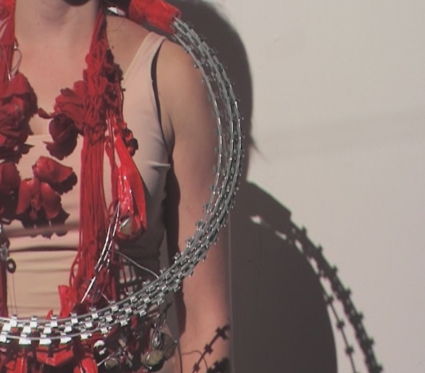
a study in red weight, Rebecca Cunningham, Exist-ence 2010
video still Nicola Morton
a study in red weight, Rebecca Cunningham, Exist-ence 2010
EXIST-ENCE IS AN ANNUAL TWO-DAY FESTIVAL OF PERFORMANCE ART, LIVE ART AND ACTION ART CURATED, PRODUCED AND PRESENTED BY BRITTANY GUY, LAUREN CLELLAND AND REBECCA CUNNINGHAM IN BRISBANE. LAST YEAR THE THIRD FESTIVAL TOOK PLACE IN THE SHOP-FRONT AT THE JUDITH WRIGHT CENTRE OF PERFORMING ARTS, BUT WENT LARGELY UNHERALDED.
The event receives no funding and, although the space was generously donated, the creators of this event expend their time and labour gratis. Likewise artists pay for their own materials and perform for free. The modest admission fee covered front of house and technical assistance, but equipment was loaned by the big-hearted Kim Machan—the same Kim Machan who created the Multimedia Art Asia Pacific festival (MAAP) that went off-shore to China through lack of funding here.
Let’s hope history doesn’t repeat itself, because Exist-ence is professionally presented, from the appealingly bound program that includes a useful guide to global performance websites to the continuous live streaming of international artists on the walls of the space, and represents an independent, accessible and welcome renewal of exploration and exposure to this artform in Queensland for another generation.
The Exist-ence initiative is reminiscent of the ferment of ideas and investigation of new forms explored in the 1990s in Brisbane by artist driven venues such as The Crab Room and Cherry Herring. Nick Tsoutas at the Institute of Modern Art, Joseph O’Connor at Metro Arts and Jude Abernathy at Van Gogh’s Earlobe all provided support and space for independent performance artists. Luminary Queensland performers who cut their teeth in such spaces during this period are now well known: Christine Johnston, Lisa O’Neill, Brian Lucas… What surprised me was that while performance art continues to thrive as a discrete practice, especially overseas, I had wrongly attributed its demise in Brisbane to its having been subsumed under the rubric of contemporary performance. New circus, for instance, seems to have completely amalgamated performance art into its praxis.
At Exist-ence there was the expected atmosphere of a jamboree and some quietly subversive touches. You could avoid the rather pricey front bar and earn free drinks by screaming into the interior of a suitcase that was placed on a table with finger food that you were invited to eat “at your own risk.” An inter-generational contribution that nicely sutured the seeming hiatus in the handing down of a ‘tradition’ came from Jan Baker-Finch who believes “in the two-faced truth, in the Either, the Or and the Holy Both.” She improvised dance with enviable suppleness and, dressed in a series of fantastical costumes fashioned from ever recurring green garbage bags, made personal interventions with the audience. Dan Koop from Melbourne in his performance Wish you Were Here, sat at a table offering to personally hand deliver post card messages within five kilometres of the Judith Wright Centre. Throughout the hand delivery process DJK International mapped the route by sending live delivery update reports, ironically, via Twitter. Part corporate spoof, part re-humanising latter day communications, it was a sweet idea and in great demand—I sent my first Humanogram to a couple expecting their first child who were both bemused and delighted by Koop’s deadpan ‘delivery.’
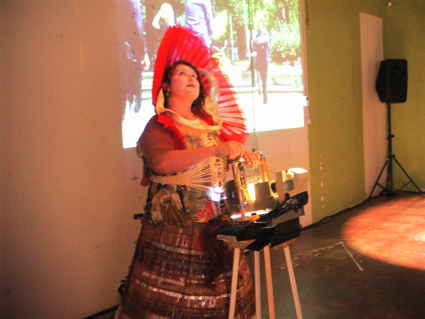
Velvet Pesu
Describing her art and life as inseparable, the striking figure of Velvet Pesu was a living sound sculpture who phenomenally endured during most of a long night. Concentric Circles on Red was an experimental piece combining audio made from inventively recycled materials secreted as part of her costume with her own superbly improvised vocals. She stood like a tall tree in a forest with the hauteur of an Elizabethan aristocrat or Aztec princess, wearing a shark’s jawbone and a ruff made from recycled venetian blinds. A visual artist and experimental filmmaker, Pesu looked up towards what looked like handmade film thrown on the ceiling by an antique projector. The artist possesses the only remaining bulb for the machine, and I was moved by this detail, significant of her wholly committed, unique way of life. I was less convinced by Nicola Morton’s claims to be “a writer-artist-future-time woman” declaring “the end of capitalism.” If only. But this might be a grumpy response to what appeared suspiciously like one of those getting to know you drama exercises I temperamentally abhor. We were asked to perform yogic breathing while twirling like Sufis and sticking bright dots all over our neighbours. Ugh.
If Morton attempts in an admittedly light-hearted fashion to hypnotise the audience, Rebecca Cunningham is attracted to the meditative, trance-like state she enters during a performance. In a study in red weight, she wore a red dress and wove a garland of red roses round her neck. To the roses were added successively layered necklaces of red wool and washers, bondage tape, stones and what appeared to be razor wire and ribbon that left scarlet indentations on the artist’s bare shoulders. As she kneeled and rhythmically rocked in a penitential posture, weighty stones clashing and grinding the bouquet to bits, I was inclined to read these signs in terms of the kind of psychological-political analysis of sexuality in a patriarchal world familiar from feminist discourse. However, Cunningham disavowed any such intentions, referring me back to the text accompanying her action: “what has come before, what is ahead, no matter. Living in the here, living in the now is where I want to be. With you living in the here, living in the now… There is no them, there is no then. Only we, only now.”
Cunningham’s brave action appeared to recapitulate aspects of an earlier Mike Parr-like body art where the focus on the abject appeared self-obsessive, but it also seemed positively to reiterate the axiom that innocence, consciously or not, longs for experience, longs to be different from itself. Taken along with her text, Cunningham’s display of overt masochism seemed a vivid reminder of the Zen notion translated by 1960s writer Alan Watts into the proposition that we are in fact a sort of resistance in the middle of the flow of life. As life impinges on you, you hurt, and so you know that you are here. Perhaps it was the shock of alterity that induced us to share the moment. Cunningham’s piece at any rate seemed to bear out Parr’s original observation that “the eye of the audience is submerged in the body as in a wound.”
Melody Woodnutt is a descendent of pirates and claims to have stolen her arts education while flirting with arts institutions internationally. Bravo! Recently returned from a residency in Iceland, her work Lines and Flux reflected her stay there. Part visual installation, part live art, her piece centred on a nomadic, ecological way of thinking that was reminiscent of 70s preoccupations overlaid with Woodnutt’s “meditation on lines, borders, boundaries and the path of (least) resistance.” The work enacted the temporal installation of an environment on the border of land and sea. There was a pile of heavy stones, one of which a member of the audience was tasked to interminably weigh. Earth was poured from sandbags in the ‘interior,’ eventually to be mixed by Woodnutt dragging a fishing net between her toes, eliding borderline distinctions. More metaphorical were the string and tape that excluded the audience beyond another border between themselves and the performer, but also highlighting the glut of the eye which easily penetrated all barriers. In Woodnutt’s moveable dialectic, it is the crossing of borders and boundaries, or the place where they intersect which is important. The ‘I’ consciously situates itself between the two. As Derrida puts it, “we have to cross the border but not to destroy the border.”
Derrida’s prohibition, of course, is blithely ignored by the forces of global capitalism. They are the ones who literally mix up the world. Although I didn’t have the opportunity to speak with Woodnutt, her work could not have been ignorant of the economic basket case Iceland became as one of the first victims of the capitalist meltdown. As we saw on television, Iceland (tied in with a Scottish investment bank that likewise foundered) fell hook, line and sinker for the shibboleths of economic rationalism and invested its national savings in global hedge funds. Viewed from this perspective, Woodnutt’s performance proved all the more politically astute.
The future for Exist-ence includes plans to bring out international powerhouse La Pocha Nostra in September for the fourth international Exist-ence festival and, with a little luck, Black Market International in 2012. Boringly, such big dreams depend on funding. However, they will persist in any event. At the moment the curators are looking for a space to promote performance art, live art and action art in Brisbane on a regular, perhaps bi-monthly basis. Any offers out there?
Exist-ence, a festival of performance art, live art and action art curated, produced and presented by Brittany Guy, Lauren Clelland, Rebecca Cunningham; live performances created and performed by Jan Baker-Finch, Dan Koop, Nicola Morton, Velvet Pesu, Melody Woodnutt; Judith Wright Centre of Contemporary Art, Brisbane, Nov 26-27, 2010; http://existenceperformanceart.wordpress.com
RealTime issue #101 Feb-March 2011 pg. 42
© Douglas Leonard; for permission to reproduce apply to realtime@realtimearts.net
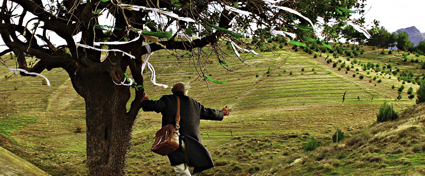
Whisper with the Wind
photo Javad Jalali
Whisper with the Wind
IF A POSITIVE SPIN CAN BE MADE OF THE FLAGRANT MONOPOLISATION OF WHAT WE USED TO CALL ART-HOUSE CINEMAS IN THIS COUNTRY, IT IS THE INCREASED RESPONSIBILITY THAT AUSTRALIAN FILM FESTIVALS NOW HAVE TO EXHIBIT DIVERSE, UNIQUE AND VITAL FILMS FROM ALL PARTS OF OUR WORLD. WE KNOW WE WON’T SEE MUCH BEYOND BATMAN FOR THE REST OF THE YEAR (UNLESS WE LOOK REALLY HARD), SO WHEN OUR LOCAL FESTIVAL COMES ALONG IT BECOMES NECESSARY TO BEHAVE MUCH AS A CAMEL WOULD AT AN OASIS, AND FILL UP WITH A YEAR OR TWO’S WORTH OF INTERESTING CINEMA IN A FEW SHORT DAYS.
Festivals are, of course, not immune to the kind of intimidation of which small independent cinemas are clearly victims. Festival organisers too can succumb to the fear that an unusual, ‘excessively internationalist’ program won’t attract an audience weaned on superheroes. It’s extremely pleasing then, when a young film festival like Adelaide’s holds firm to its original game plan and offers a spread of films designed to challenge rather than appease its audience.
Since 2007 the Adelaide film festival has been headlined by its competition group, a selection of a dozen films often indicative of the program at large. This year the competition’s emphasis on stylistically distinctive cinema continues. Established masters like Raoul Ruiz and Patricio Guzman line up next to newcomers and lesser-knowns like Kurdish Shahram Alidi and Australian Beck Cole (whose debut feature Here I Am premieres at the festival). And for the first time two documentaries are included in competition: Guzman’s Nostalgia for the Light (Nostalgia de la Luz) and Australian Mathew Bate’s Shut Up Little Man! An Audio Mis-Adventure.
The decision to include documentaries in competition is as bold as it is curious, and it could be asked how a documentary can be fairly evaluated against narrative films in a prize for ‘best feature.’ Oddly enough, the inclusion is rather fitting for this year’s selection. More than a couple of those entries designated as ‘narrative features’ are themselves barely narratives at all, or at least barely fiction. One of the standout artistic merits of this year’s competition is that so many of the films carefully traverse the gap between life and art. The distinction between documentary and fiction becomes a lot less clear cut than we might assume it to be.
Radu Muntean’s Tuesday, After Christmas (Marti, Dupa Craciun) is a remarkable case in point, another gem from the current wave of great Romanian cinema. It combines a modest but passionate interest in adult relationships with a long take style that might be called bravura were it not so unassuming. Moving his camera only when necessary, and yet also refusing to cut into the action in order to drive a point home, Muntean respectfully and very skilfully allows his actors and his audience space to experience and interpret the story, that of a man who follows his heart wherever it goes and the ensuing catastrophe this brings his family. This is a truly great accomplishment of cinematic realism, wholly avoiding dogma in both tone and message. Some films we watch because they offer us a view of another world, others we can watch because they reveal our own lives taking place in another country.
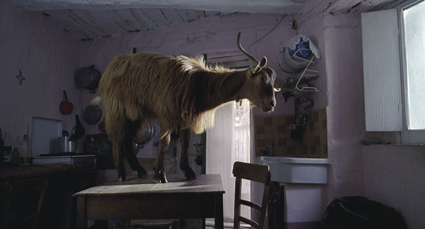
The Four Times (La Quattro Volte)
If Tuesday, After Christmas offers a seamless kind of domestic realism, two other films in this year’s competition present a more poetic type of realism, of life beyond the day-to-day. Quite unlike anything I have ever seen, Michelangelo Frammartino’s The Four Times (La Quattro Volte) is a wordless ‘narrative’ that follows the transmigratory passage of a dying Calabrian goat-herd’s soul from human incarnation to animal (a baby goat), to vegetable (a pine tree) and finally to mineral (charcoal). Unusual though the plot may be (you might care to think of something more unusual) the filmmaker’s approach to the mystical content is anything but fantastical. Again, with extremely restrained long takes (many several minutes long) the action presents itself as a perfectly natural course of events. As with much great realist cinema, what the Four Times offers is an awareness of the world as a work of art, and of our movement through it.
Similarly in Year Without A Summer, Malaysian director Tan Chui Mui takes us on a journey that is as much about its setting as its characters. Long departed and forgotten friend Azam returns to his childhood fishing village, emerging from the sea like some monster to spend the night with his dear friend Ali and Ali’s wife Minah. Bobbing in their small boat on the moonlit ocean the friends rejoice with memories and folk tales, themselves resembling mythical figures in a watery dream world. Things suddenly change however, when the film returns to the much harsher world of Azam’s childhood. An elusive and very lyrical film, Year Without A Summer displays Tan Chui Mui’s highly developed visual sensitivity. The way digital video is used to capture moonlight on the Malaysian coast is alone reason enough to see this film.
More lyrical still is the Kurdish elegy Whisper with the Wind (Sirta la gal ba), winner of the Young Critics Award at Cannes. Paradoxically both eclectic and solemn, Whisper with the Wind conveys the period and place of the Kurdish genocides, known as ANFAL, which took place in the late 1980s in Kurdistan (Northern Iraq) under Saddam Hussein. The opening titles inform us that during these years 32,000 Kurds were murdered, many buried alive (though other estimates suggest as many as 180,000). Following the trail of message carrier Mam Baldar through decimated Kurdish communities, Whisper in the Wind presents a poetic and harrowing portrait of this profoundly troubling event. Whether or not the Kurdish genocide validates, or is in any way related to, the 2003 invasion of Iraq is not a question easily answered. What is certain is that a film like this in the 2011 competition powerfully illustrates the vital role that film festivals can play in a sheltered culture like Australia’s.
Other entries in competition for the International Award for Best Feature include the Peruvian black comedy October (Octubre) directed by brothers Daniel and Diego Vega, Kelly Reichardt’s acclaimed indie American western Meek’s Cutoff and Canadian writer-director Denis Villeneuve’s Incendies.
2011 Bigpond Adelaide Film Festival, Feb 24-March 6; www.adelaidefilmfestival.org
RealTime issue #101 Feb-March 2011 pg. 29
© Tom Redwood; for permission to reproduce apply to realtime@realtimearts.net
Fluid Network from RAPADURA STUDIO on Vimeo.
SHORT AND RELATIVELY SIMPLE, FLUID NETWORK WON JAMES COOK UNIVERSITY’S SCHOOL OF CREATIVE ARTS SECOND ANNUAL SCREENGRAB NEW MEDIA ARTS PRIZE. CLEVERLY AND SUCCINCTLY ADDRESSING THE THEME OF ‘NETWORK,’ THE VIDEO WORK BY BRAZILIAN ENTRANTS JULIANA GOTILLA AND IZABEL RAINER HARBACH OF RAPADURA STUDIO RELIES ON FAMILIAR VISUAL AND SONIC MARKERS ALLIED IN AN UNEXPECTED WAY.
A world map with the continents formed from water on a slick white surface is the initial visual. Arresting for a number of reasons, it displaces/reverses where we think the land and ocean should be, so it’s already messing with our world as we know it; and it immediately raises questions as to how the effect is technically achieved—is it actual water, or a digitally embossed effect?
The map image remains static just long enough to allow us to contemplate these mysteries before the soundtrack kicks in with old school dial-up internet connection sounds, followed by scratchy static. As the sounds continue, drops of water begin to rain randomly onto the world map and the continents lose their distinct outlines. While the visual aspect gradually changes, the audio progresses through all those chirpy little alerts which tell us we have new emails, or someone wants to chat with us online. The fluid continents bleed and grow into supercontinents and then meld in a single world pool to a musical finale of a repeated Skype ringtone.
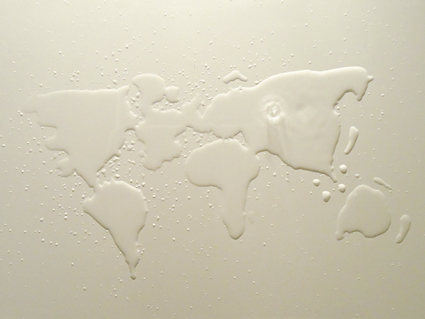
Fluid Network, Rapadura Studio, Winner Screengrab 2010
courtesy the artists
Fluid Network, Rapadura Studio, Winner Screengrab 2010
The sedate, watery video is wonderfully at odds with the anxiety-inducing soundscape, even though some of the net noises mimic plops and splashes. Gotilla and Rainer Harbach are obviously playing on their audience’s investment, socially and economically (and therefore emotionally) in internet communication. They are not telling us anything new about contemporary reliance on electronic interaction or how access is perceptually shrinking geographic distance, spanning oceans and redefining borders. Nor are they making any particular judgement about whether this is good or bad. But Fluid Network simply illustrates the intangible in an original, engaging way employing basic and familiar elements. The use of water both for its fluid properties and as a metaphor for universality is inspired.
Another video work from Italy, Multimedia Head by Osvaldo Cibils, shares the tactile, analogue sensibility of Fluid Network, but examines a deficit of the communication network—the compromise of personal identity under the weight of accumulated data. Cibils has taped himself taping things to himself, quite literally. We first see his face unadorned, then watch as he attaches a cassette tape, a mobile phone, a book, a flash drive, a media disc, and so forth, to his head with masking tape. His clumsiness is mildly amusing, the action is laboured, but bewilderment as to his motive keeps the viewer glued for almost five minutes to see the outcome. In the end, Cibils is totally obscured, resembling a mummy who has fallen into a bargain bin at a Dick Smith outlet, the lens of a digital camera staring out in place of an eye. Emphasising the symbolic dehumanisation in process, Cibils doesn’t speak a word throughout.
Questions of compromised electronic identity are also played out by Boris Eldagsen in Spam: the Musical; a genre-bending, theatrical and very funny episode subtitled The Lonely Girls. Three young women with a variety of accents, dressed in pyjamas, battle for a hairbrush pretend-microphone via which to relate texts taken from actual spam emails from love-lorn Eastern Europeans and Africans requesting help to claim inheritances, giving out false names, lying about their height—all delivered with disarming sincerity.
The additional Deleted Scene is also a take on image manipulation, but in total contrast to the visual fluffiness of the first part. A woman sits in a spotlight in a cabaret setting wearing a sequinned top and smudged mascara, while three sets of anonymous hands move her arms and mouth to mime a bluesy version of the AC/DC song “TNT (I’m Dynamite).” She is a marionette at their mercy and the song mocks her helplessness. It is compulsive to watch, but very disturbing, hinting perhaps at the systemic malignancy behind scamming and identity theft.
The UK’s Marco Donnarumma’s Golden Shield Music subtly draws our attention to political manipulation, using China’s IP censorship (the Golden Shield Project) for a generative net art composition. The work collects the IP numbers of the 12 most-blocked websites and assigns them musical notes, generating a free-form composition. The idea of random and creative art emanating from a project intended to repress individual freedom and limit access to information is the beauty of Golden Shield Music, even if the screen visual, a list of IP numbers, isn’t particularly compelling.
Silica-esc by Vladimir Todorovic of Singapore is a generative movie about a new supercomputing platform introducing itself to potential users with extravagant promises of becoming a means to ‘unite all mankind’. The graphics are mesmerising—cold, sophisticated and seamless matrices. Despite the apparent gravity at the start of the eight-minute work, the tone quickly becomes tongue-in-cheek as a rich woman and a farmer, each represented by a different roiling geometric form, discuss (in English-subtitled French) who caused a car accident, quickly descending into a class-based slanging match. Silica-esc (in Chinese) also boasts that all individual expression and feeling is recorded in “our spiritual data segment” for classification and dissemination via Spiritupedia. Others will become your friends and “celebrate and rejoice in your networked spirituality in unity.” By sending up the persistence of humankind’s eternal power struggles and search for meaning, Todorovic seems to be acknowledging that any means by which we choose to communicate and interact will still reflect innate human strengths and weaknesses.
Many of Screengrab’s 17 finalists test the limits of technologies as artistic media while hypothesising the potential and pitfalls of the system even as they use it. The role of the artist, regardless of the preferred media, is evidently intact.
The winning work Fluid Network, and the complete list of finalists can be viewed at: www.jcu.edu.au/soca/JCUPRD1_066890.html
Screengrab, School of Creative Arts New Media Prize, eMerge Media Space, James Cook University, Townsville, Oct 15-Nov 18, 2010
RealTime issue #101 Feb-March 2011 pg. 30
© Bernadette Ashley; for permission to reproduce apply to realtime@realtimearts.net
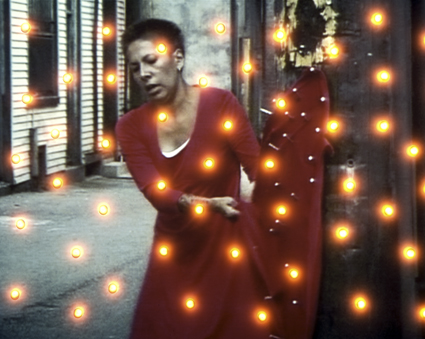
Rebecca Belmore, The Named and the Unnamed, 2002, video installation, Collection of the Morris and Helen Belkin Art Gallery, The University of British Columbia
photo Howard Ursuliak, © the artist
Rebecca Belmore, The Named and the Unnamed, 2002, video installation, Collection of the Morris and Helen Belkin Art Gallery, The University of British Columbia
THE BRINGING TOGETHER OF INDIGENOUS CULTURES FROM THE PACIFIC REGION, WHETHER IN LARGE SCALE EVENTS LIKE THE ASIA PACIFIC TRIENNIAL OR SMALLER BUT SIGNIFICANT SHOWS LIKE JENNY FRASER AND LUBI THOMAS’ BIG EYE: ABORIGINAL ANIMATION FROM AUSTRALIA AND CANADA (RT91, P26) YIELDS INSIGHTS FOR BOTH ARTISTS AND AUDIENCES ABOUT INDIGENEITY AND ART IN A BROADER THAN USUAL CONTEXT. STOP(THE) GAP IS SUCH AN EVENT, ONE WITH AN EXCITING, TIMELY FOCUS ON MEDIA ARTS.
As part of its celebration of the moving image in visual art, the 2011 Adelaide Film Festival is partnering the University of South Australia’s Samstag Museum of Art to present Stop(the)Gap: International Indigenous Art in Motion. Curated by Brenda L Croft, the exhibition will bring together from Australia the considerable talents of filmmaker Warwick Thornton, leading new media artist r e a and curator and media artist Genevieve Grieves (Bunjilaka, Melbourne Museum).
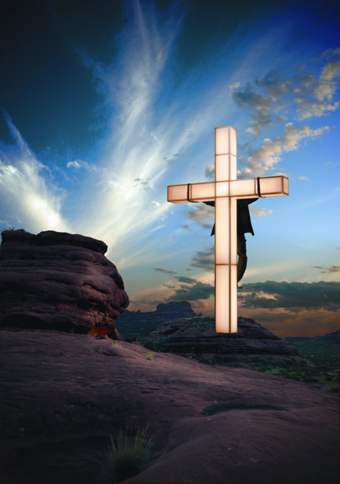
Warwick Thornton, Stranded, 2011, film still, commissioned by Adelaide Film Festival Investment Fund 2011
© the artist
Warwick Thornton, Stranded, 2011, film still, commissioned by Adelaide Film Festival Investment Fund 2011
Warwick Thornton’s contribution to Stop(the)Gap, commissioned through the Adelaide Film Festival Investment Fund, will be on show at the Samstag Museum while r e a and Genevieve Grieves will screen their creations outdoors at Port Adelaide’s historic Harts Mill.
The Australians are joined by a range of visiting major artists: Rebecca Belmore (performance, installation; Canada’s official representative at the 2005 Venice Biennale, Sydney Biennale, 1988), Dana Claxton (Canada; video, performance; Sundance Film Festival; 2010 Biennale of Sydney; Microwave, Hong Kong); Alan Michelson (USA; digital photography, video and glass), Nova Paul (NZ; photography, film: fascinating three-colour separation images of New Zealand sites), Lisa Reihana (NZ; Campbelltown Arts Centre’s Edge of Elsewhere, 2010 and major Australian galleries have shown her richly textured photomedia portraits) and Erica Lord (USA; interdisciplinary artist; striking photographic work).
In the Stop(the)Gap press release, Brenda Croft writes, “Some of the most provocative and illuminating moving image work today is being created by Indigenous new media artists—yet there has been no international focus on this work until now. Despite physical distances, Indigenous communities around the globe are linked through their shared colonial histories, each bearing the scars borne of dispossession, injustice, inequality, and misrepresentation.” Croft has “selected works challenging preconceptions of contemporary Indigenous expression and addressing themes of human rights, environmental concerns, cultural security, and negotiating diversity.”
At the very same time as they provoke us, the works of these artists display the seductive power of art, using bodies, film, video, new technologies and a potent sense of place to transform a problematic world into one that fascinates as much as it challenges, thereby further opening us up to the riches of Indigenous cultures.
2011 BigPond Adelaide Film Festival and Samstag Museum of Art: Stop(the)Gap: International Indigenous Art in Motion, Feb 24-April 21, www.adelaidefilmfestival.org and www.unisa.edu.au/samstagmuseum
RealTime issue #101 Feb-March 2011 pg. 30
© RealTime ; for permission to reproduce apply to realtime@realtimearts.net
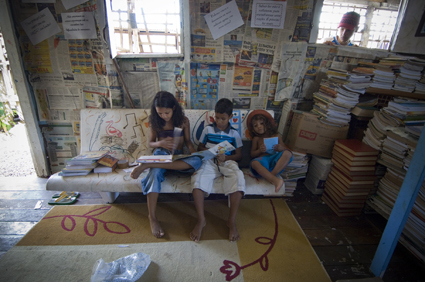
A Mao e a Luva
WHEN MICHAEL O’ROURKE ATTENDED THE INTERNATIONAL FEDERATION OF FILM SOCIETIES’ ANNUAL GENERAL MEETING AND WORLD CONFERENCE IN RECIFE, BRAZIL, LAST DECEMBER, HE EXPECTED DAYS OF TALK AND DISCUSSION AND THE OCCASIONAL FILM SCREENING. HE DIDN’T ANTICIPATE HAVING ONE OF THE MOST UNEXPECTED AND MOVING VIEWING EXPERIENCES OF HIS LIFE. BUT HE DID.
The Pina favela is one of the poorest and most deprived areas of the city of Recife, and it was in the favela, in Bullet Square (a place rumoured to see two murders a day), where a screen was erected one evening to show a new documentary. All the IFFS delegates were invited to see A Mao E A Luva, which had been filmed within the favela. They sat watching with crowds of favela residents, who laughed and cried as they viewed a film in which they and their children appeared: a film about something and somebody very important to them. And Michael O’Rourke, with years of experience watching emotional and harrowing stories on film, reports that it was the most moving experience of his filmgoing life, to watch this uplifting, hopeful film, amongst people to whom it meant so much.
The Pina favela spreads along the banks of the river, and it is here that Ricardo Gomes Ferraz, now aged 35, better known as Kcal, a poet and musician, has turned his shabby waterfront house into a library for the children of his community. For over 15 years he has used all his spare resources to buy second-hand books in different places all over the city to gradually establish a library that has now become a meeting place for hundreds of children and adults—“where dreaming is not forbidden, where imagination can fly to places very different from the favela,” as Kcal says.
Drugs and prostitution are constants in daily life in the favela, but for Kcal that life changed when at 16 he found and read a book, A Mao E A Luva, by Machado de Assis (a 19th century writer, descended from slaves, now regarded as one of Brazil’s most important). He realised the importance of reading—and from that day on he has never stopped—then passing it on to children. In 2008, this man, who defines himself as “a dealer in books,” received an esteemed national award in recognition of his work but, more importantly, a government project has evolved which has seen the opening of many libraries in the favelas; from the original founded by Kcal, another 514 libraries are functioning all over Brazil today.
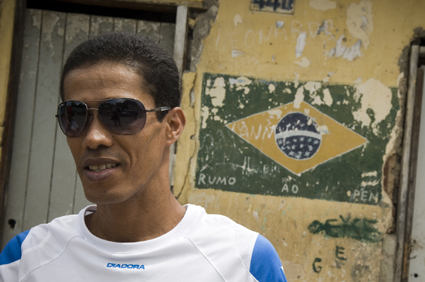
Ricardo Gomes Ferraz
The film about Kcal and his work was directed by Roberto Orazi and produced by Riccardo Neri, two Italian filmmakers who were in Recife researching a film they were making on the dark subject of the trade in human organs. Looking for someone to help them talk to people in the favela, they were directed to Kcal. After meeting and working with him and learning about his work with books, the library and with the children of the favela, they decided that they had to make a film about this wonderful story. (The film screened at the Rome Film Festival late last year and hopefully will be making its way to other festivals soon.)
the cinema club phenomenon
Michael O’Rourke was in Recife representing the Australian Council of Film Societies, of which he is vice-president. Film societies in Australia have a long and interesting history, but they are currently in decline, and the Council is urgently looking at both this decline and the role of the council, with the aim of re-invigorating both firmly in its sights. O’Rourke found much in his five days in Brazil to encourage him and, through him, the council; the international film society scene is amazingly rich, varied and active, with much more happening in many countries round the world than in Australia.
A film society is a membership-based organisation where people watch screenings of films not shown in mainstream cinemas. (In Spain they are known as cineclubs and in Germany as filmclubs, names that are increasing in popularity around the world.) Such organisations, usually with an educational as well as a screen cultural aim, work to introduce new audiences to varied audiovisual work through a member-curated program of screenings, usually supported by well-researched information sheets and even essays on the films shown. A common feature of most screenings is an introduction to the film and a post-screening discussion; a healthy debate on both style and content is seen as important. Film societies in most countries are organised into federations, councils, collectives, or local networks, and these national bodies can be members of the IFFS, which uses its rich and multi-lingual website and its regular publications to maintain a free flow of information throughout the film society world. (Interestingly, the IFFS is currently setting up an archive in which to collect and preserve all the documentation produced by its members; it will be, as retiring Secretary General Golan Rabbany Biplob said, “the right place where any researcher can get sufficient input to study the world film society movement.”)
a united effort
Last December the Brazilian government provided some outstanding hospitality to allow both the world conference on film societies and the general assembly of the IFFS to take place in Recife over five days, with participants coming from all around the world to report on their current activities and to plan for the future of worldwide “cineclubism.” This was the first time in 25 years that such a get-together was held in Latin America, where the film society movement seems to be doing well. The Brazilian government, on behalf of the Brazilian Federation, covered travel expenses and accommodation for many of those in attendance; Michael O’Rourke was particularly impressed by the fact that the national body from Norway paid the membership fees for the newly formed film society in Kabul so they could send a representative.
The five days saw a packed program in which reports from state and local film societies, from national bodies, and from various working groups were interspersed with panel discussions on relevant issues, including a debate on the role of film societies in the 21st century, and on research on film societies, their origins and publications, while social events and screenings lightened the more formal but necessary business of conference and AGM.
film clubs for the young
It was a report from Denmark on its very successful film club model for children and teenagers that particularly enthused O’Rourke. It’s a model that has its roots back in the 1950s, when teachers decided to show films to their students on a regular basis, while in the 1980s a law was introduced that required 25 percent of national film production be set aside for children’s and adolescent films. Now most young Danes belong to film clubs, where they have regular screenings of high quality films, acquiring a habit of watching films within their community and in circumstances that encourage both a critical standpoint and lively discussion, and gaining an insight into both the issues covered in the film but also in the way cinema works. While Australia does have some local or regional activities that encourage children’s film-going and critical evaluation (such as Queensland’s Cine Sparks), there’s nothing on an organised national level.
film club australia?
Back from the meeting excited and invigorated by much of the film society activity he heard about in other countries, O’Rourke is looking forward to the challenges posed in Australia, where the film society movement is now going through a difficult period, with many longstanding groups faced with aging and declining membership and finding it hard to connect with new audiences. The attractions provided by excellent equipment and the rich and growing supply of material on DVD is enhancing home viewing, while many in the younger generations seem to have different interests and other ways of watching screen material. It’s not all doom and gloom; there are some film societies doing really well, with large and active memberships and programs. What’s needed is some way of making this much more widespread, and to this end Michael O’Rourke feels positive about increasing Australia’s connection with the burgeoning world of film societies.
RealTime issue #101 Feb-March 2011 pg. 31
© Tina Kaufman; for permission to reproduce apply to realtime@realtimearts.net
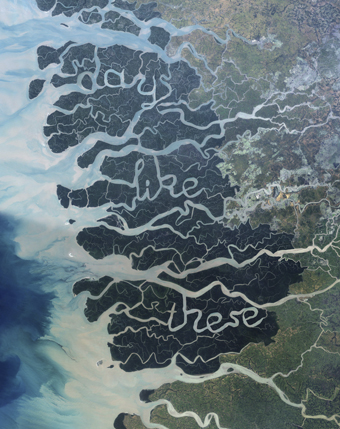
Incompatible Elements (video still), Josephine Starrs & Leon Cmielewski
courtesy the artists
Incompatible Elements (video still), Josephine Starrs & Leon Cmielewski
HAVING BEEN BASED IN THE UK SINCE 2007, IT IS GLARINGLY OBVIOUS TO ME HOW INVISIBLE AUSTRALIAN VISUAL ARTISTS CAN BE ON THE HIGHLY COMPETITIVE INTERNATIONAL CIRCUIT. THEY ARE RARELY SEEN IN EUROPEAN BIENNIALS AND SURVEY EXHIBITIONS, LET ALONE IN SOLO EXHIBITIONS. SOME AUSTRALIAN GALLERISTS TAKE THEIR ARTISTS TO INTERNATIONAL FAIRS, THE AUSTRALIA COUNCIL OFFERS SUPPORT IN VARYING DEGREES AND MAGAZINES LIKE ARTLINK ARE MAKING THEIR WAY ONTO THE SHELVES OF UK AND EUROPEAN BOOKSHOPS. HOWEVER, AUSTRALIANS WORKING IN COMPUTER-GENERATED AND RELATED FORMS HAVE CONSISTENTLY ACHIEVED PROMINENCE ON THE EUROPEAN MEDIA ARTS CIRCUIT AND BEYOND.
Since the early 1990s Australian artists have been highly visible in this arena and have made a vital contribution to the growth of international media arts practice. With the continued vitality and expansion of the sector evident in events such as Ars Electronica in Austria, Transmediale in Germany and the nomadic International Symposium on Electronic Art (ISEA, scheduled for Sydney in 2013), the media arts scene has proved itself a resilient and relevant forum for audiences to experience media arts practice.
Not only are Australian artists prominent in these exhibitions but their excellence in the field is acknowledged, especially through the series of prizes awarded by Ars Electronica. In 2010 Melbourne-based Stelarc was awarded the highest prize at Ars Electronica, the Golden Nica (for Hybrid Art) and Perth-based SymbioticA won the same prize when it was first awarded in 2007. Awards of Distinction at Ars Electronica have also been presented in 2005 to Brisbane based Keith Armstrong, Sydney based Joyce Hinterding & David Haines in 2009 and Josephine Starrs & Leon Cmielewski in 2007. Melbourne Oribotics artist Matthew Gardiner was an Artist in Residence at Ars Electronica Futurelab in 2010 with the support of Novamedia and the Australia Council for the Arts, and returns there this year.
This Australian presence on the media art scene has developed over 20 years, the outcome of hard work from artists, support and profile building by the Australia Council along with Australian curators and agencies. Individuals such as Linda Wallace in the 1990s through her company Machine Hunger took the work of Australian artists to Asia and Europe and Antoaneta Ivanova with Novamedia established an international network for exhibiting media art in the 2000s. Experimenta has curated several exhibitions that have toured internationally and ANAT has supported artists to present work through its (now defunct) Conference and Workshop Fund. Kim Machan through MAAP (Multimedia Art Asia Pacific) has also built significant collaborative exhibition opportunities in Asia and presented major exhibitions in Singapore and Beijing.
Entrepreneurial Australian curators continue to create opportunities for Australian media artists overseas and in 2010 Dream Worlds: Australian Moving Image, curated by Melinda Rackham and produced by Michael Yuen (see p10) showed eight artworks on a 27-metre public screen in Beijing’s Sanlitun Village. This large screen was apparently very hard to miss and caught the eye of the local press: “Few in China are aware that as well as strange animals and a Mandarin-speaking former Prime Minister, Australia sports a thriving new media art scene comprising some of the world’s most innovative artists” (www.thebeijinger.com).
This concerted effort has enabled artists to build networks and relationships (particularly in Asia and Europe) that continue to yield invitations to exhibit and participate in other opportunities such as conferences and residencies. While organisations like MAAP and Novamedia are not as active in the current climate, their efforts have paid off through a continued presence of Australian artists in the international spotlight.
For established artists such as Josephine Starrs and Leon Cmielewski, exhibiting overseas “is important to us because of the opportunity it gives to engage with a wider audience, and from our experience, unexpected opportunities often arise from participating in an international exhibition or art festival.” Starrs and Cmielewski’s work is well regarded. They have shown at the 2008 Guangzhou Triennial and in 2011 present at the Sydney/San Francisco Biennale and the Auckland Arts Festival. They have also secured opportunities for R&D through residencies and in 2009 were the first Australian artists in residence at the Ars Electronica Future Lab.
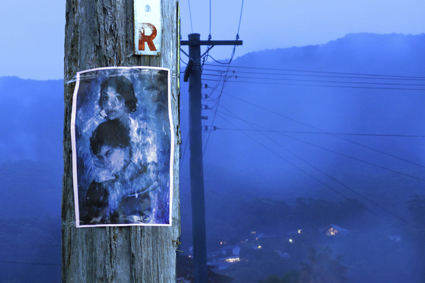
Elegy for Young Lovers, Young Vic and English National Opera
image Lynette Wallworth
Elegy for Young Lovers, Young Vic and English National Opera
An artist achieving considerable success overseas is Lynette Wallworth. It is not unrealistic to say that her profile is perhaps more significant outside of Australia than it is at home, although her solo exhibition at Adelaide’s Samstag Museum in 2009 in tandem with the Adelaide Film Festival gained considerable national attention. She is represented by UK based Forma, one of Europe’s leading production agencies for interdisciplinary contemporary art. With the support of Forma, Wallworth is developing complex and engaging media installations that are shown in a range of venues. Over the last few years, her work has been commissioned and exhibited at the Lincoln Centre, NYC; New Frontier at Sundance Film Festival; Vienna Festival and Aix en Provence Festival. In 2010 she developed a 40-minute video piece, Kafka Fragments, in the Netherlands and in the same year an interactive video for English National Opera’s Elegy for Young Lovers directed by Fiona Shaw.
Wallworth says that these opportunities “offer a way of developing a different relationship with audience and I am interested in that. The importance for me is in staying fluid enough to go where the space is opening up…Right now for me that is definitely film festivals as they make space for moving image work and for artist film makers.”
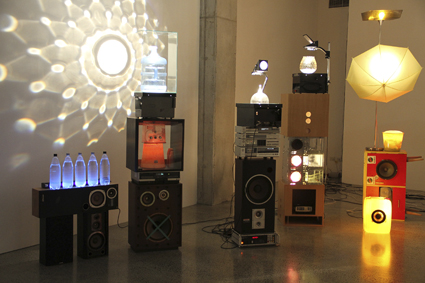
Wade Marynowsky, Bricolage Disco, 2010, ST PAUL St Gallery, Auckland, New Zeland
photo courtesy the artist
Wade Marynowsky, Bricolage Disco, 2010, ST PAUL St Gallery, Auckland, New Zeland
Emerging Australian artists are also starting to find their feet in the international arena. Sydney based Wade Marynowsky was recently included in the 2010 Mediations Biennale in Poznan, Poland and also in 2010 showed his installation Bricolage Disco at ST PAUL St Gallery in Auckland. He has commented that these opportunities have arisen from meeting international curators who have visited Australia, with introductions through the likes of Fiona Winning and Mike Leggett. Inclusion in international exhibitions opens new doors and exposes younger artists to the work of important international figures. Marynowksy says about Poznan, “it was important to show the work overseas to access new audiences and for professional development; it was also my first experience of exhibiting in an international biennale. This was exciting for me as I was shown amongst some media art big names such as Ken Feingold, Luc Courchesne and Eduardo Kac.”
All the artists mentioned here have significant international profiles or are starting to embark on international careers, but they are not the only media artists regularly exhibiting overseas. Jon McCormack, Christian Thompson, Alex Davies, Nigel Helyer, Daniel Crooks, Kate Richards, Mari Velonaki, Craig Walsh and Troy Innocent all enjoy success and continue to build their profiles through international connections.
These artists have spearheaded the forward guard of Australian artists on the international stage. They demonstrate that despite distance, limited resources and a certain European snobbery directed at the ‘antipodes’ that Australian art can thrive beyond our shores. There are certainly more opportunities to be explored, but in the meantime the forging of networks and opportunities by innovative practitioners might possibly provide inspiration for the Australian visual arts sector to embark on new directions into new places to reach new audiences.
RealTime issue #101 Feb-March 2011 pg. 32
© Julianne Pierce; for permission to reproduce apply to realtime@realtimearts.net
{$slideshow} THE IMAGE OF TIME, A RETROSPECTIVE OF THE WORK OF SENIOR BRITISH ARTIST MALCOLM LE GRICE, INITIATED BY NEW ZEALAND CURATOR MARK WILLIAMS AND REALISED IN BRISBANE BY OTHERFILM, SHONE A LIGHT ON A QUEENSLAND SCREEN CULTURAL LANDSCAPE WHOSE CONTOURS ARE BEING REMAPPED. OVER TWO NIGHTS AT THE INSTITUTE OF MODERN ART AND THE TRIBAL THEATRE, THE LE GRICE PROGRAM WAS SUPPORTED BY AN INSTITUTION AT THE EPICENTRE OF THE CURRENT SHIFTS IN SCREEN CULTURE: THE BRISBANE INTERNATIONAL FILM FESTIVAL (BIFF).
brisbane international film festival
There have been a few changes at BIFF lately, just like there’s been a bit of rain in Queensland. Huw Walmsley-Evans discusses the organisational purge at the city’s flagship screen event in the 57th edition of Senses of Cinema (which, like RealTime’s OnScreen has not been funded by Screen Australia for 2011). In 2009, BIFF was seen as “a diseased limb” of the troubled state film financing body, the Pacific Film and Television Commission, and so, “when the PFTC was purged, the blameless BIFF administration was also swept away.” The loss of director Anne Demy-Geroe, whose 17-year stewardship of the festival saw it foster and grow a deep appreciation for grown-up film in Brisbane, was felt in 2010. Walmsley-Evans pays tribute to the artful layering of Demy-Geroe’s “Russian-doll”-like programs, with their thematic and aesthetic sub-sections, “digressions, riffs, fully fledged retrospectives, tributes and established areas of specialist interests,” and notes with some chagrin the etiolated Asia-Pacific and Middle Eastern programming.
trash video
Digressions, riffs, retros, tributes and specialist interests were a casualty of another 2010 demise, that of Trash Video, which closed the doors of its West End bunker for the last time in August. More than just an independent video store, Trash, like BIFF, acted as a public gateway to the cinematic state of mind. Presided over by Andrew ‘Stumpy’ Leavold, Trash offered an absorbing education in the unfamiliar, unsettling and sometimes unsanitary worlds of B-movies and cult cinema. While all film programmers are people of passion, there are few with Stumpy’s almost messianic exaltation of the most mutant, malformed, only-a-mother-could-love them films. The organised chaos of the physical Trash universe may be gone, but Stumpy’s unflagging devotion to ‘other cinema’ lives on with other unmistakeably ‘Trash’ projects. At BIFF, he introduced the Philippines exploitation cinema overview, Machete Maidens Unleashed, fronted by Mark Hartley (who directed the exploitation cinema doco, 2009’s Not Quite Hollywood). As Trash Video Film Club patrons may recall, the words “Filipino midget private eye” remain inextricably associated with the store and the man whose Search for Weng Weng remains legend.
Machete Maidens’ BIFF premiere, as part of the Shock Corridor section of cult, grindhouse and exploitation cinema (which, Walmsley-Evans notes, is “the one recognisable holdover from Anne Demy-Geroe’s programming”) coincided with the festival’s presentation of the Malcolm Le Grice program at the Institute of Modern Art. IMA and BIFF have partnered memorably before, with the tour de force Shoot Shoot Shoot program of British avant-garde film curated by Mark Webber in 2002, and with film artist Guy Sherwin’s performance program in 2008.
malcolm le grice
The Malcolm Le Grice program lent first-hand substance to arguments that this kind of work finds a natural home in the white cube; certainly, in comparison to the black box of the theatre, the gallery space seems to more readily adapt to the aesthetic and material challenges of staging hybrid experimental work. At the IMA, Le Grice’s 40-year career was surveyed in installation, film and video screenings and performance. At the artist’s suggestion, the meta-cinematic work After Leonardo (1974) was installed in multi-screen across the smooth white interior of the gallery, allowing for a wall-to-ceiling immersion in the work’s play with film frames/video frames. The playful deconstruction of art history is a marker of the filmmaker’s modernist pedigree and, as the artist explained in his affable unscripted address to the crowd, also a way to pose questions about the relations between cinema, experimental film and painting.
As a film festival venue, the gallery space afforded critical intimacy to the audience with the projected works and the artist himself. Nowhere was this more evident than in Horror Film 1. For many in the capacity crowd, the chance to finally experience Le Grice’s legendary 1971 multi-projector film-performance, re-enacted in all its kaleidoscopic, confrontational glory, was a high point in the cinematic year. In contrast, something of the sense of critical liveness of the second expanded cinema performance, 1972’s Threshold, was lost at the conclusion of the second program the following night. This three-projector performance, at the more traditional cinematic venue, the Tribal Theatre, nonetheless provided insight into the interplay between projection processes and human vision, showing how, as Le Grice explained, “film is, at each stage, raw material for new transformation.” The program illuminated how sensitive we have all become to the specificities of space—physical, phenomenological, social and institutional—in the experience of moving image art.
gallery of modern art
Concomitant with the unfolding of the first new-regime BIFF program, the Gallery of Modern Art screened yet another extraordinary program. Pier Paolo Pasolini: We Are All In Danger was precisely the kind of exceptional, world-class retrospective program Brisbanites have come to expect from the programming powerhouse of Kathryn Weir and her team. As other institutions have been dismantled or reformed, the Cinémathèque has continued to amaze and exceed expectations, and is consistently rewarded with growing audiences at even the most demanding films. It is clear that the strategy of astutely curated ‘blockbuster’ seasons with the power to partly subsidise or offset the programming of contemplative films from all corners of the globe is an ideal model. Audiences are fortunate—and relieved—that the Cinémathèque, despite closure for some weeks following the flood, appears to have survived with its enthusiasm for adventurous programming undampened.
In addition to exciting imaginations with the BIFF show, IMA brought the extravagant Nollywood metacinema of photographer Pieter Hugo, and the installed audiovisual mayhem of Christian Marclay to further expand Brisbane’s moving image experience and develop the relations between visual art and screen culture. The year also saw more growth and renewal in Brisbane’s independent sector with the promising signs heralded by the newborn Brisbane Underground Film Festival and flourishing artist-run initiative scene, showing that amidst strife and cataclysm, new conditions of possibility are always emerging.
Malcolm Le Grice, The image of Time, a joint project with OtherFilm, Institute of Modern Art, New Zealand Film Archive and Screen Queensland, Brisbane Film Festival, Nov 4-14, 2010
RealTime issue #101 Feb-March 2011 pg. 35
© Otherfilm; for permission to reproduce apply to realtime@realtimearts.net

Ahil Ratnamohan, Sweat, Branch Nebula
photo Heidrun Löhr
Ahil Ratnamohan, Sweat, Branch Nebula
DANCE MASSIVE IS AVOIDING THE F-WORD. ACROSS ITS PRINT AND PUBLICITY, THE BIENNIAL PRESENTATION OF A CONCENTRATION OF CONTEMPORARY DANCE IN MELBOURNE IS CALLING ITSELF A “COLLECTION.” A “PROGRAM,” AN “INITIATIVE.”
To discuss “the Massive” I met with Steven Richardson, Director of Arts House in Melbourne. Richardson was instrumental in founding Dance Massive, urging the Australia Council following his time on the Dance Board to consider a concentration of dance programming both to attract international attention to new work and to provide a place for the sector to meet and share experiences at a national level. Arts House, a complex of venues run by City of Melbourne, plays a central coordinating role for the Dance Massive program, although Richardson admits that, “surrendering half of our six month program to make this work is not ideal.”
Without an artistic director for Dance Massive, Richardson tells me, there is no festival infrastructure and all programming is supported by existing State and Federal resources allocated to the three Melbourne venues where the work is presented. “There hasn’t been the funding to create a central framework. When the idea first came up, we considered trying to create a national program by coordinating venues around the country. It quickly became apparent that this was going to be impossible. It would take 15 years for us to find the same two weeks across every dance venue nationally. So we decided to start in our own backyard.”
The coincidence of Malthouse Director Michael Kantor and producer Stephen Armstrong investing in contemporary dance and physical theatre programming and the energy of David Tyndall as the new(ish) Director of Dancehouse created sufficient momentum in Melbourne for the project to take off in 2009. “It’s hard to apologise for the focus on Melbourne,” Richardson says, “There is arguably the healthiest ecology for dance here, with a concentration of institutions, companies like Chunky Move and lots of independent artists and audiences.”
In its first edition Dance Massive programmed 14 works from across Australia across the three venues. The program was well attended and received positive feedback and critical acclaim. Dance Massive was also pronounced a success for the way in which it raised the profile of dance in the media and created a meeting point for artists and companies to see each others’ work and network during a concentrated period. The same venues have joined to create Dance Massive 2011, and several of those artists included in the original program are making a return appearance. “We each have our own curatorial framework, our own audiences and remits regarding programming,” says Richardson. “but there has been some very interesting cross-fertilisation between the venues since the first Massive,” he adds. “There has been surprisingly little tripping over each other too; we are all interested in contemporary work, but our curatorial approaches are slightly different and we have worked hard to ensure that the work falls where it needs to fall.”
Richardson is referring to the fact that the program is broad, both in terms of its definition of dance (including a physical theatre company such as Branch Nebula), its inclusion of generations of makers, (from Trevor Patrick to Luke George) and its accessibility (from the popular dance theatre work of Force Majeure and Shaun Parker to the relatively obscure independent work of Deanne Butterworth and Matthew Day).

Dance Marathon, bluemouth inc
photo Gordon Hawkins
Dance Marathon, bluemouth inc
Whilst the first Massive included only Australians, there are artists from the UK and Canada in the 2011 program. “The international work is directly linked to Australian artists,” Richardson explains. “The bluemouth piece from Canada, Dance Marathon, is populated by local artists because it is built upon local participation. It was an important agenda item for Arts House to include a participatory element this year and the Dance Marathon project has been receiving incredible reviews wherever it plays around the world.” On the other hand, Billy Cowie, from the UK, has made his piece around an extraordinary Australian performer.

Now, Now, Now, Luke George
photo Jeff Busby
Now, Now, Now, Luke George
Richardson acknowledges that certain States and Territories are not represented in the final program but is adamant that Dance Massive is curated through the call for applications combined with the practical resources of the venues involved. “We would need a lot more money to support more companies to travel from interstate.” Richardson is aware of the absence of Indigenous work in the program. “It is not missing through any lack of trying,” he states,” The call is a rather brutal process, which can only consider the work that is out there and ready to go at the right time. Although we did get over sixty applications from the call this year, we also went out to our networks as presenters in order to find the best possible work.”
Richardson goes on to talk about the National Dance Forum associated with Dance Massive as a place where conversations around Indigenous and regional work can take place. “We have been able to include more spaces-in-between this year,” he says and cites the two international residencies and the dance on film program as initiatives that seek to address the aspiration of all three venues to create a place where dance artists and enthusiasts can meet. The National Dance Forum, led by Ausdance and the Australia Council and taking place over a long weekend during Dance Massive, will involve international choreographers such as Pichet Klunchen from Thailand with national dance artists in a series of forums, conversations and provocations designed to inspire art form development, in a similar fashion to that achieved during the National Theatre Forum in 2010.
Arts House will host the 2011 Tanja Liedtke Foundation Fellow, Katarzyna Sitarz, during Dance Massive. Sitarz will direct a residency at Arts House that will involve local independent artists and will take part in a new collaborative project directed by Lucy Guerin. Also during Dance Massive, the Australia Council’s IETM program, directed by David Pledger in Brussels, will send Norwegian choreographer Heine Avdal of deepblue company to undertake a residency and build relationships with Australian dance artists.
The venues and companies worked together to create a hit list of international presenters to invite to Dance Massive. Around a dozen high profile programmers from Europe, Asia and the US will attend. Dancehouse will also target a handful of French presenters in a special initiative. “It is important for the work to be shown in full, in the best possible theatrical conditions,’ Richardson says. “We also try to attract national and regional presenters,” he continues, “Although that is never easy. Last time we had half a dozen regional presenters attend and this year we hope for more.”
Richardson is optimistic about the impact of the 2011 program and is particularly looking forward to the two new productions by Chunky Move as well as the site-specific presentation, Drift, by Anthony Hamilton and the sound installation by composers Madeleine Flynn and Tim Humphrey. “I am hoping some of these projects will turn a few heads about what the nature of dance engagement can be,” he says.
Despite his enthusiasm, Steven Richardson is sanguine about the future of Dance Massive with no illusions about the third edition planned for 2013 being a shoo-in. “Once we get through March, we will start thinking about what we want Dance Massive to be,” he says. “Perhaps there is another model out there; something more nimble or more relevant to current practice.” Dance Massive is not a festival, or a showcase, that much is clear, but what it is and what it could be, seems to be tantalisingly up for grabs.
Throughout Dance Massive, RealTime reviews and interviews will appear online at www.realtimearts.net.
The considerable Dance Massive program includes works by Chunky Move, The Shaun Parker Project, Narelle Benjamin, Michelle Heaven, Helen Herbertson, Balletlab, Deanne Butterworth, Matthew Day, Antony Hamilton, Force Majeure, Trevor Patrick, Luke George, Branch Nebula, overseas guests Billy Cowie, John Jasperse Company and bluemouth inc, and the welcome return to Australia from France of Rosalind Crisp and Andrew Morrish.
Dance Massive: partners Arts House, Malthouse Theatre, Dancehouse; Melbourne, March 15-27; download the program at http://dancemassive. com.au
RealTime issue #101 Feb-March 2011 pg. 36
© Keith Gallasch; for permission to reproduce apply to realtime@realtimearts.net





























 Courtesy of Madman Entertainment and in celebration of our 101st edition, RealTime is offering a lucky reader a ravishing cinematic giveaway: a 9-DVD box set of the great films of the 1950s master of aesthetically and socially incisive Hollywood melodramas, Douglas Sirk.
Courtesy of Madman Entertainment and in celebration of our 101st edition, RealTime is offering a lucky reader a ravishing cinematic giveaway: a 9-DVD box set of the great films of the 1950s master of aesthetically and socially incisive Hollywood melodramas, Douglas Sirk.































































